Indochina, Domestic Scenes II, November 16th, 1931, Michel Nr. IND 150-183, Thirty-four values in nominals of 1/10C, 1/5C, 2/5C, 1/2C, 4/5C, 1C, 2C, 3C (two values), 4C (three values), 5C (two values), 6C, 7C, 8C, 9C, 10C (two values), 15C (two values) 18C, 20C, 21C, 22C, 25C (two values), 30C, 50C, 60C, 70C, 1P and 2P were issued in perforation 13.5:13 except the higher values from 50C up were perforated 13.5.
Here is the mint never hinged partial set (missing are 5C green, 9C, 10C ultramarine, 25C blue, 70C light-blue).
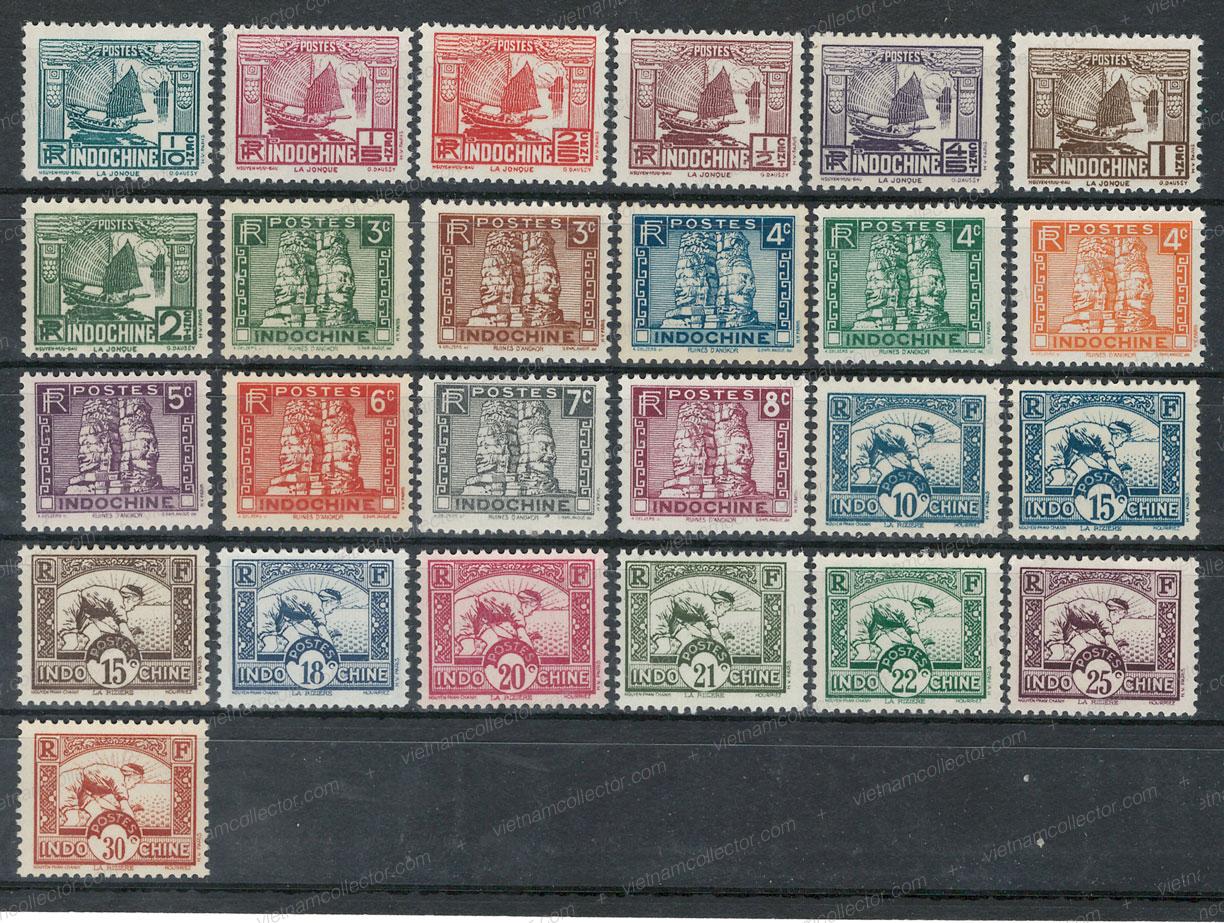
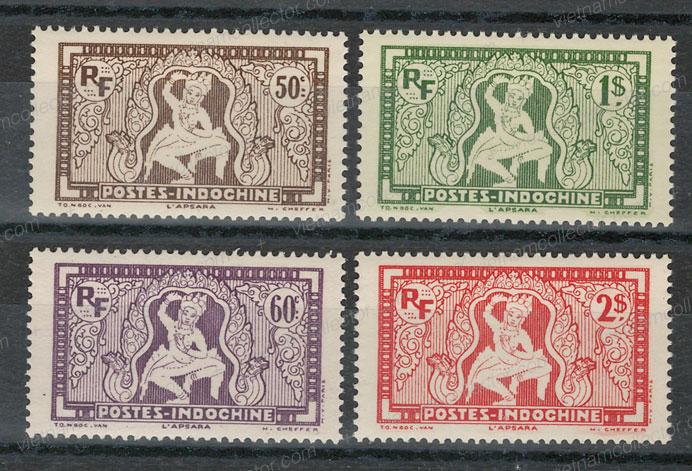
Partial m.h. sheets of the 1/1oC and 1/5C values.
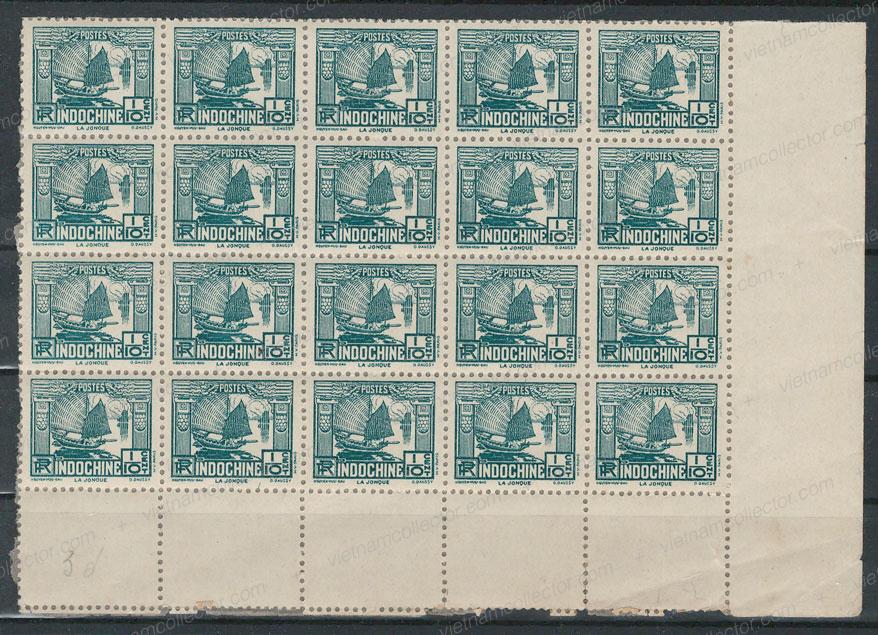
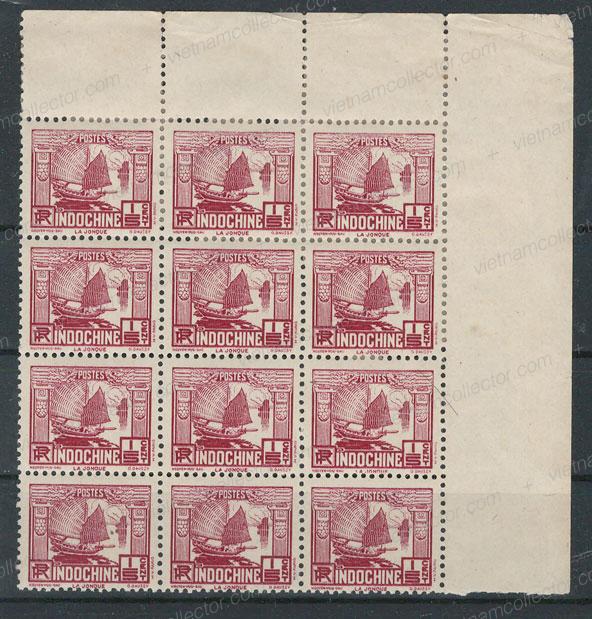
Complete never hinged pane of the 9C value (Hinge only on the selvage).
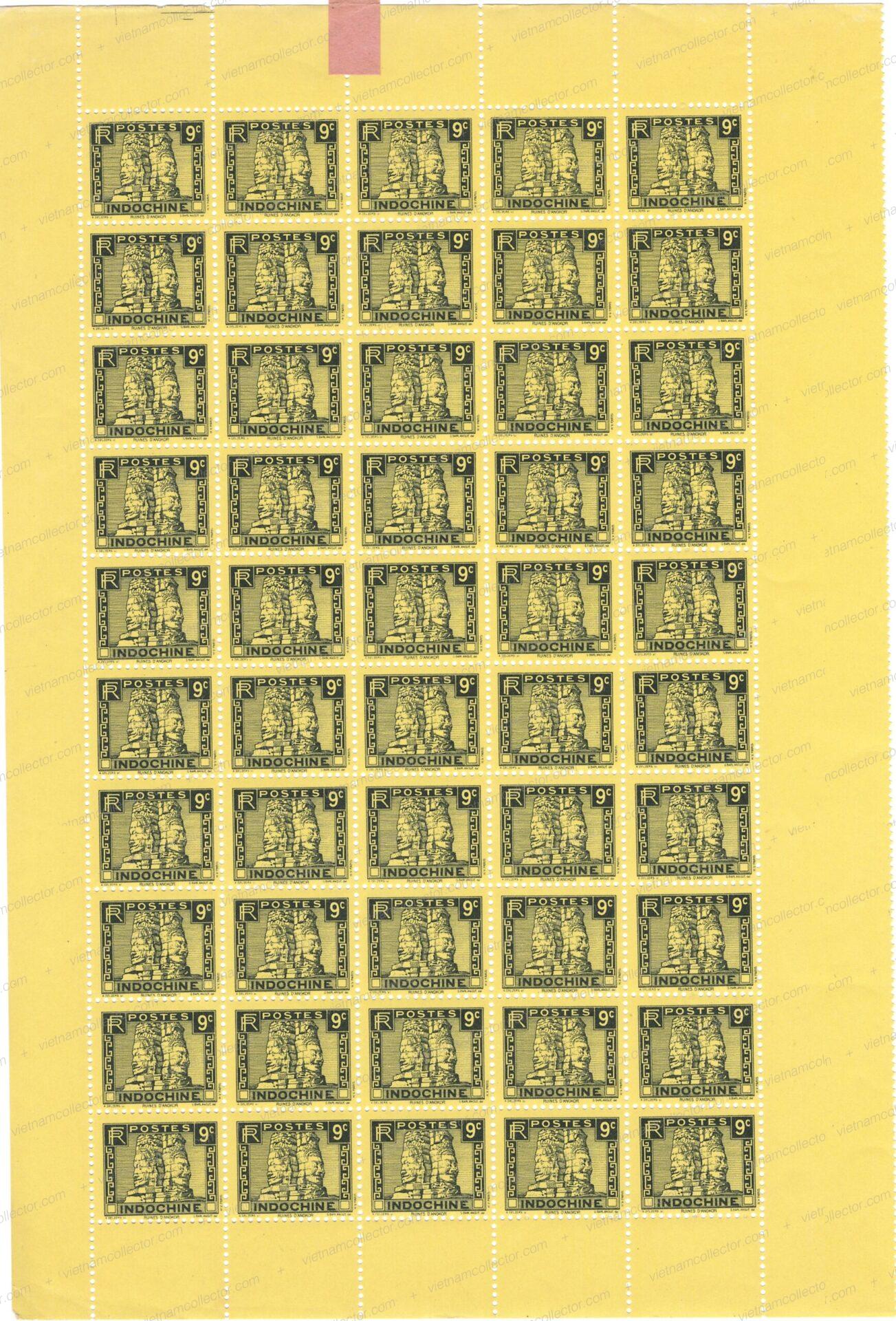
Partial postally used set.
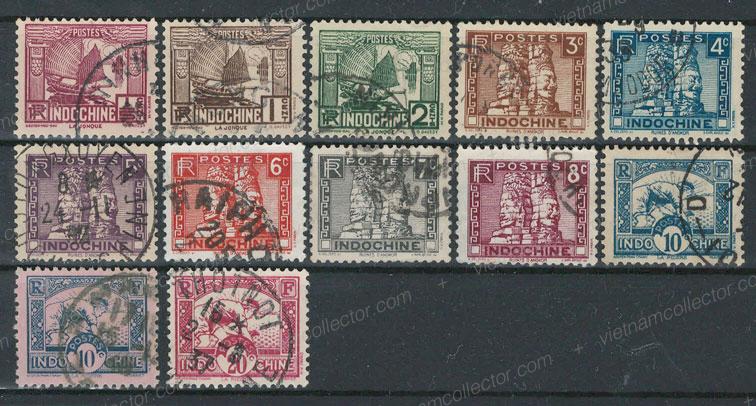
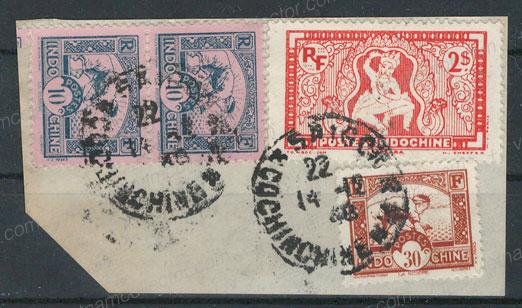

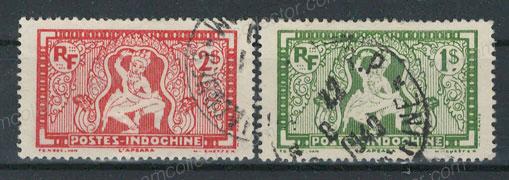
Cancelled blocks of four of the 1/10C, 2C and 20C values.

Partial sheet of the 2/5C stamp cancelled to order.
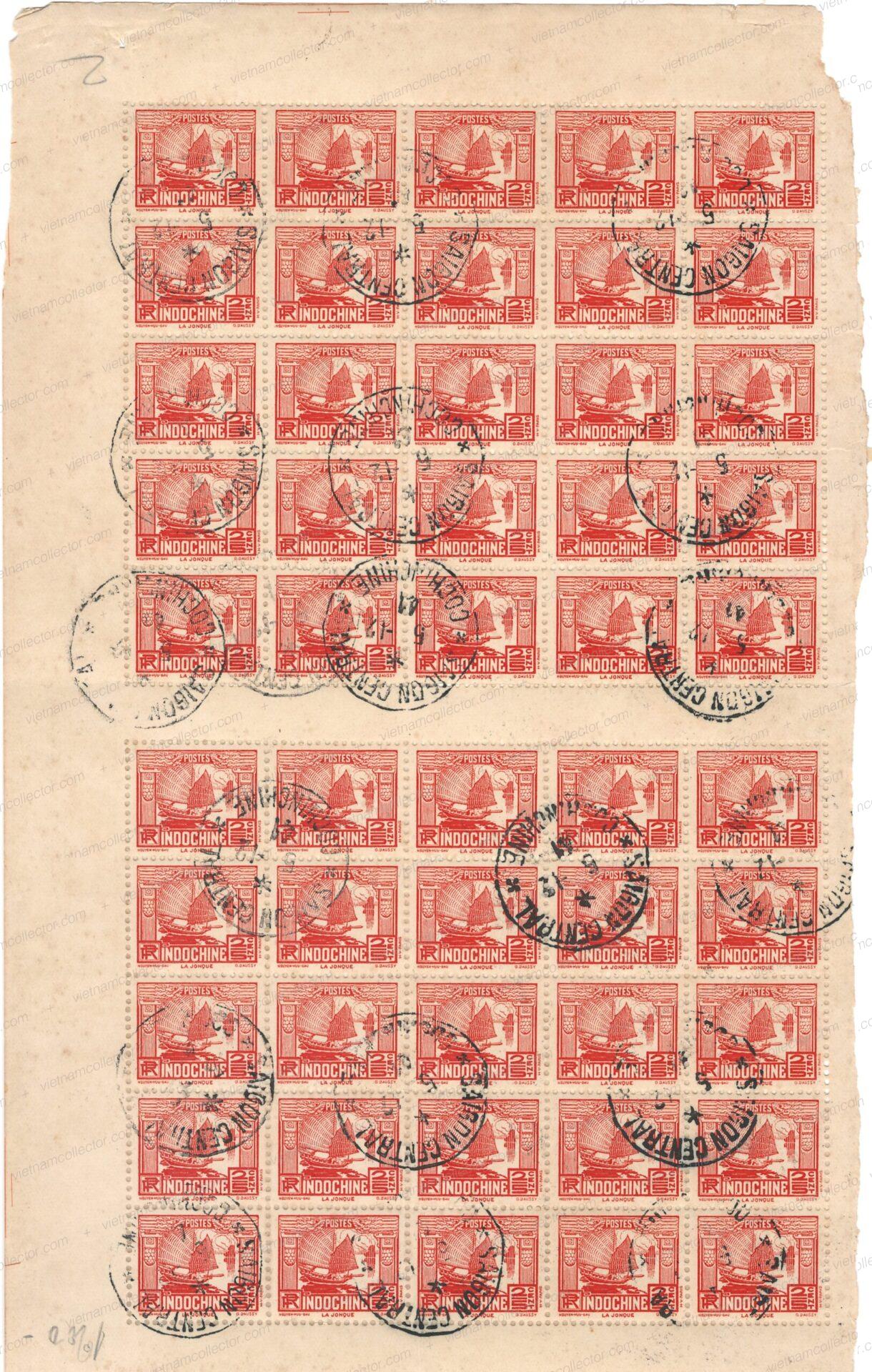
Postally used gutter-pair of the 1/5C stamp. These are very hard to find.
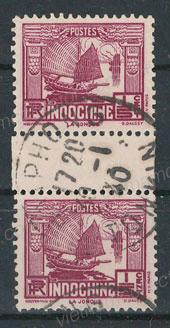
5C (lilac) stamp cancelled with a Paquebot boxed ship cancel.
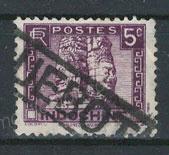
Rare complete postally used stamp booklet pane together with an additional franking of the $C Vietnamese Women
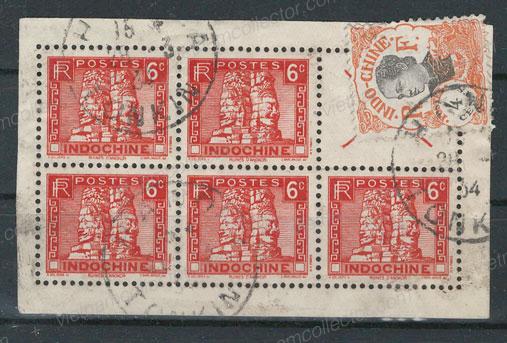
Perfins perforated by the Bank of Indochina in order to protect stamps from being abused or stolen from the office.
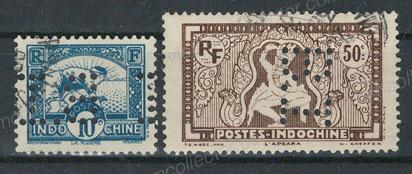
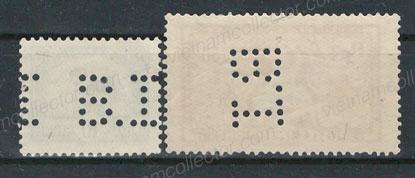
These stamp were not officially released imperforate, however, a small number of imperforate trial proofs have come to market. Here is an imperforate block of four of the 15C value (blue)
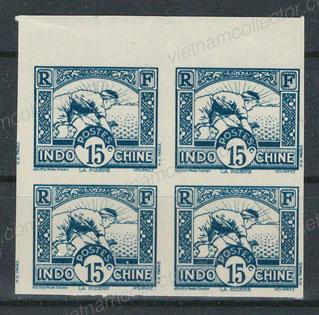
Mixed franking of the 1/10C (2), 1/5C (2), 2/5C (2), 1/2C (2) and 3C (2) paying an overall postage of 8.4C on a domestic letter sent within Hanoi. The stamps were cancelled with the special “Hanoi Congress Medical” cancel from November of 1938. Standard Hanoi arrival cancel on the reverse.
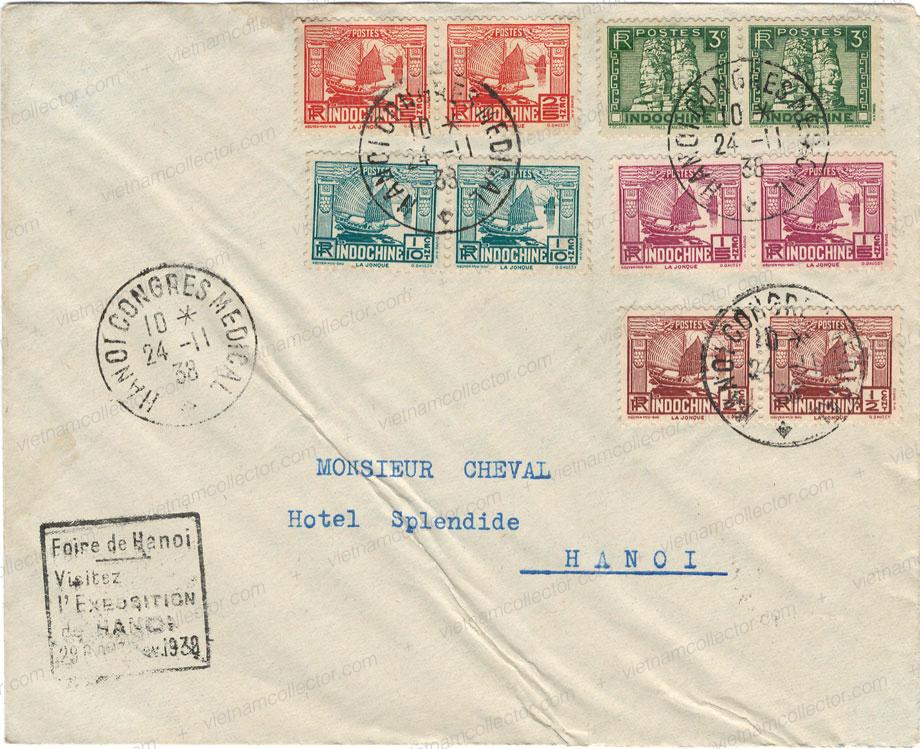
Mixed franking of the 1/10C (10), 1/5C (5), 2/5C (5), 1/2C (4), 3C and 7C stamps paying an overall postage of 16C on a large domestic letter sent by the Bank of Indochina in Dalat in September of 1940 to a branch in Hanoi. This was during World Was II which meant that the letter was subject to censure. However, the bank enjoyed special privileges that exempted it from such censure which was indicated by a red cachet struck in front that read “See de la Banque Privilege de L-Indochine, Exempt de Censure””. Hanoi arrival cancel on the reverse.
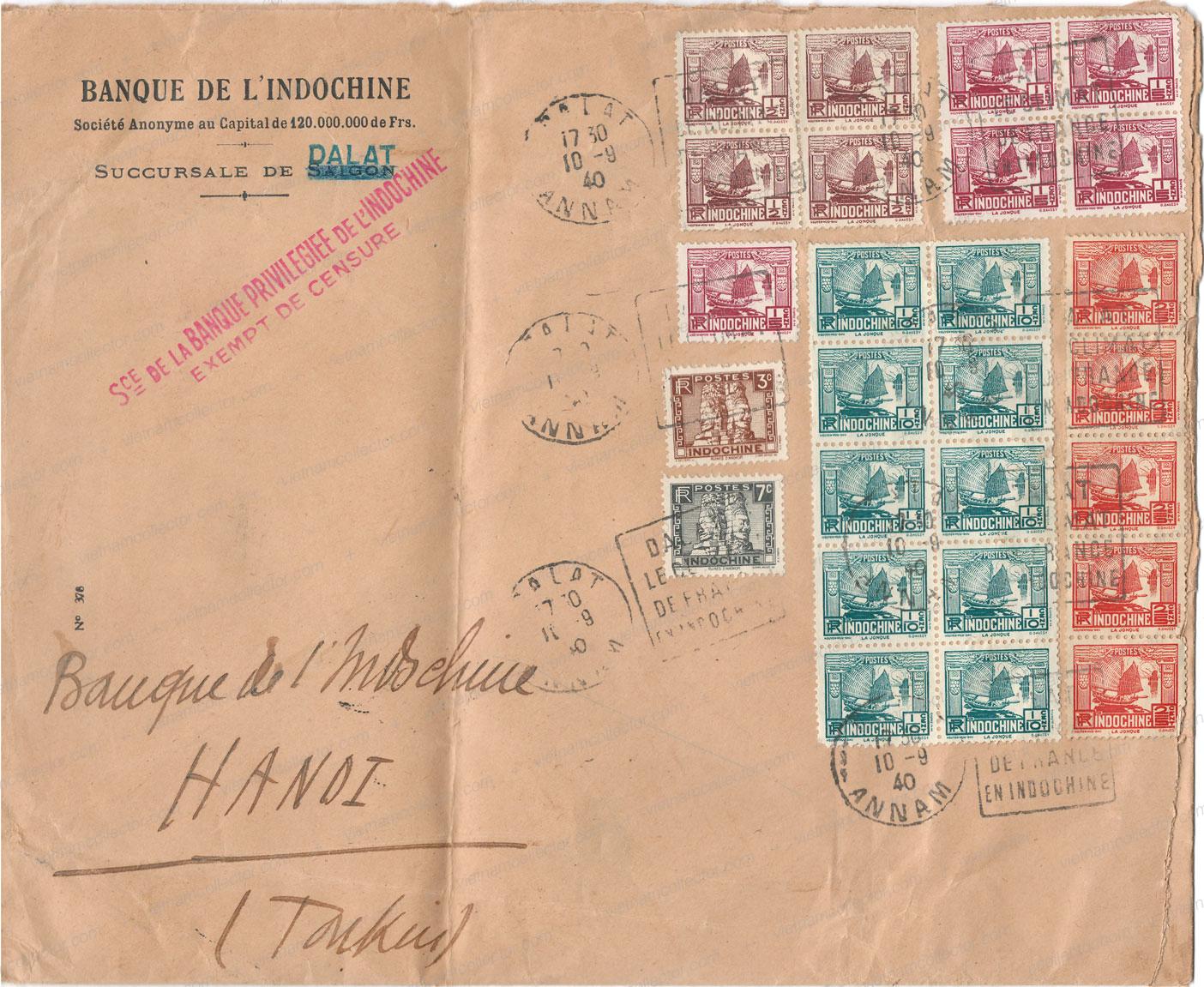
Mixed franking of the 37C Air Mail stamp together with the 1C Domestic Scenes II set paying an overall postage of 38C on a First Flight Cover inaugurating the flight Saigon to Hong Kong on October 5th, 1938. First Flight cachet on front.
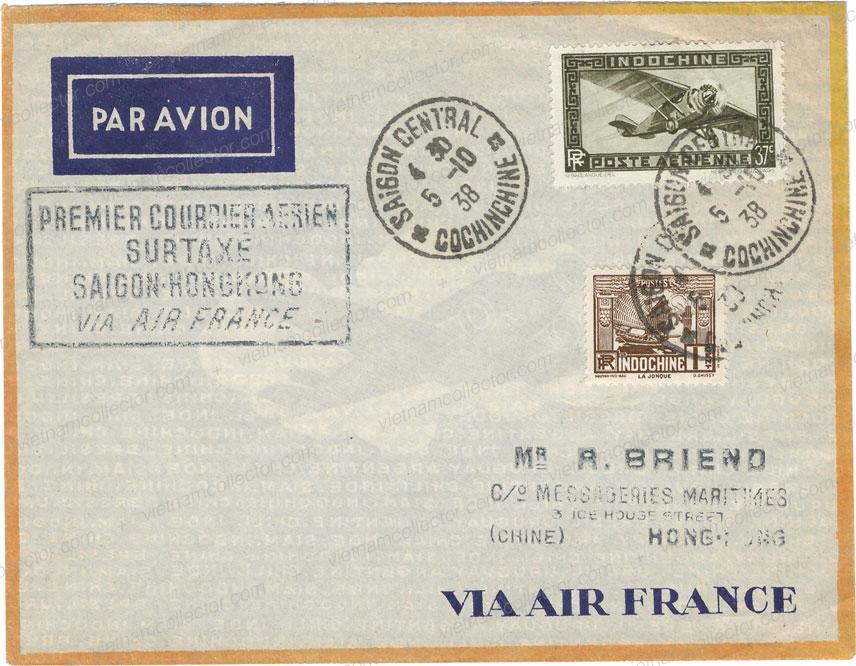
Very rare single franking of the 2C value on a printed matter mailing from April of 1934 sent by an auto dealer to a customer in Saigon. Most of these printed matter letters were simply tossed out.
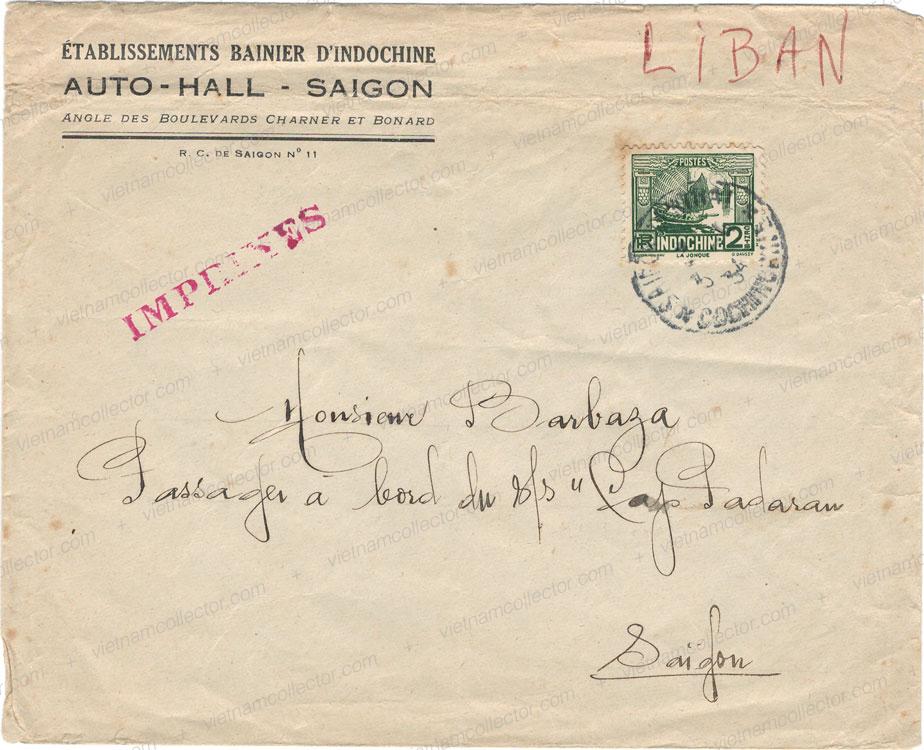
Single franking of the 2C value on a post card featuring Cambodian natives sent from Saigon in March of 1935 to France. The card was transported by the Paquebot Nr 1. that ran the route Kobe-Marseille as indicated by the octagonal ship cancel.
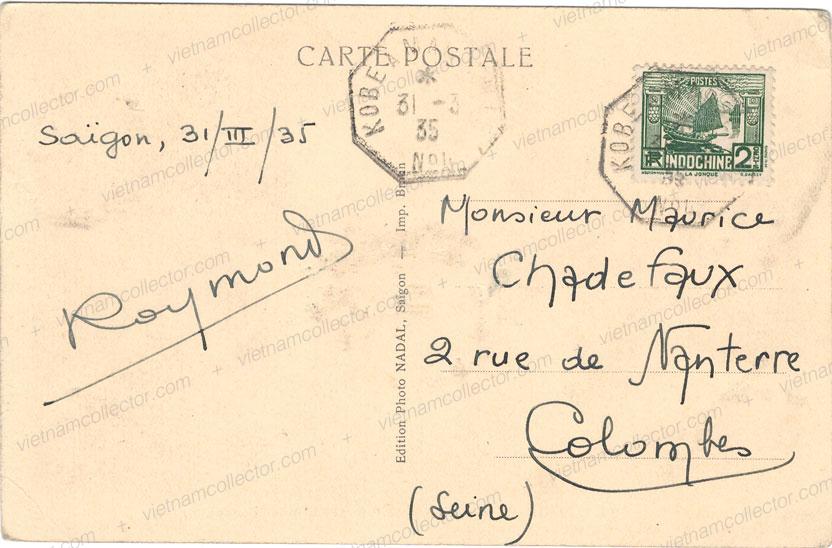
Post card of the paquebot “Viet-Nam”
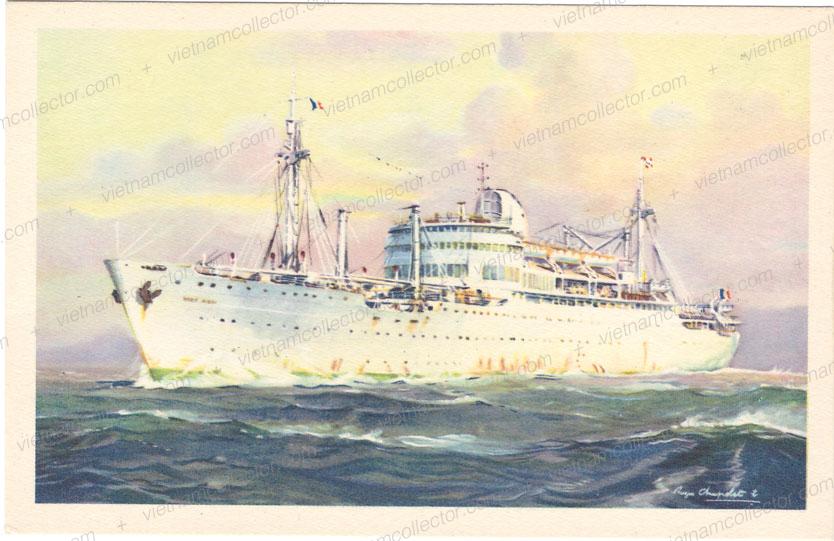
Multiple franking of the 2C value (2) paying an overall postage of 4C on an international postcard sent from Siem Reap, Cambodia to Frances in November of 1939.
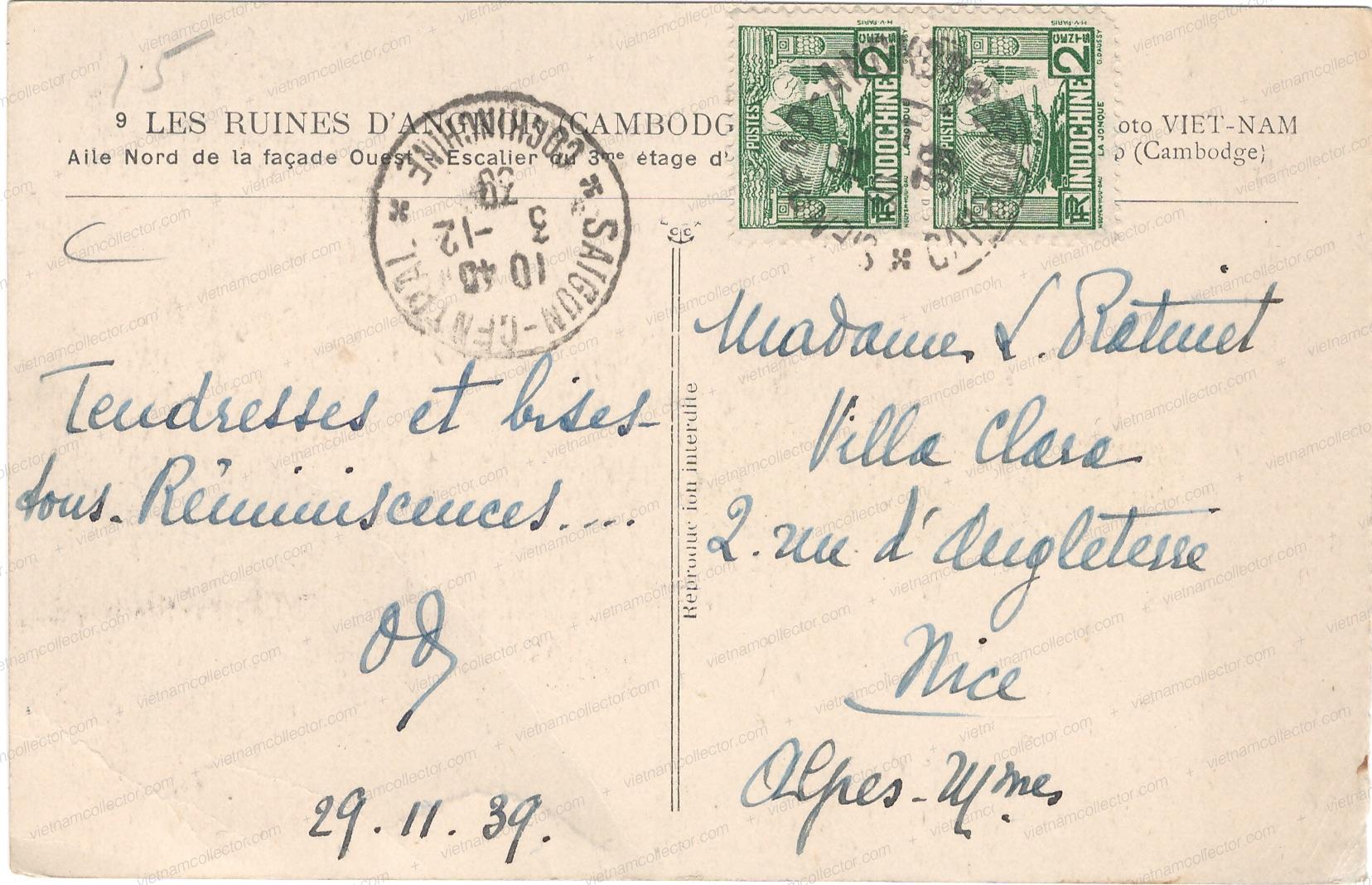
Multiple franking of the 2C stamp (3) on a domestic letter paying an overall postage of 6C and sent in September of 1943 from Ben Tre to Hanoi. This was during the Japanese occupation, a period in which domestic mail volume was very low. Hanoi arrival cancels on the reverse.
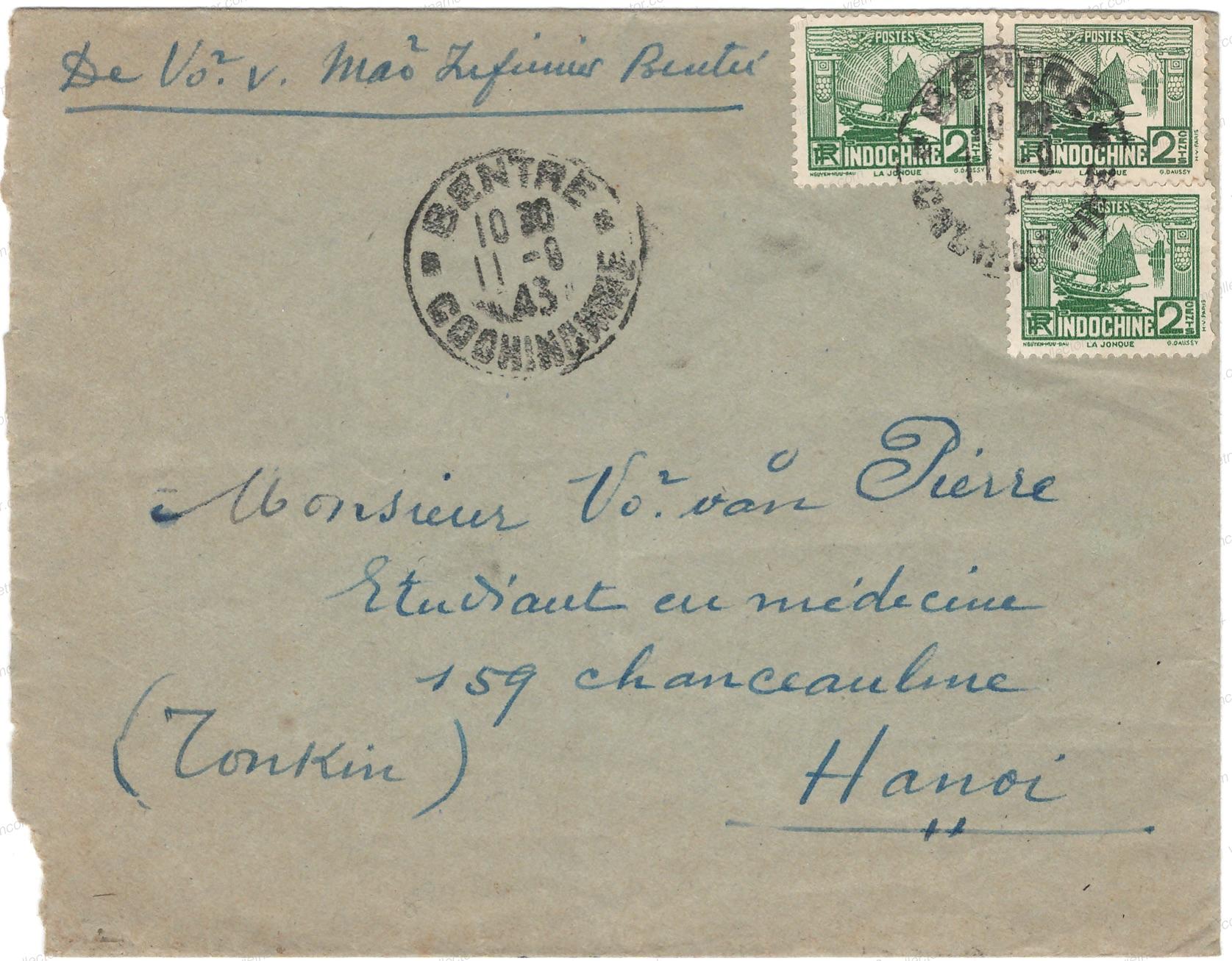
Mixed franking of the 2C and 4C Domestic Scences II stamps paying an overall postage of 6C on domestic letter sent in June of 1942 from Thai Nguyen to Gia-Lam. This was during the Japanese occupation, in which domestic mail volume was very low. Hanoi transit and Gia-Lam arrival cancels on the reverse.
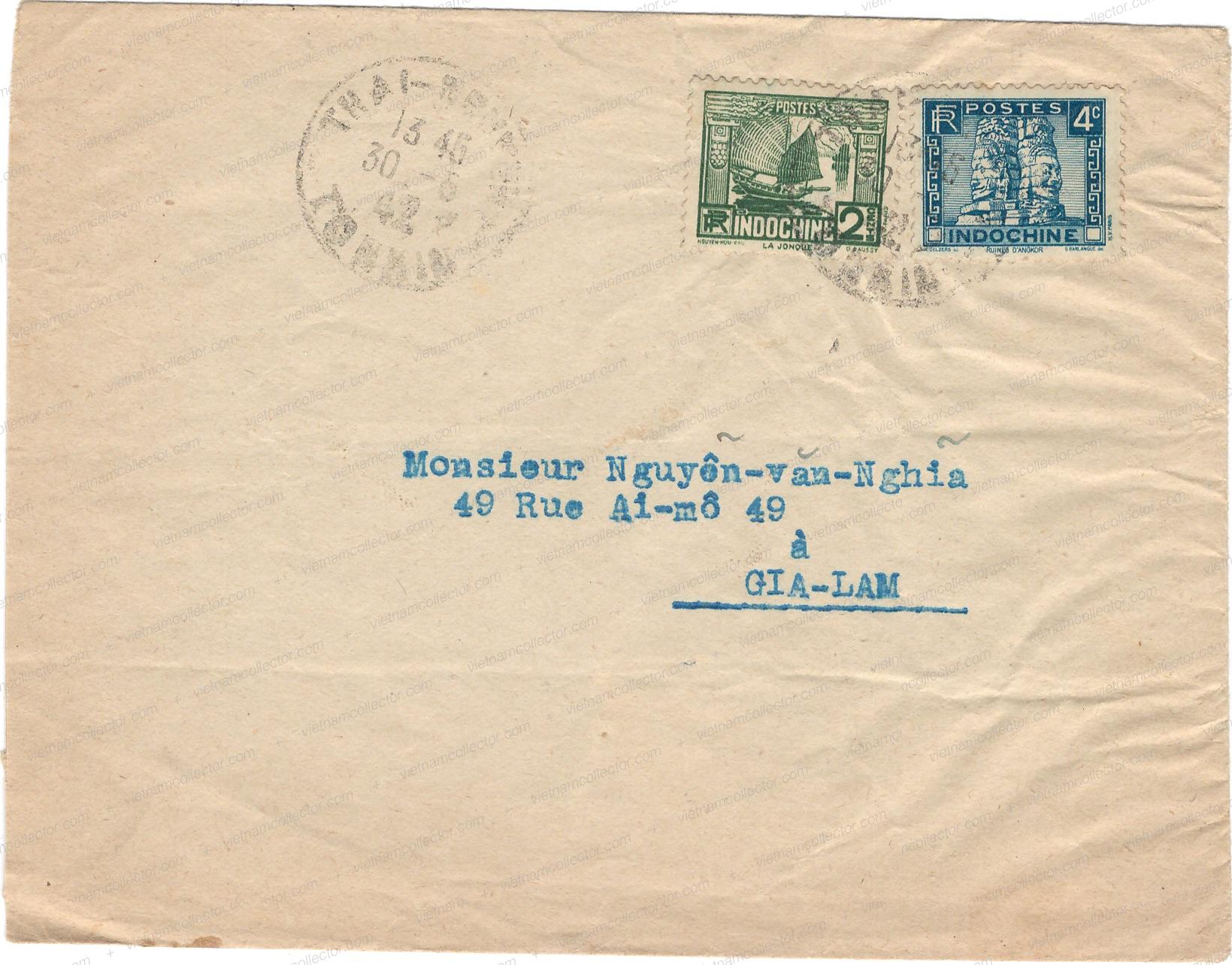
Mixed franking of the 1C , 6C (red) and 10C on the 6C postal stationary paying an overall postage of 22C on a registered domestic letter sent from Da Lat to Saigon. Saigon Central arrival cancel on the reverse.
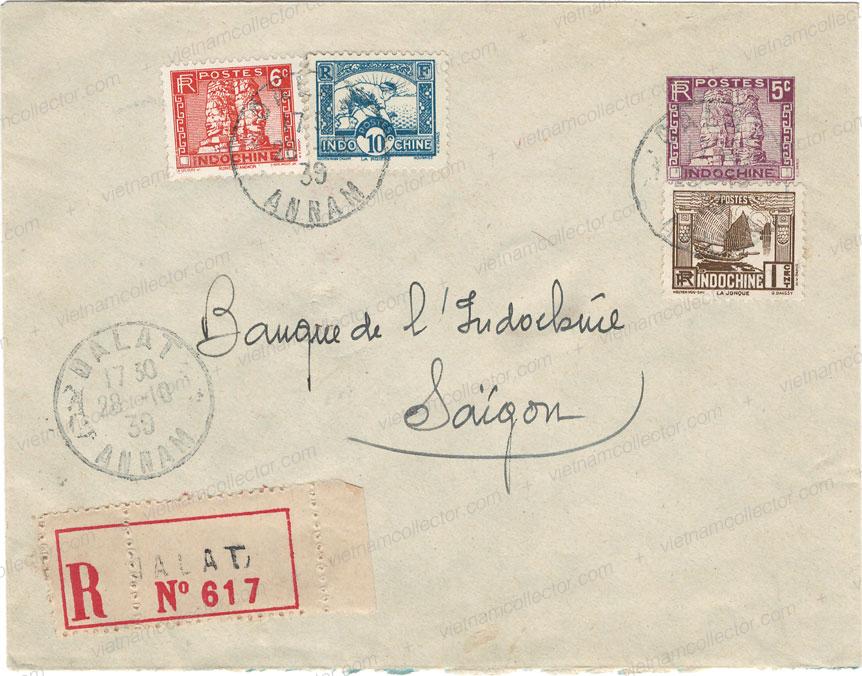
Multiple franking of the 3C (Brown) paying an overall postage of 9C on a domestic letter sent by the Bank of Indochina in Qui Hon in May of 1940 to a branch in Hai Phong. This was during World Was II which meant that the letter was subject to censure. However, the bank enjoyed special privileges that exempted it from such censure which was indicated by a red cachet struck in front that read “Service de la Banque Privilegiee de L’Indochine”. Hai Phong arrival cancel on the reverse.
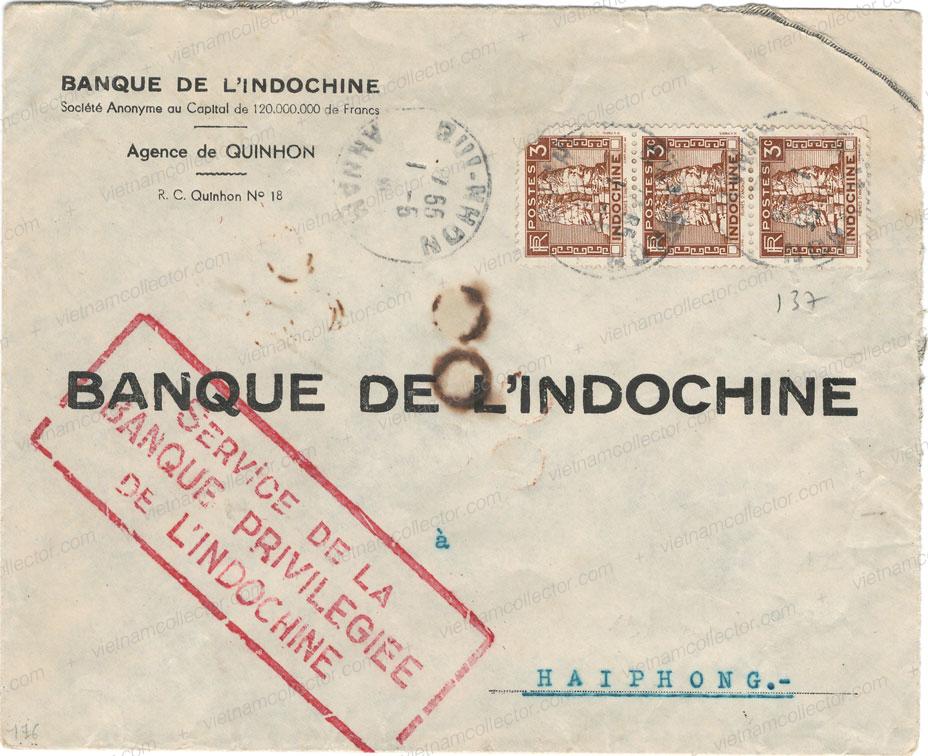
Mixed franking of the 2C and 3C (2) Domestic Scenes II values together with the 15C World Exhibition stamp paying an overall postage of 23C on an international letter sent in September of 1939 from Ben-Thuy to the United States in September of 1939. Although the United States did not join World War II until December 7th, 1941 the letter was censored by the French as indicated by the circular “Controls Postal” censor cachet. Vinh and Saigon transit cancels on the reverse.
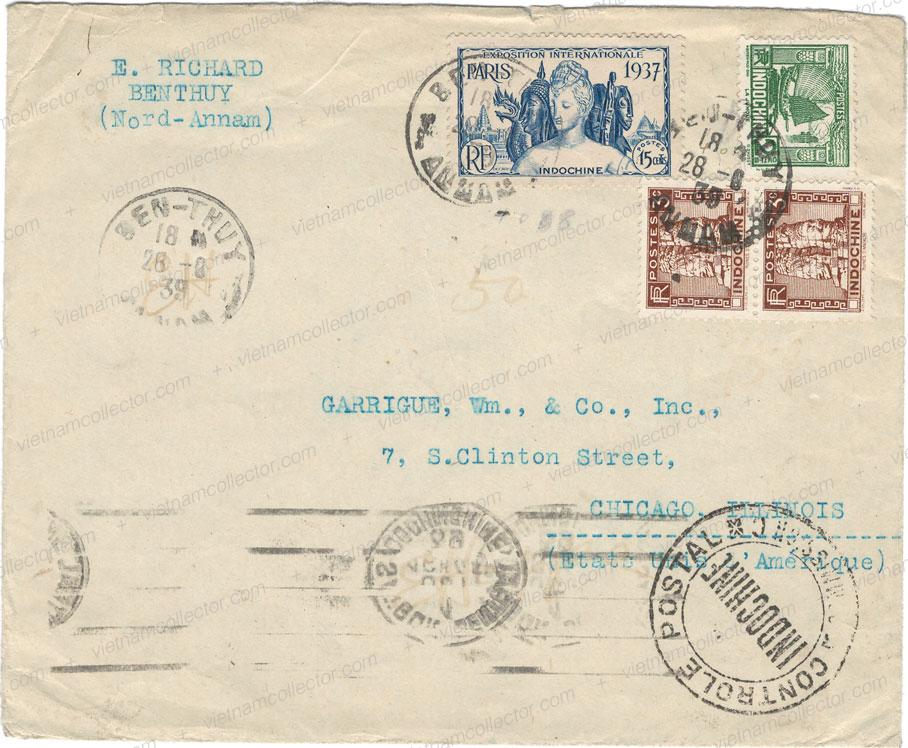
Mied franking of the 1C (3) and 25C stamps paying an overall postage of 28C on a registered domestic letter sent by the Bank of Indochina in Saigon to a branch office in Vinh in February of 1942. The stamps carry the perfin of the Bank “B.I.”. Hue transit and Vinh arrival cancel on the reverse.
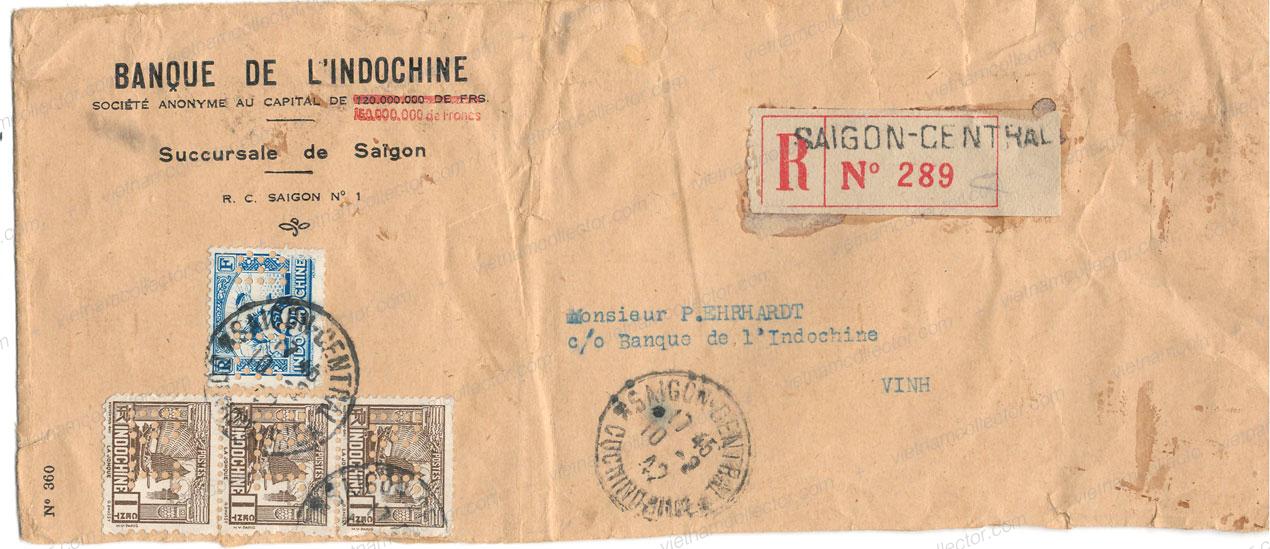 Mixed franking of the 1C, 2C (4) and 3C (brown) stamps paying an overall postage of 21C on an international registered letter sent from Vinh to France in February of 1935. Hai-Phong transit and French arrival cancel on the reverse.
Mixed franking of the 1C, 2C (4) and 3C (brown) stamps paying an overall postage of 21C on an international registered letter sent from Vinh to France in February of 1935. Hai-Phong transit and French arrival cancel on the reverse.
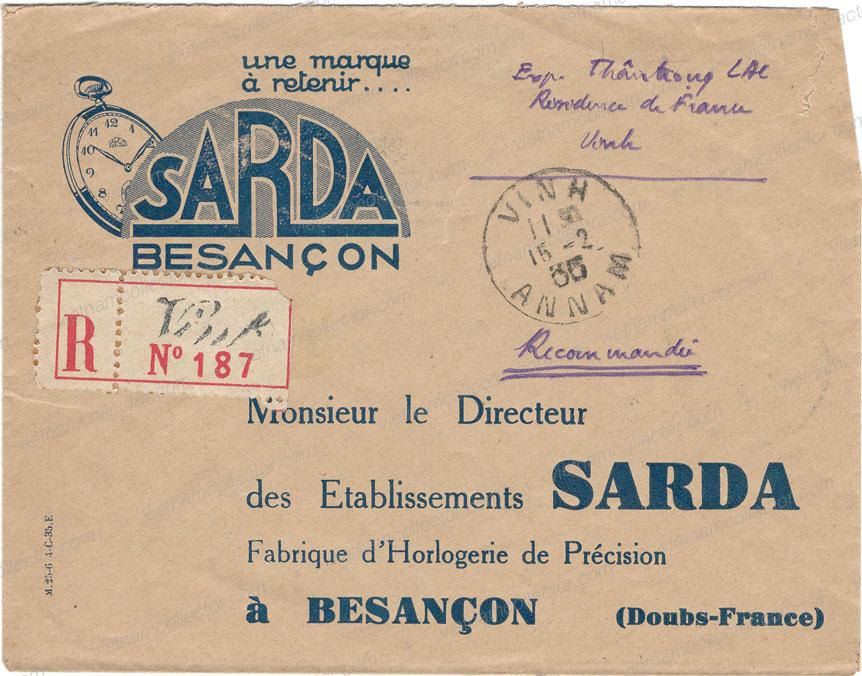
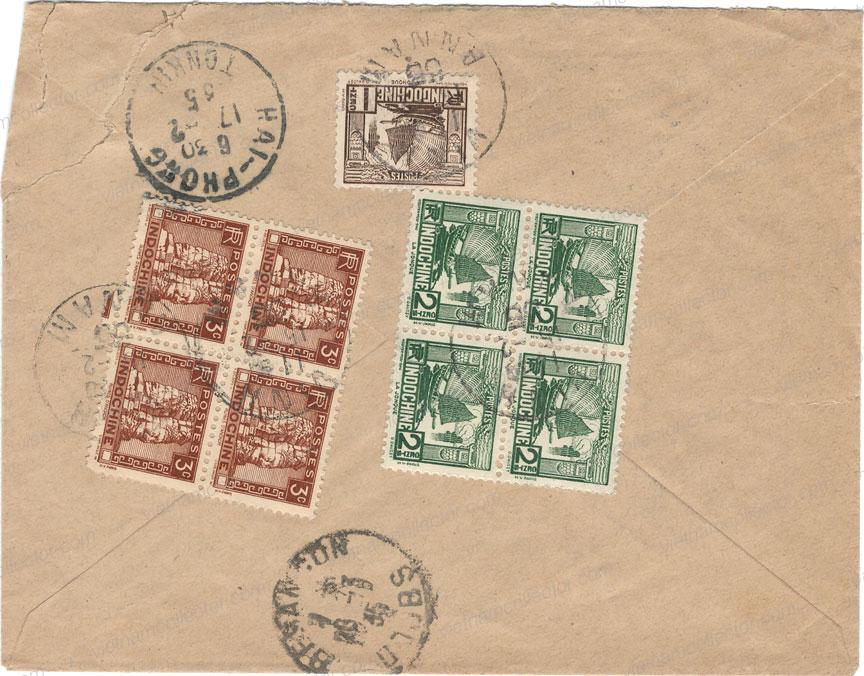 Multiple franking of the 3C (brown) value (2) paying an overall postage of 6C on an international letter sent from Nam Dinh to France in November of 1935. Hai-Phong transit cancel on the reverse. Boxed advertisement cachet “Consume the rice at the cafe Indochina” on front.
Multiple franking of the 3C (brown) value (2) paying an overall postage of 6C on an international letter sent from Nam Dinh to France in November of 1935. Hai-Phong transit cancel on the reverse. Boxed advertisement cachet “Consume the rice at the cafe Indochina” on front.
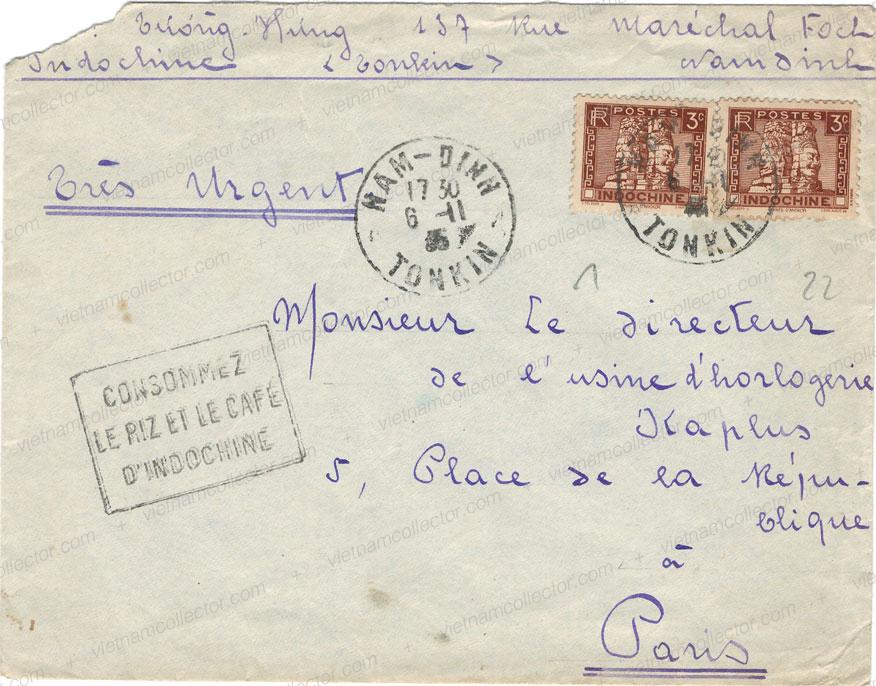 Multiple franking of the 3C (green) value (2) paying an overall postage of 6C on an international letter sent by a member of the French military located in Phu-Lang-Thuong to France in January of 1935. Hai-Phong transit and Besancon arrival cancel on the reverse.
Multiple franking of the 3C (green) value (2) paying an overall postage of 6C on an international letter sent by a member of the French military located in Phu-Lang-Thuong to France in January of 1935. Hai-Phong transit and Besancon arrival cancel on the reverse.
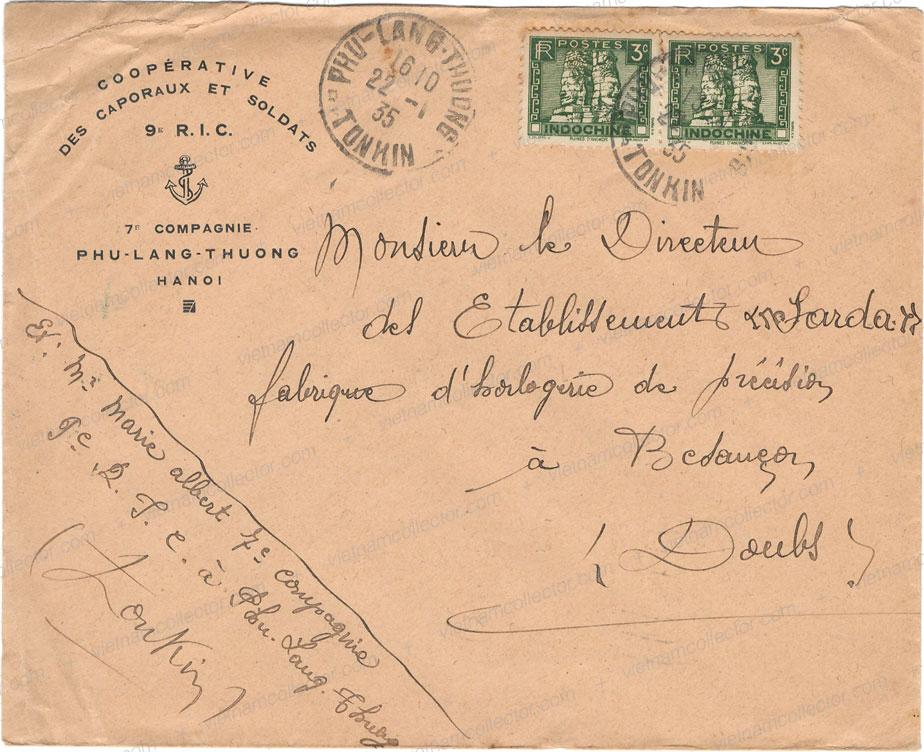
Multiple franking of the 5C Domestic Scences value (8) paying the correct tariff on an international letter from Bac Lieu to China in October of 1943. International letters during the Japanese occupation period are hard to find.


Mixed franking of the 4C, 6C and 30C Domestic Motives II stamps paying an overall postage of 40C on a domestic air mail letter sent from Vientiane to Saigon. Mail originating in Laos is hard to find as mail volume was low.
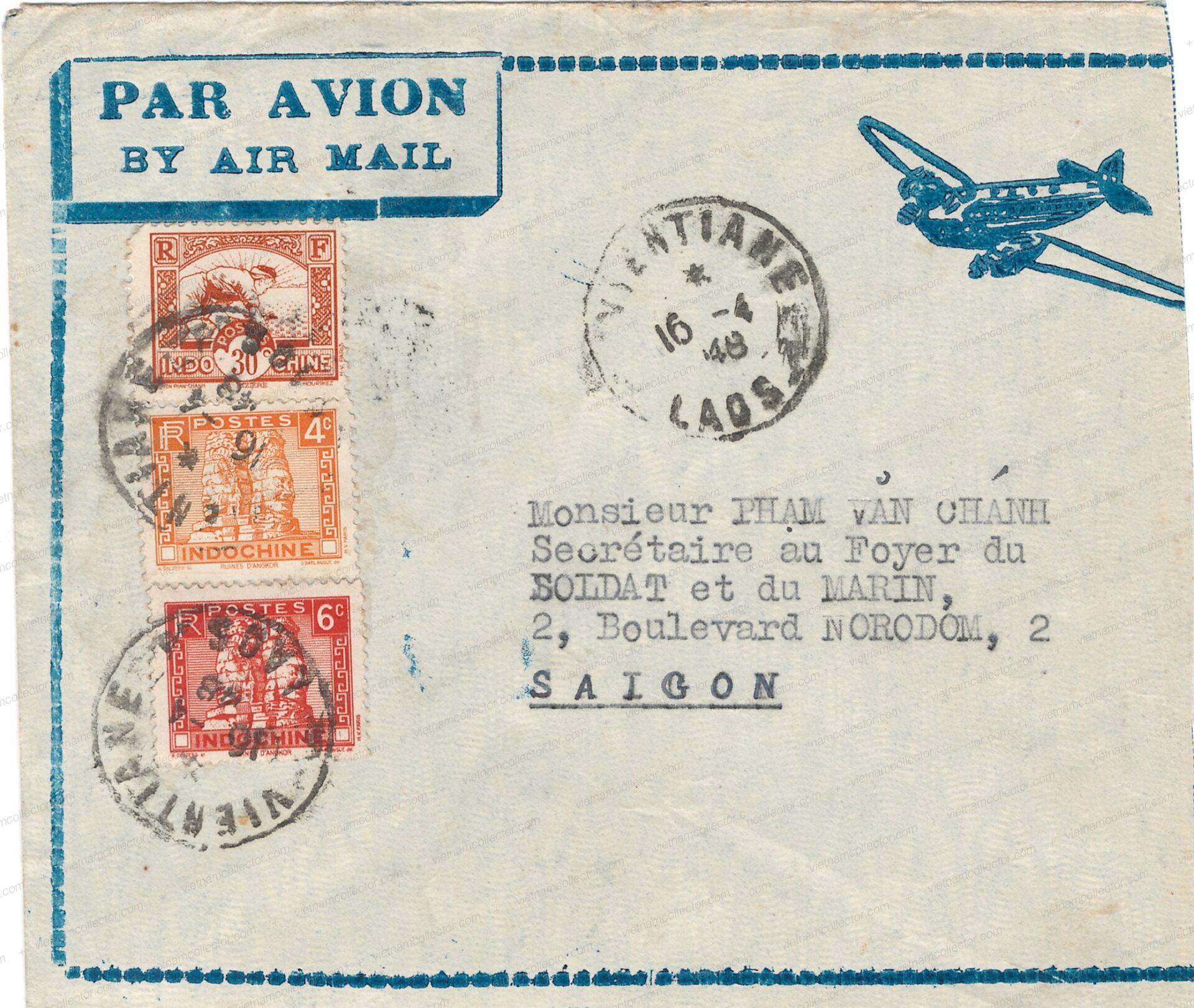
Mixed franking of the 1C value on the 5C postal stationary paying (14.5×11.2cm) from Tran Bang (rare cancel) to Saigon in August of 1938. Saigon Central arrival cancel on the reverse.
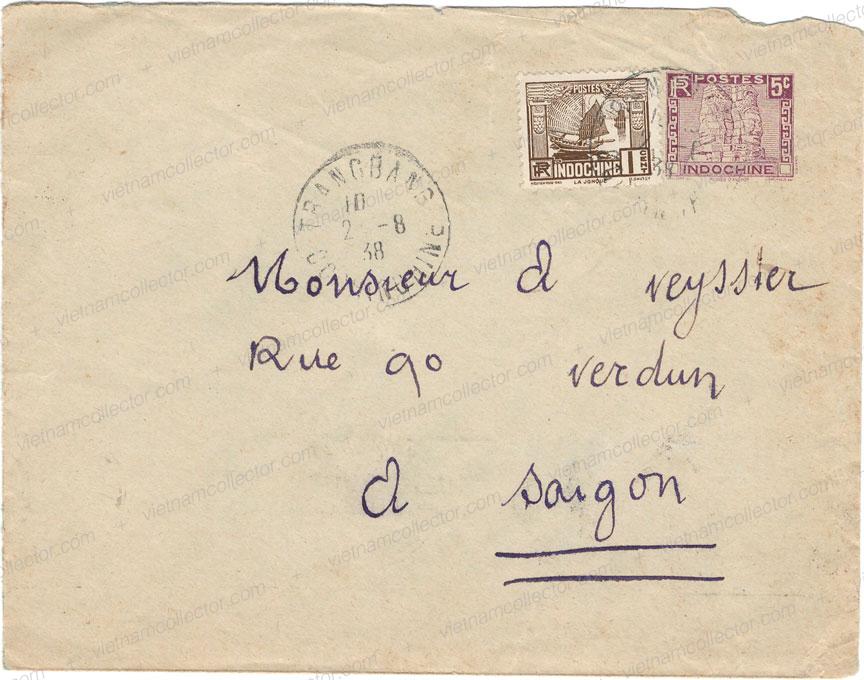
Mixed franking of the 1C value on the 5C Domestic Scenes II postal stationary (14.5×11.2cm) together with the 15C World Exhibition stamp paying an overall postage of 21C on a registered letter sent from Hanoi to Nam Dinh in June of 1938. Nam Dinh arrival cancel on the reverse.
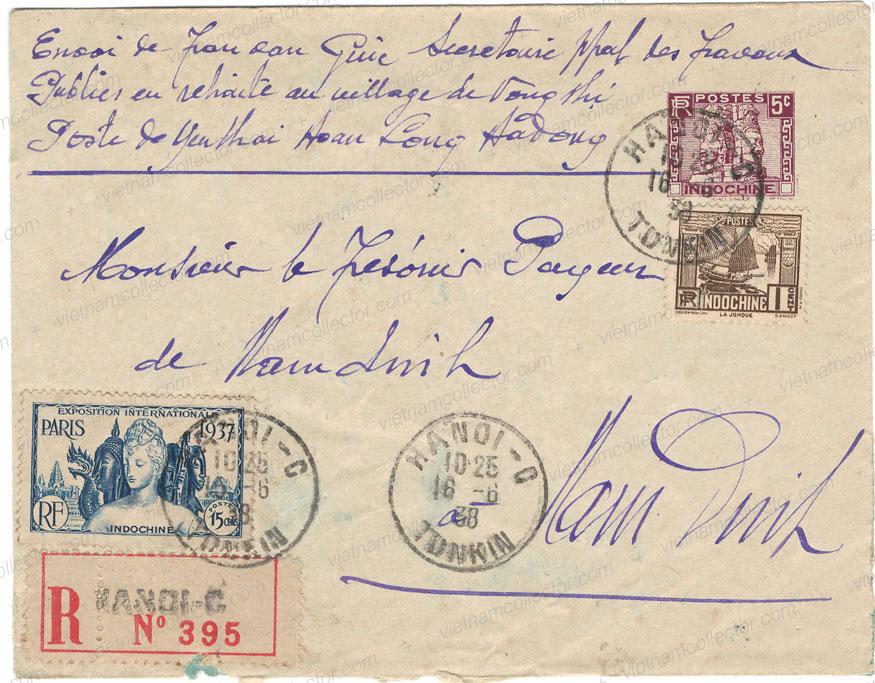 Postal stationary of the 5C Domestic Scenes II stamp (14.5×11.2cm) mailed within Saigon in June of 1936.
Postal stationary of the 5C Domestic Scenes II stamp (14.5×11.2cm) mailed within Saigon in June of 1936.
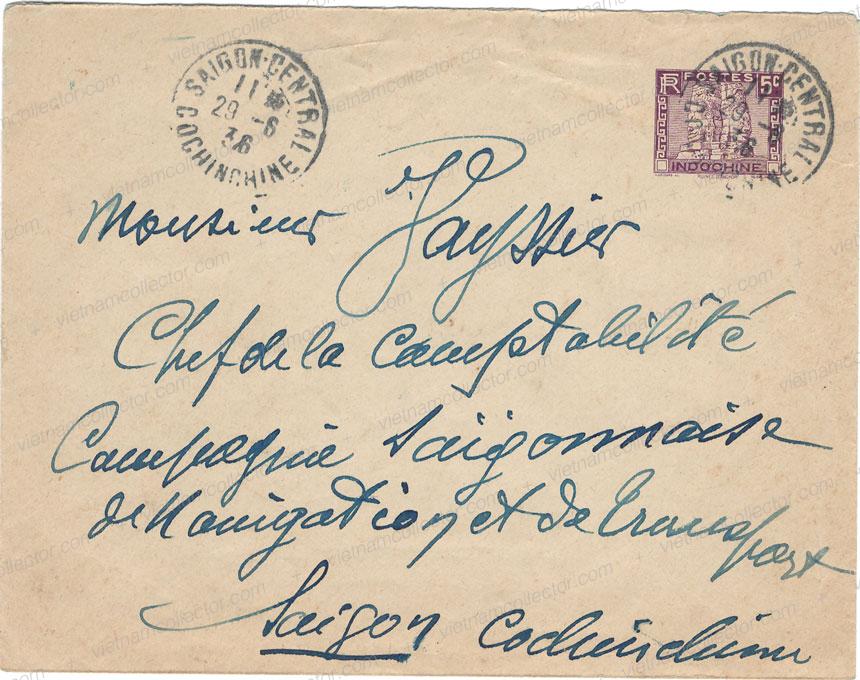
Postal stationary of the 5C Domestic Scenes II stamp (14.5×11.2cm) mailed from Fai Fu to Hanoi in May of 1937.
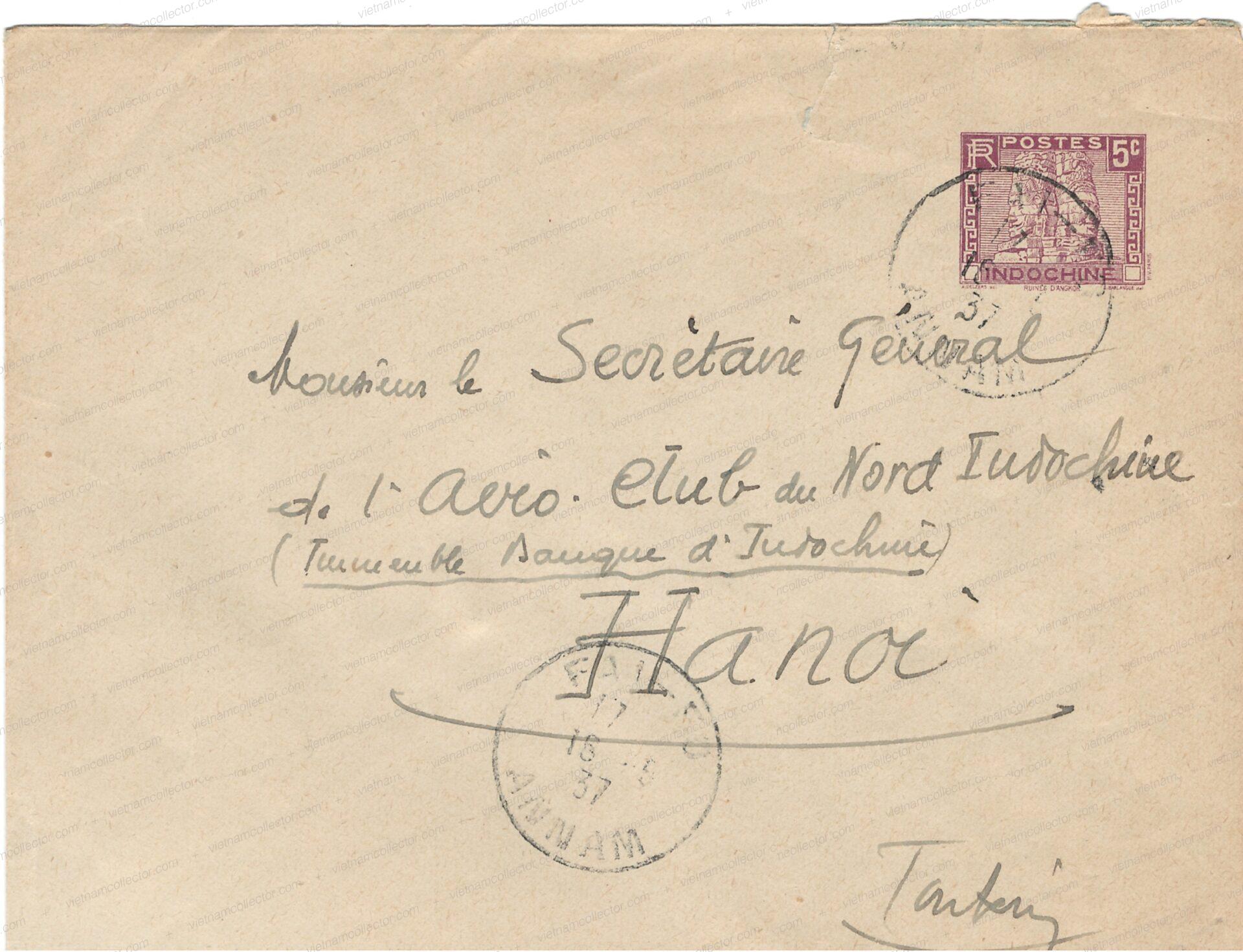
Postal stationary of the 5C Domestic Scenes II stamp (14.5×11.2cm) mailed from Gia Loc to Hanoi in Octoberof 1932. The letter was initially canceled with the rare “Post Rurale” cancel of Gia Loc and then further processed in Hai Duong.
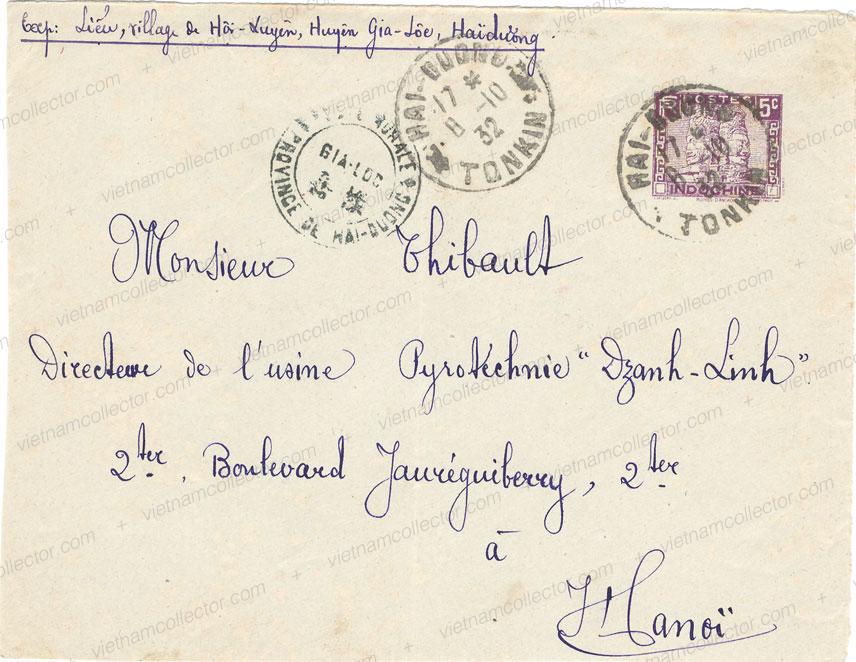
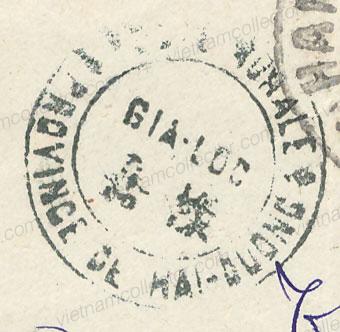
Mixed franking of the 1C and 5C stamps paying an overall postage of 6C on an international letter sent from Battanbang, Cambodia to France in June of 1935. Saigon transit and Tours arrival cancels on the reverse.
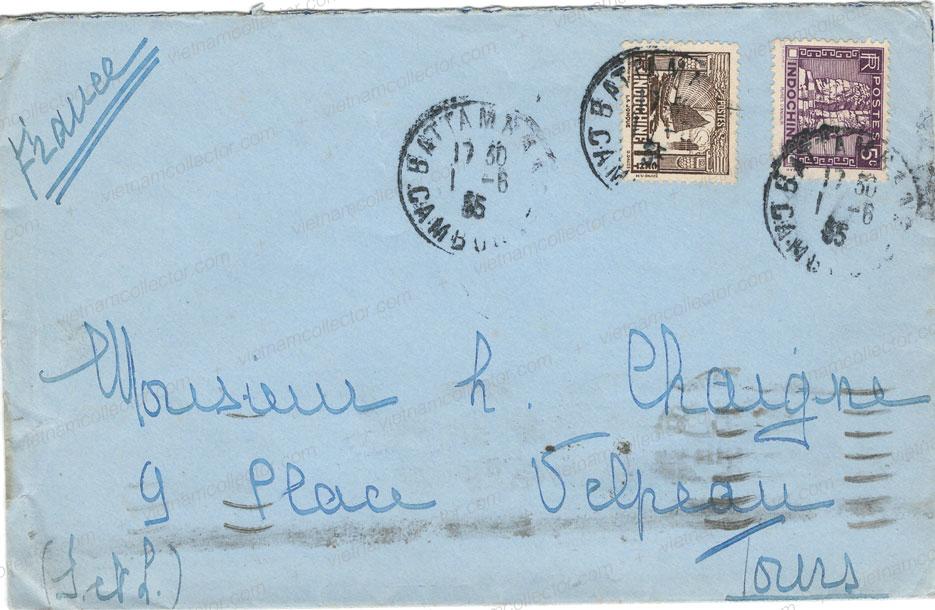
Mixed franking of the 5C Domestic Scenes postal stationary (14.5×11.2cm) together with two 1C stamps paying an overall postage of 7C on an international letter sent from Cambodia to France in March of 1938. Pnom Penh transit and Besancon machine arrival cancel on the reverse.
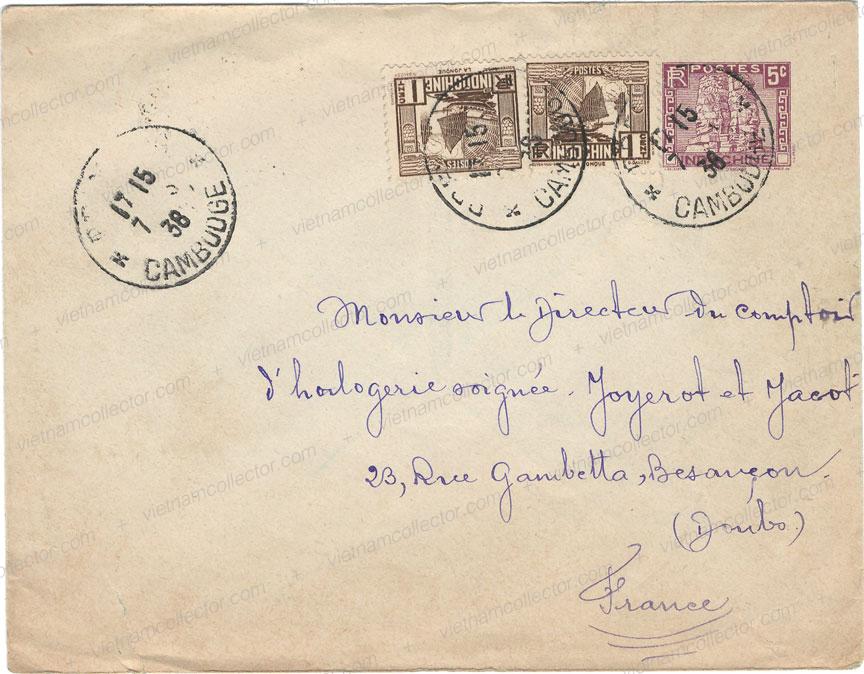 Mixed franking of the 2C and 4C (yellow) values paying an overall postage of 6C on a domestic letter sent during the Japanese Occupation of Cambodia in June of 1943 from Dong Hoi (rare cancel) to Len Huy.
Mixed franking of the 2C and 4C (yellow) values paying an overall postage of 6C on a domestic letter sent during the Japanese Occupation of Cambodia in June of 1943 from Dong Hoi (rare cancel) to Len Huy.
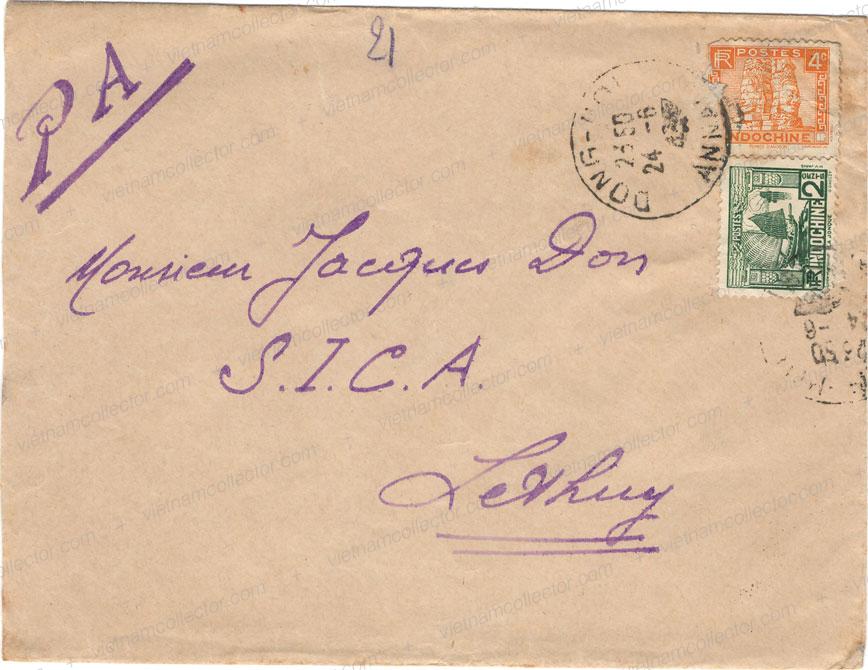 Multiple franking of the 4C values (dark-blue) paying an overall postage of 8C on a international post card sent from Saigon to France in December of 1937. Air France motive on front.
Multiple franking of the 4C values (dark-blue) paying an overall postage of 8C on a international post card sent from Saigon to France in December of 1937. Air France motive on front.
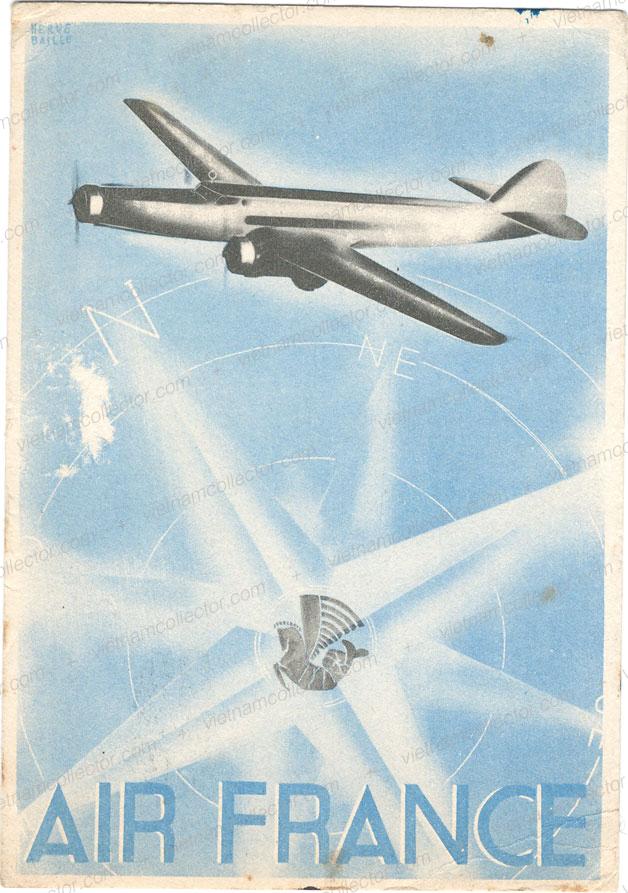

Mixed franking of the 2C Air Mail together with the 4C (green) and 5C Domestic Scenes II stamps paying an overall postage of 11C on a First Flight Cover inaugurating the opening of the air route from Vientiane, Laos to Saigon on July 7th, 1939.
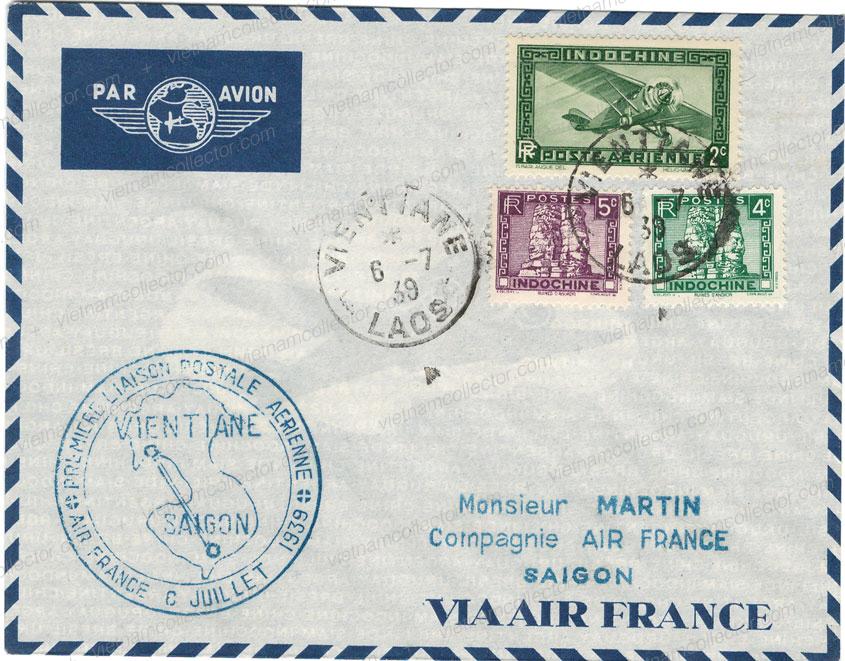
Single franking of the 5C value (lilac) on a small domestic letter (contents preserved) sent from Hanoi to Saigon in August of 1938.
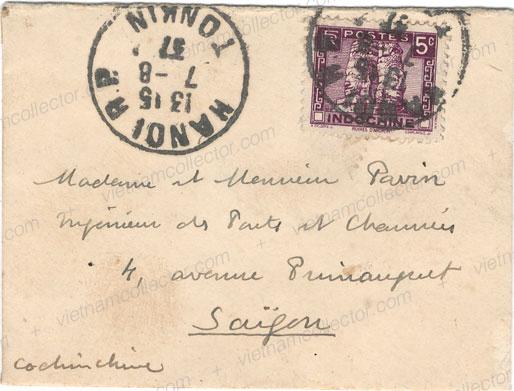 Single franking of the 6C stamp on a domestic letter sent during the Japanese Occupation of Indochina in July of 1941 from Cha-Pa (rare cancel) to Hanoi. The Japanese continued to use the same cachets and banderoles as the French did previously. So, while the censure marks and tape are French they were in fact administered by the Japanese. Hanoi arrival cancels on the reverse. Boxed “Chapa the Alps of Indochina, Alt. 1,500m” on front.
Single franking of the 6C stamp on a domestic letter sent during the Japanese Occupation of Indochina in July of 1941 from Cha-Pa (rare cancel) to Hanoi. The Japanese continued to use the same cachets and banderoles as the French did previously. So, while the censure marks and tape are French they were in fact administered by the Japanese. Hanoi arrival cancels on the reverse. Boxed “Chapa the Alps of Indochina, Alt. 1,500m” on front.
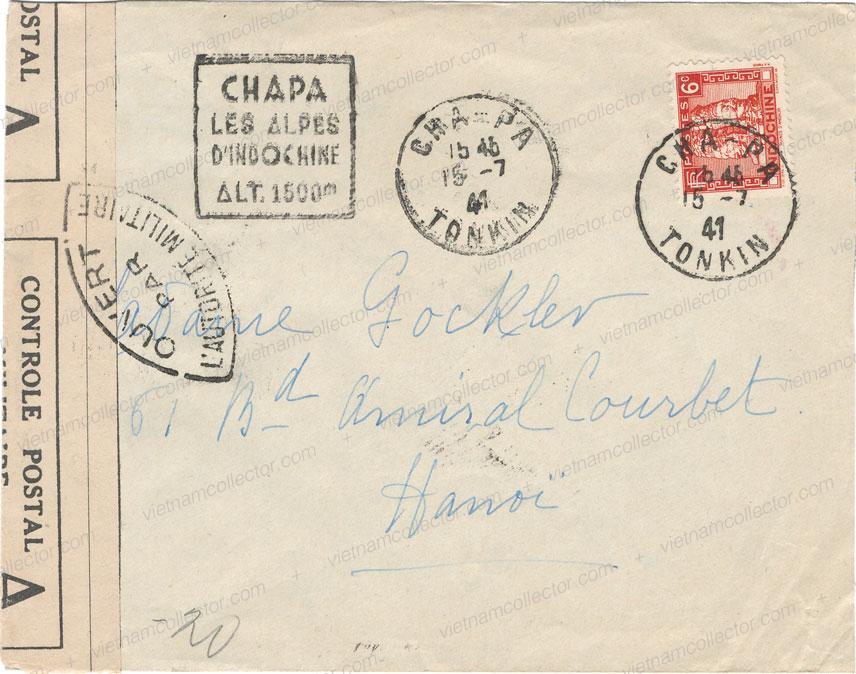
Single franking of the 6C value on a domestic letter sent by the Bank of Indochina in Hue in February of 1940 to a branch in Hai Phong. This was during World Was II which meant that the letter was subject to censure. However, the bank enjoyed special privileges that exempted it from such censure which was indicated by a red cachet struck in front that read “Banque Privilegied a expedier sans delai Exempt de Censure”. Hai Phong arrival cancel on the reverse.
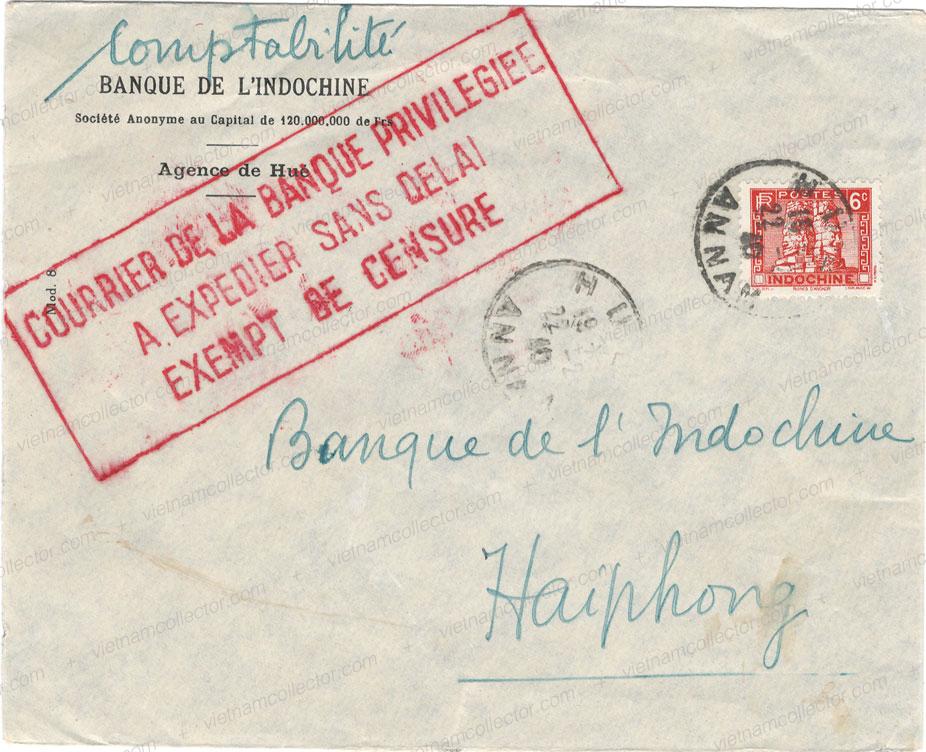
Single franking of the 6C value on a domestic letter sent by the Bank of Indochina in Tourane in March of 1940 to a branch in Hai Phong. This was during World Was II which meant that the letter was subject to censure. However, the bank enjoyed special privileges that exempted it from such censure which was indicated by a red cachet struck in front and back that read “Banque Privilegied a expedier sans delai Exempt de Censure”. Hai Phong arrival cancel on the reverse.
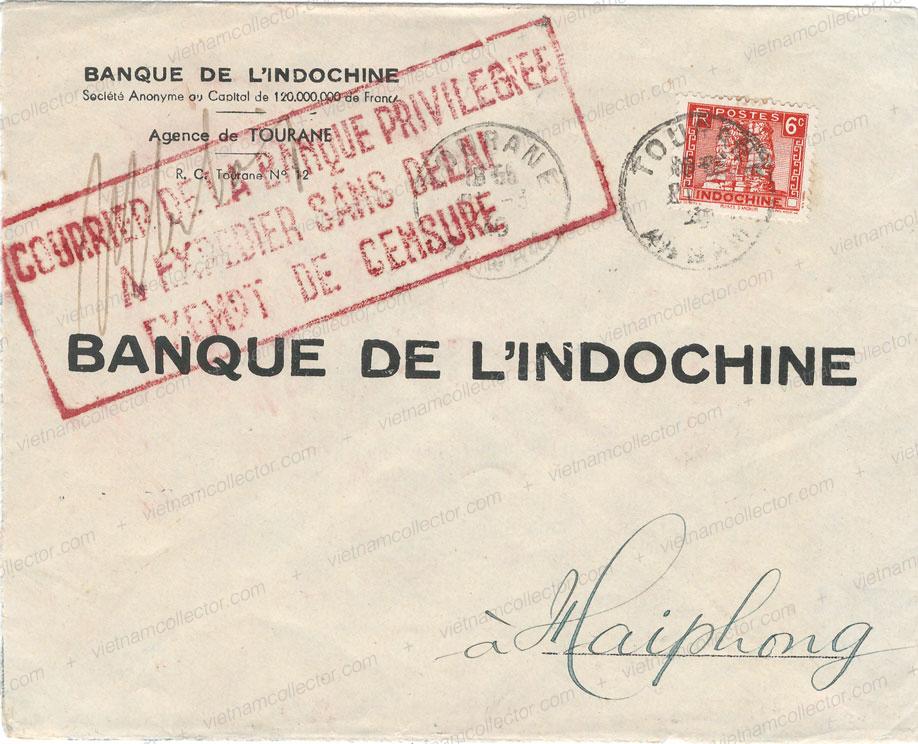
Single franking of the 6C value on a domestic letter sent by the Bank of Indochina in Ha Phong in October of 1939 to a branch in Hanoi. This was during World Was II which meant that the letter was subject to censure. However, the bank enjoyed special privileges that exempted it from such censure which was indicated by a red cachet struck in front that read “Banque Privilegied a expedier sans delai Exempt de Censure”. Hanoi arrival cancel on the reverse.
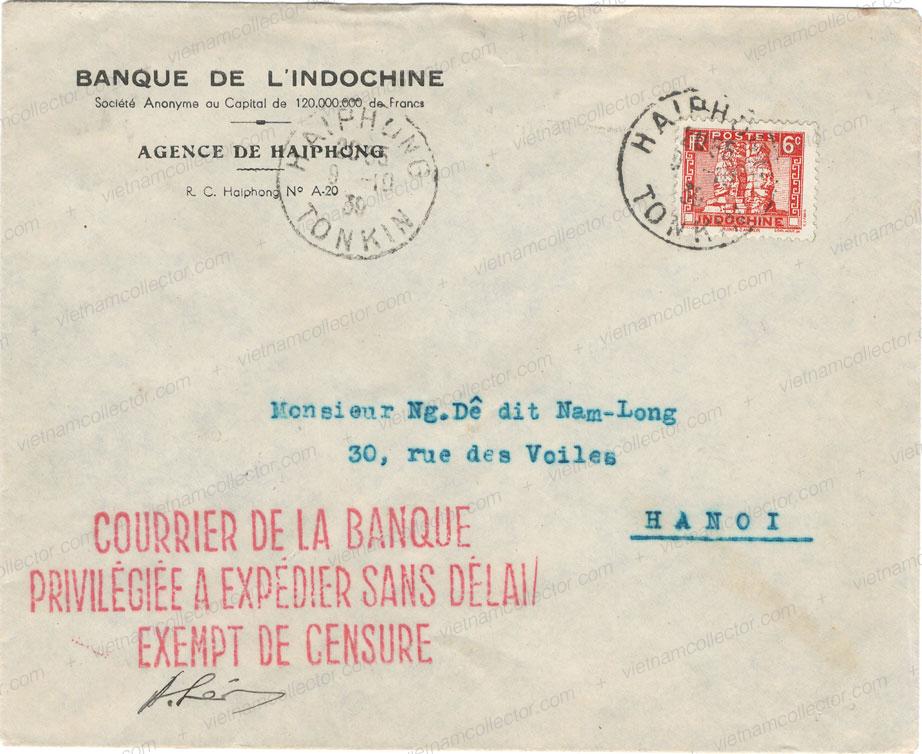
Multiple franking of the 6C value (5) paying an overall postage of 30C on an international letter sent Ninh And to France in June of 1935. Rare rural cancel on front. Hanoi transit and Paris arrival cancels on the reverse.
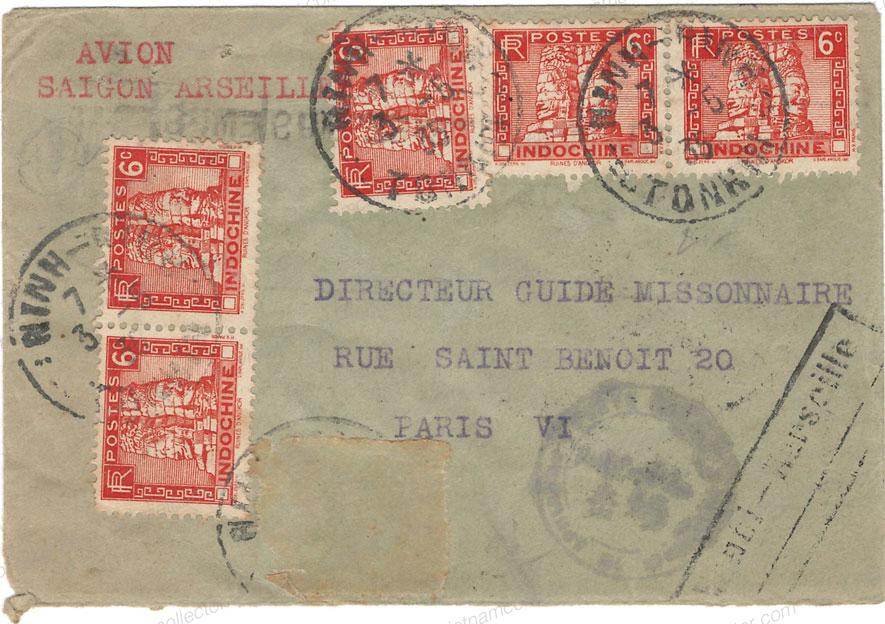
Detailed scan of the rural cancel.
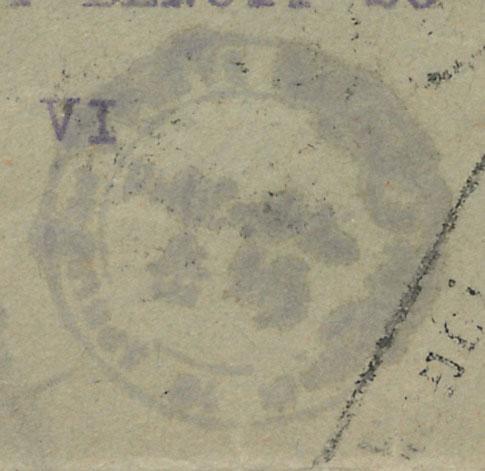
Rare single franking of the 6C value paying the domestic letter rate up to 10g in weight and sent from My Phuoc to Hanoi in September of 1941. The letter is cancelled with the rare rural cancel from My Phuoc. Saigon machine transit and Hanoi arrival cancels on the reverse. The letter was censured by the Japanese who were occupying Indochina at the time as is demonstrated by the “Hanoi R.P Bis” cancel on the reverse.
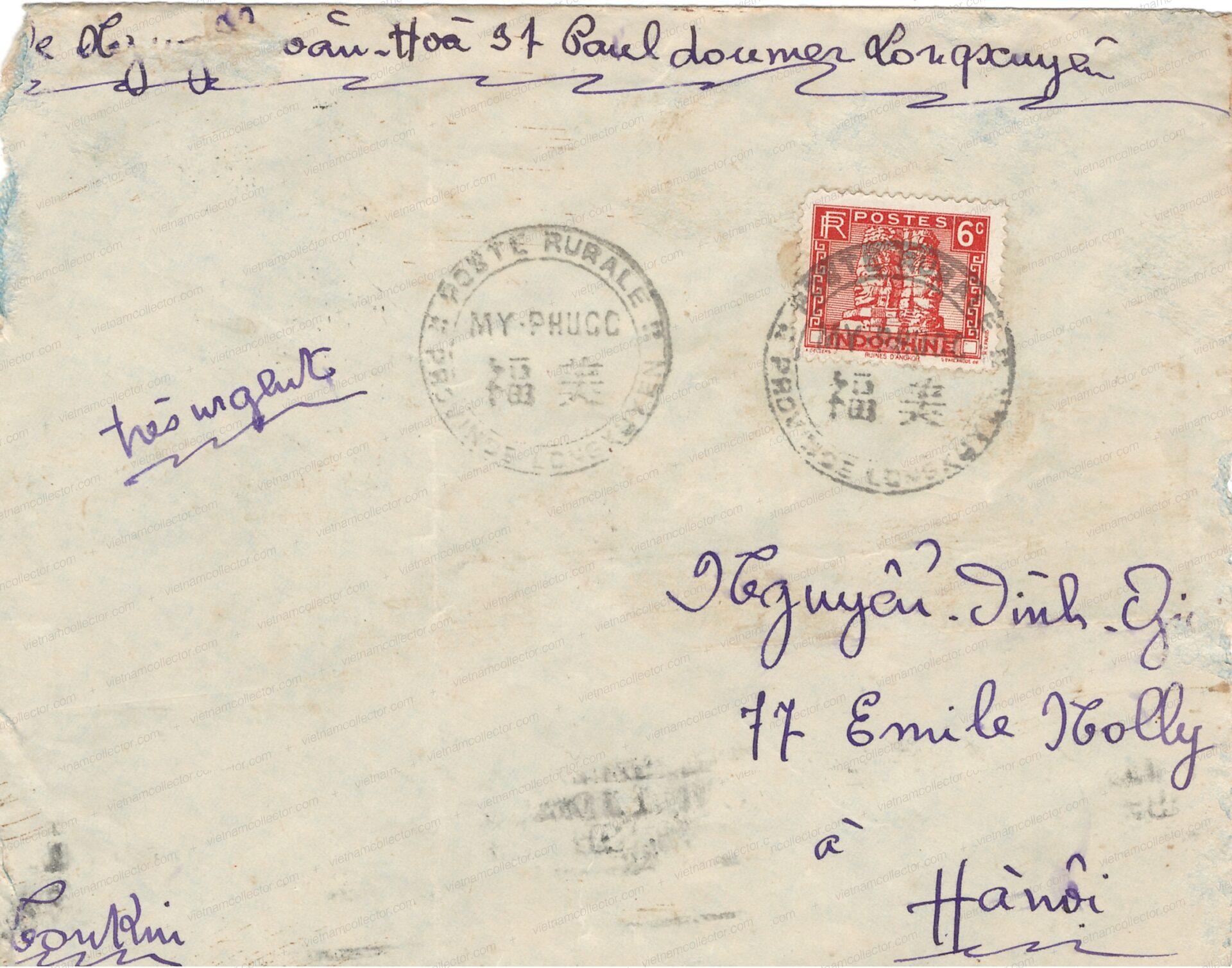
Mixed franking of the 6C Domestic Scenes II stamps one pair with paper bridge (5) together with the 3C and 4C value paying an overall postage of 37C on an international air mail letter sent from Ca Mau to France in February of 1937. Saigon transit and Paris arrival cancels on the reverse.
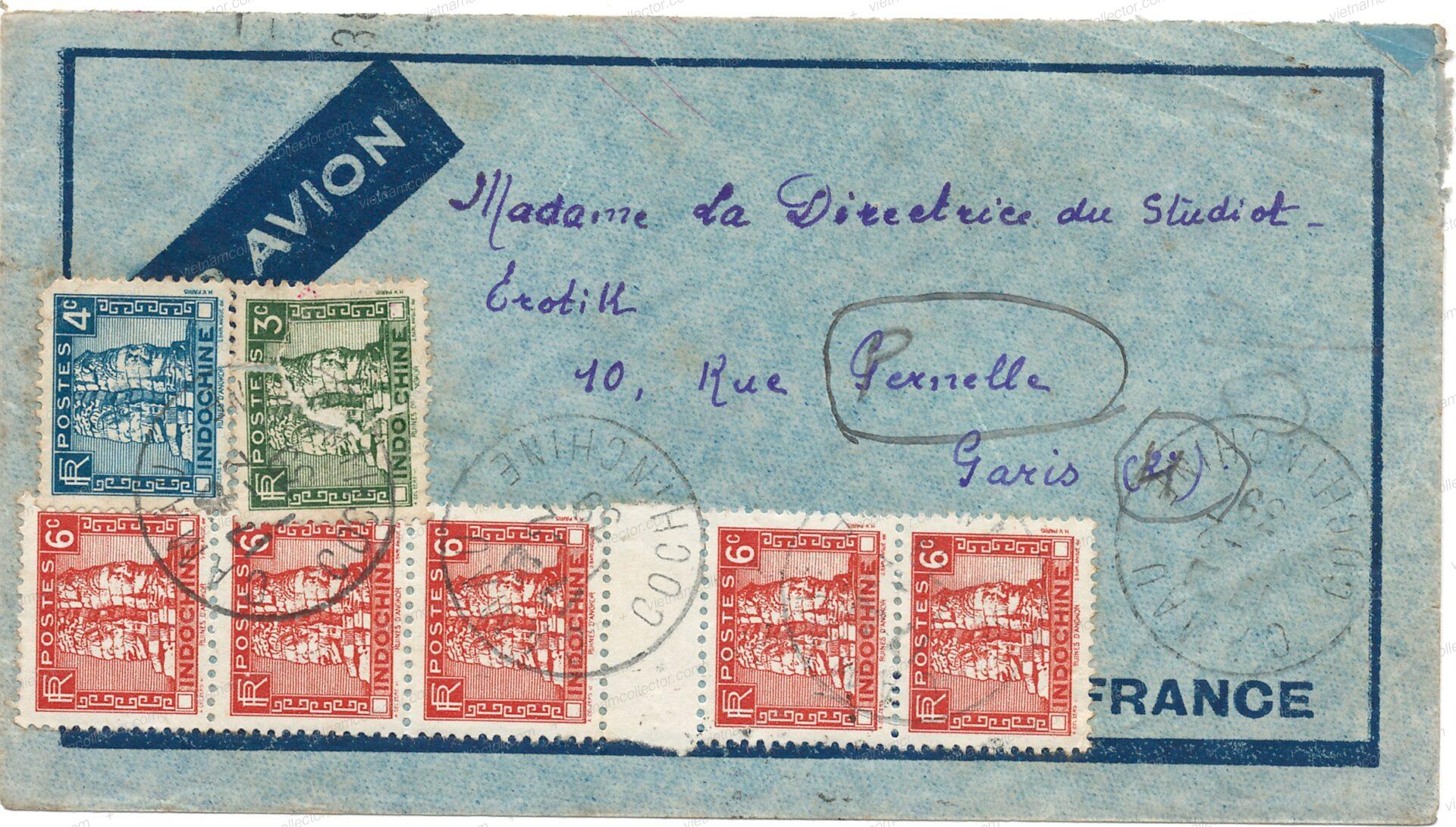
Mixed franking of the 3C (brown) and 6C values paying an overall postage of 9C on a domestic letter sent from Saigon to Hanoi in October of 1939. World War II had just broken out a month ago and so the letter was censured by the French military as indicted by the “Controle” banderole and circular “Controls-Postal” cachet. Censure of domestic letters was pretty rare prior to the Japanese Occupation.
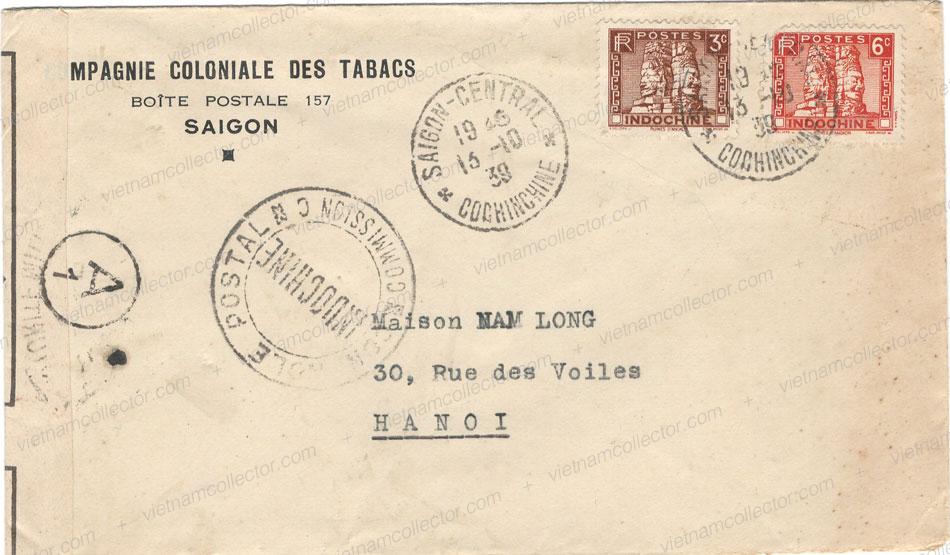
Mixed franking of the 8C Domestic Scences I together with the 1C Domestic Sciences II stamps paying an overall postage of 9C in an international postcard sent from Ankor, Cambodia to China in August of 1933.

Mixed franking of the 4C (green) together with the 10C ultramarine on pink (2) and the 30C Personalities on the 66C Air Mail postal stationary (14.5×11.5cm) paying an overall postage of 1.20P on an international air mail letter sent from Stung Tren, Cambodia (rare cancel) to France in July of 1947. The postage was insufficient to be transported by air mail. Hence the “Par Avon” imprint was crossed out and the postal clerk added the manuscript remark “Affranchise insufficient” in red crayon. Presumably the lettre was transported via surface mail. Illegible transit/arrival cancel on the reverse.
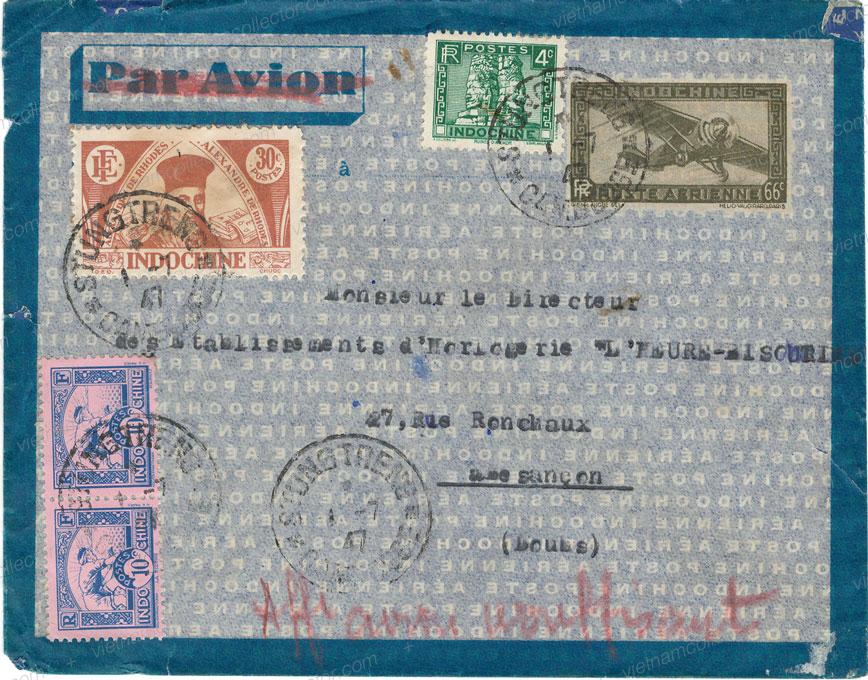
Mixed franking of the 3C (brown), 7C and 2P values paying an overall postage of 2.40P on an international letter sent from Stungtreng, Cambodia (rare cancel) to France. Ex Schwirtz.
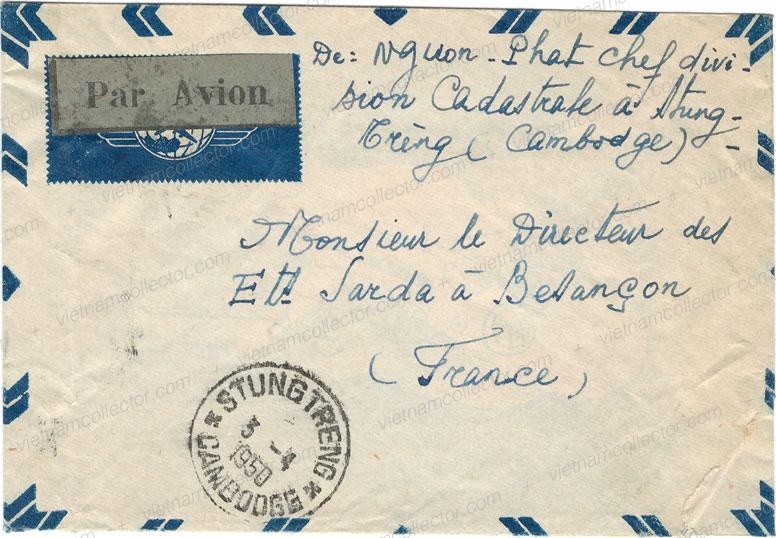
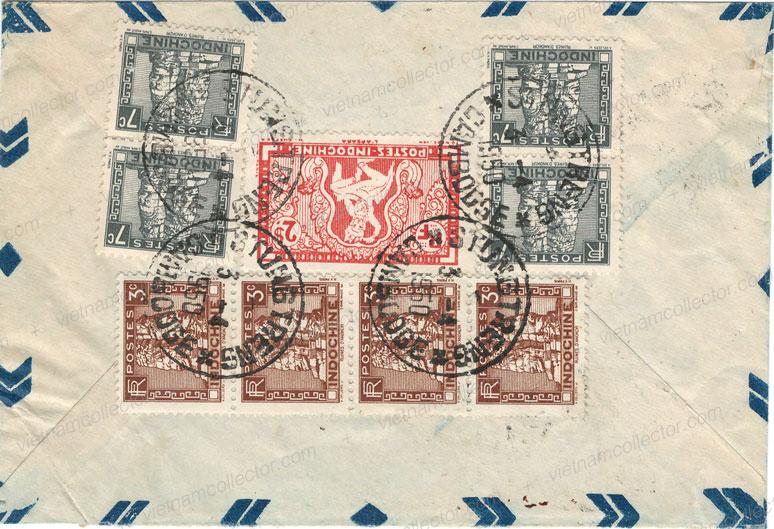
Mixed franking of the 3C brown, 7C grey and 2P Domestic Scenes II stamps paying an overall postage of 2.20P on an international air mail letter sent from Savannakhet, Laos (rare cancel) in September of 1949. The letter was underpaid by 20C and hence received a black “T” cachet in a triangle to indicate that postage was due on arrival. There is no indication that the postage due was ever collected.
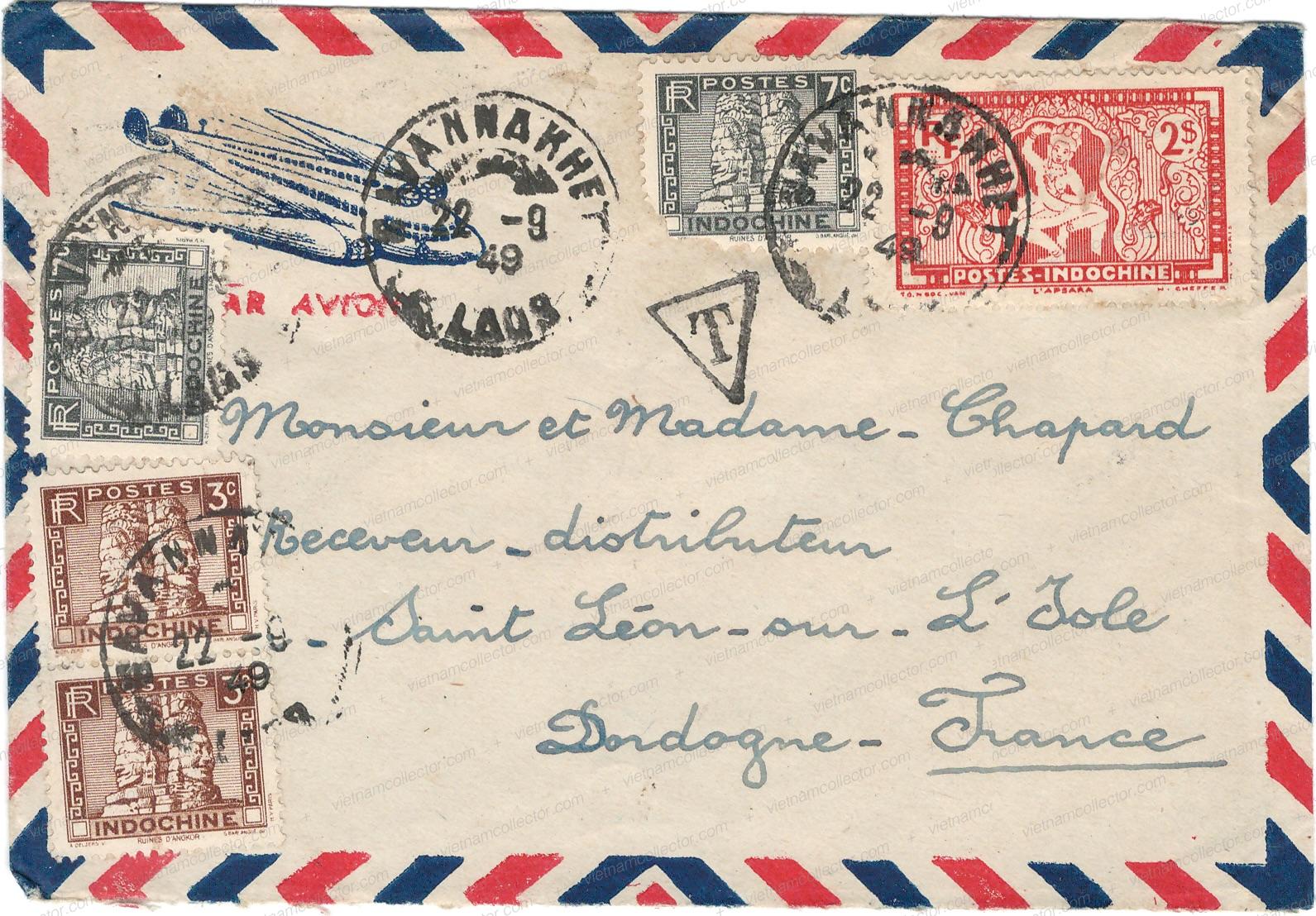
Mixed franking of the 1C and 8C Domestic SCences II stamps paying an overall postage of 9C on an international letter sent from Cao Lanh (small post office) to French Guinea (rare destination). Saigon transit and Nuinea arrival cancel on the reverse.
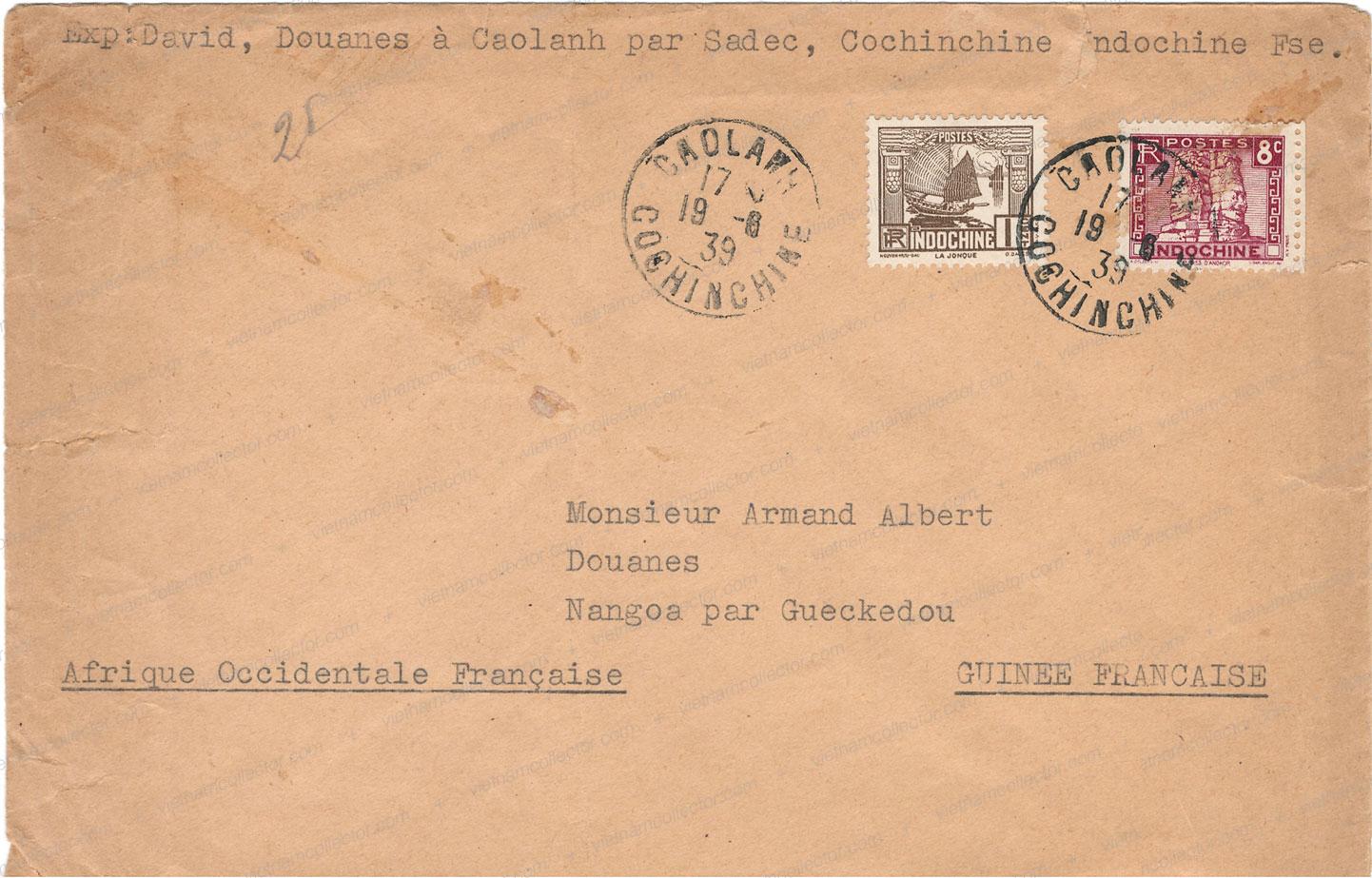
Mixed franking of the 2C Governors stamp together with stamps from the Personalities and Domestic SCences II sets paying an overall postage of 15C on a domestic letter front sent from Bien Hoa to Saigon on March 6th of 1945. Three days later the Japanese occupying force took over the administration of Indochina and arrested all French troops.
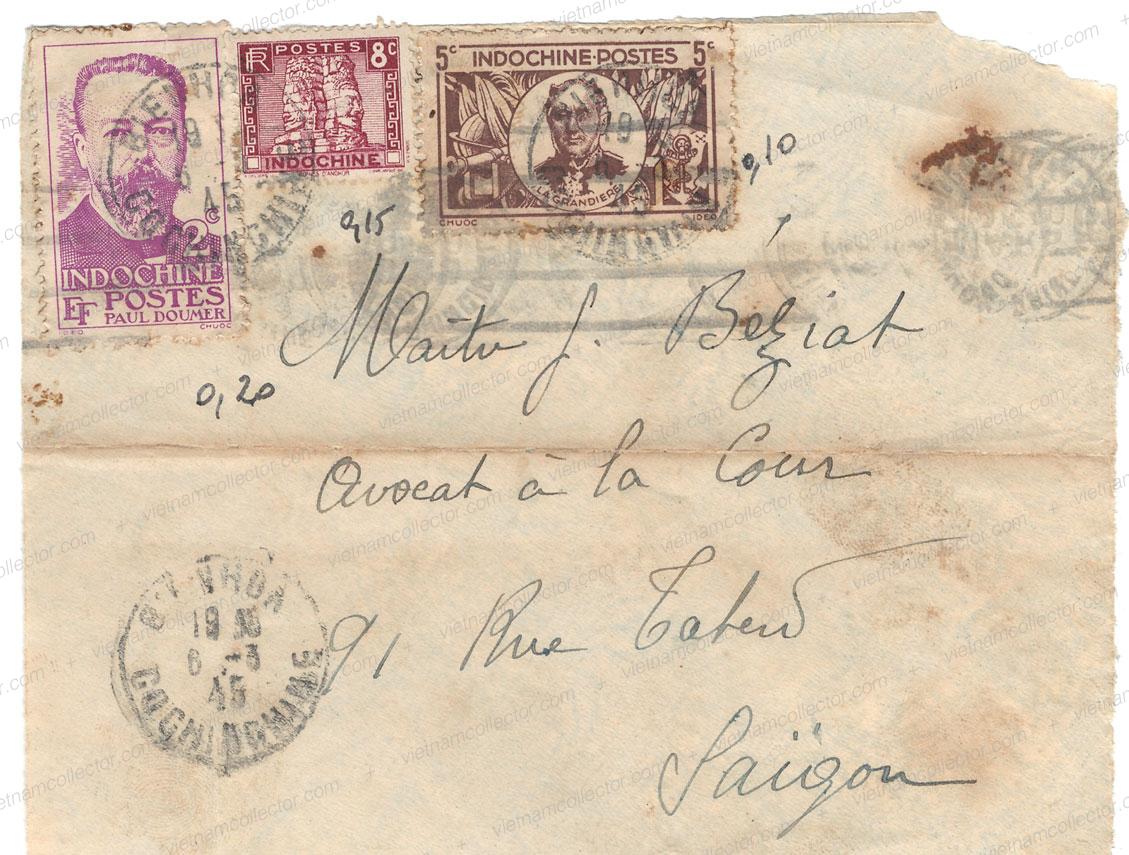
Mixed franking of the 9C (6) , 10C (2/blue on pink) and 21C (6) stamps paying an overall postage of 2P on an international air mail letter sent from Hue to France in August of 1948. Boxed propaganda cachet “Bravo, the Bình Xuyên Army made emperor Bảo Đại capitulate”. Illegible transit/arrival cancels on the reverse.
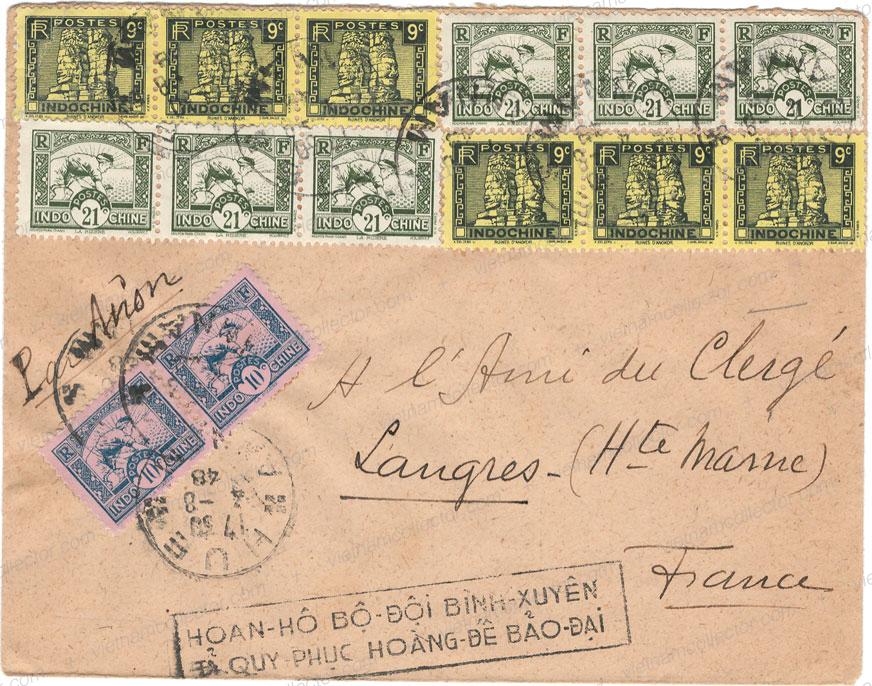
Mixed franking of three Victory stamps together with stamps from the Domestic Scences II set paying an overall postage of 3P on an international air mail letter sent from Dalat to the United States in March of 1948.
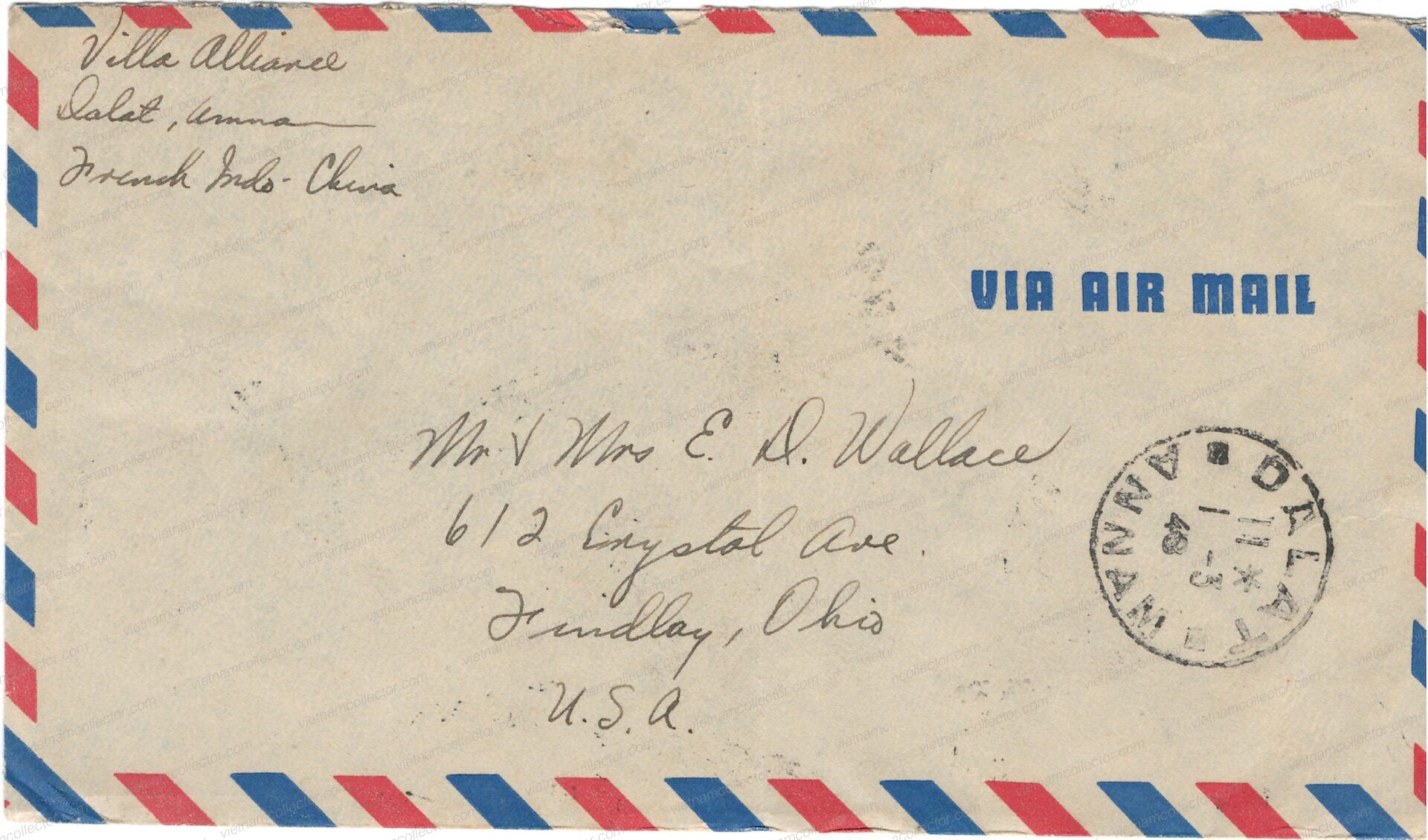
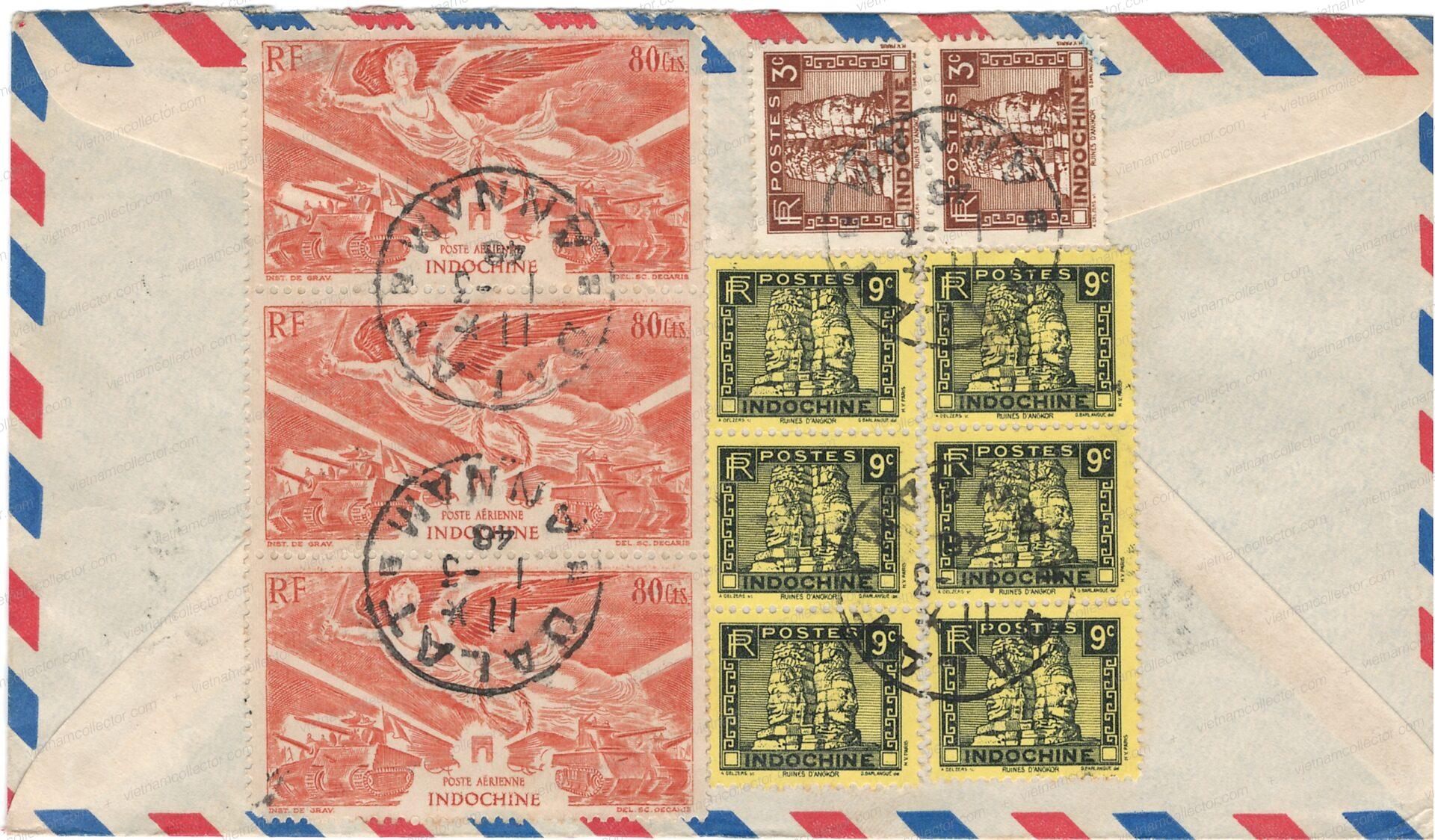
Multiple franking of the 10C ultramarine on pink stamps (12) paying an overall postage of 1.20P on an international letter sent from Saigon to France in October of 1947.
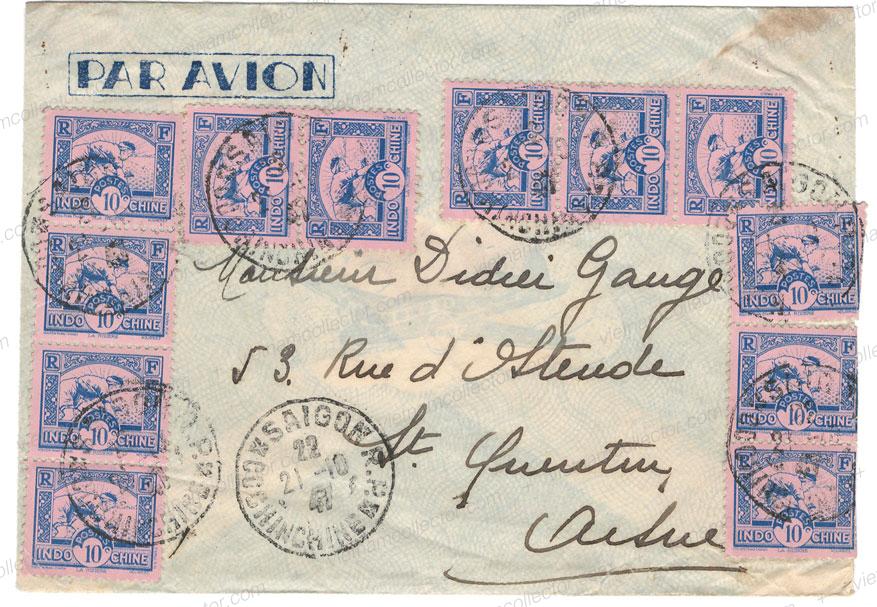 Single franking of the 10C value (blue) on an international printed matter mailing sent from Saigon Central to France in July of 1941. Since the letter was addressed to the part of the country that was affiliated with the German occupiers (Vichy) it was not censored by the Japanese that occupied Indochina at the time. However, the letter got intercepted in South Africa and was censored by South Africa as indicated by the red censor banderole used to re-seal the letter.
Single franking of the 10C value (blue) on an international printed matter mailing sent from Saigon Central to France in July of 1941. Since the letter was addressed to the part of the country that was affiliated with the German occupiers (Vichy) it was not censored by the Japanese that occupied Indochina at the time. However, the letter got intercepted in South Africa and was censored by South Africa as indicated by the red censor banderole used to re-seal the letter.
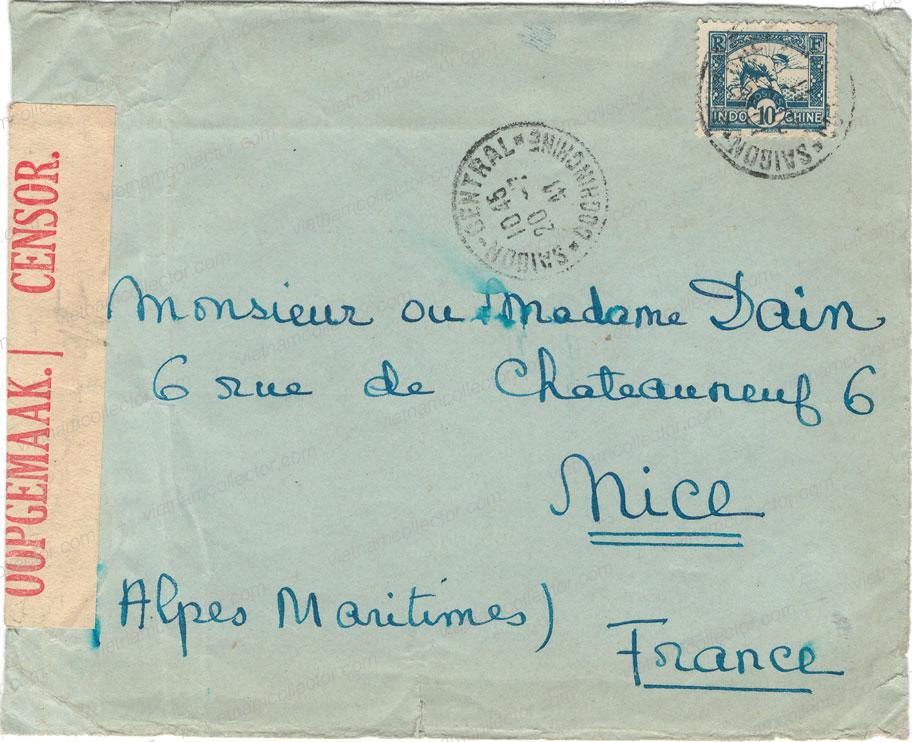
Very rare single franking of the 10C stamp on a domestic newspaper wrapper sent from Saigon to Switzerland in 1940. Most of these items were thrown away upon receipt so they are very hard to find now.
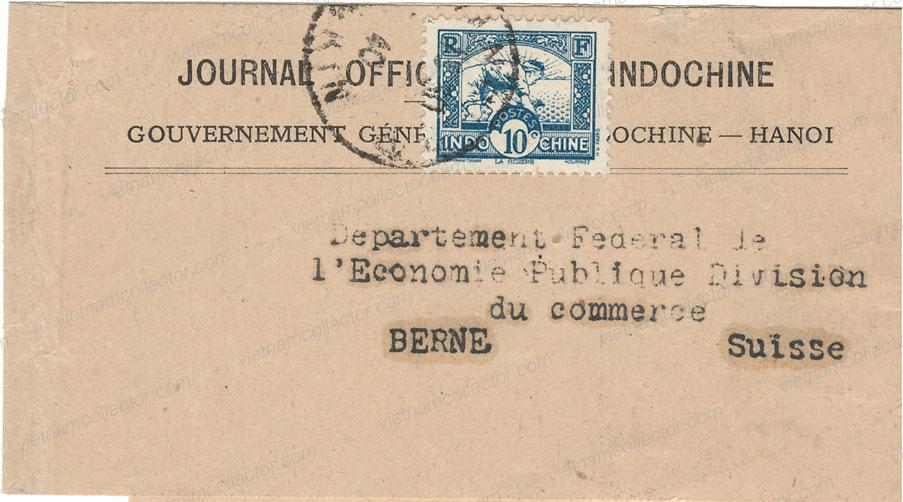
Single franking of the 10C (Blue) stamp on an international letter sent from Saigon to Paris in September of 1941. The North of France was occupied by German forces at the time and so the letter could not be delivered. Blue manuscript at bottom states “Occupied Zone, Delivery impossible”. Blue crayon “Retour”. Black boxed “Retour A L’Envoyeur” but crossed out. Red crayon on top illegible.
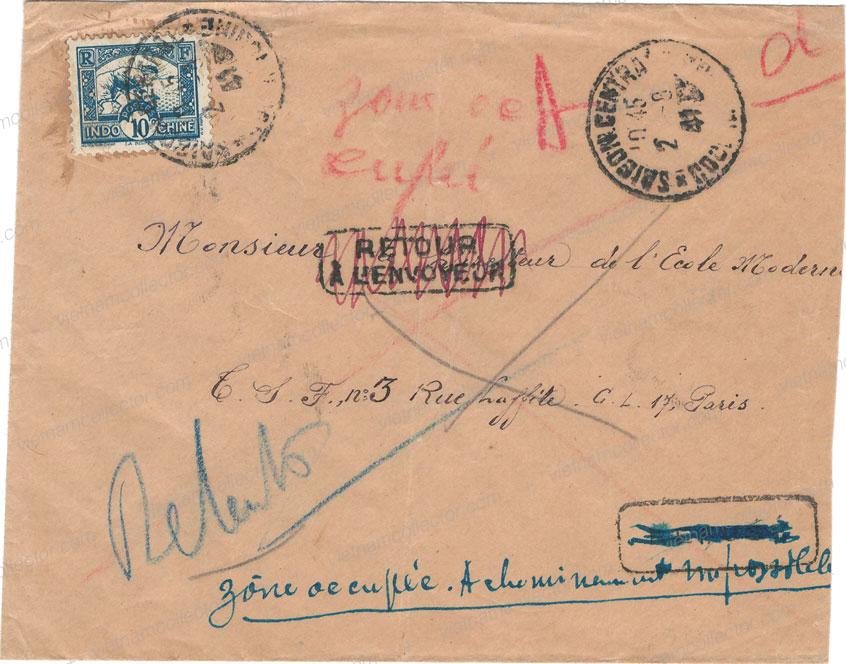
Mixed franking of the 1C (2) and 10C values paying an overall postage of 12C on a domestic letter sent by the Bank of Indochina in Nam Dinh in September of 1940 to a branch in Dalat. This was during World Was II which meant that the letter was subject to censure. However, the bank enjoyed special privileges that exempted it from such censure which was indicated by a red cachet struck in front that read “Banque Privilegied a expedier sans delai Exempt de Censure”. Qui Nhon transit and Hai Phong arrival cancel on the reverse.
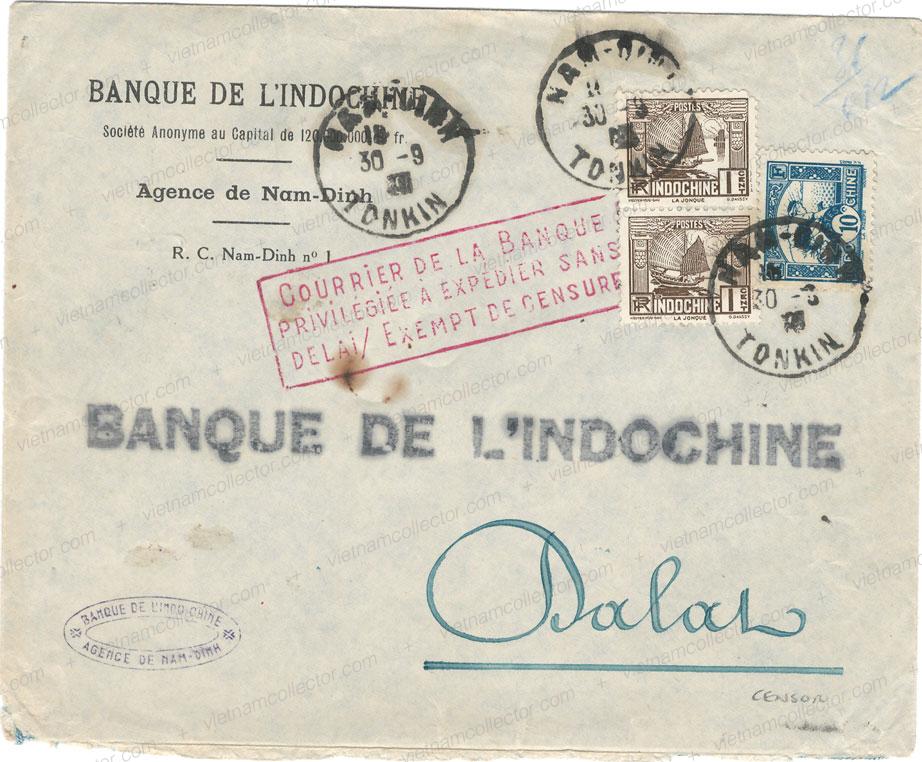
Mixed franking of the 2C and 10C values paying an overall postage of 12C on a domestic letter sent by the Bank of Indochina in Nam Dinh in April of 1940 to a branch in Hai Phong. This was during World Was II which meant that the letter was subject to censure. However, the bank enjoyed special privileges that exempted it from such censure which was indicated by a red cachet struck in front that read “Banque Privilegied a expedier sans delai Exempt de Censure”. Hai Phong arrival cancel on the reverse.
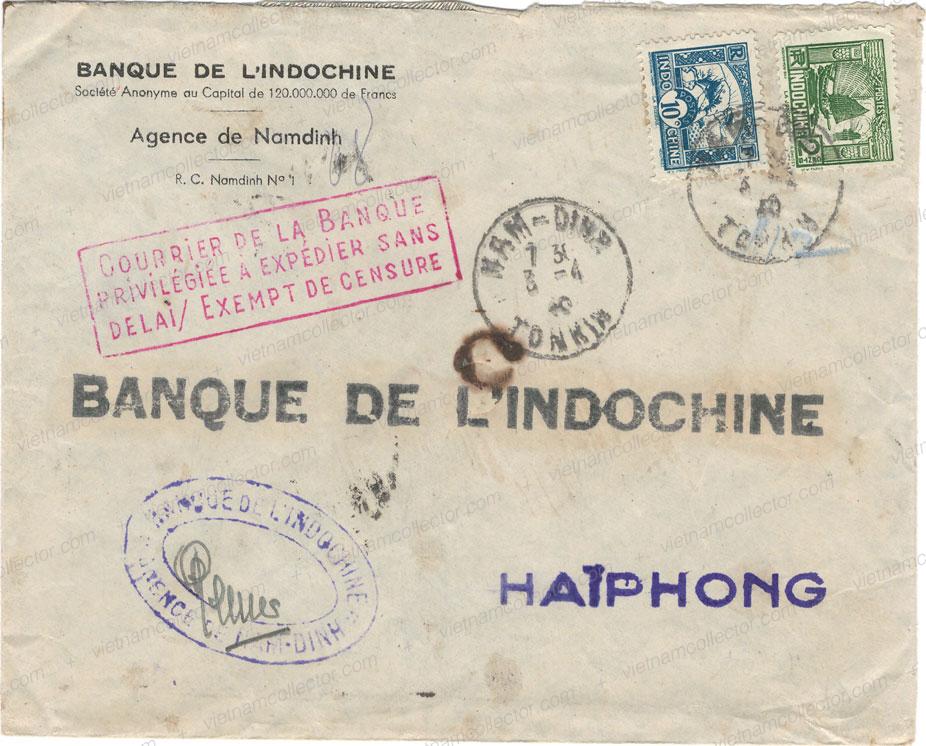
Multiple franking of the 10C (Blue) value paying an overall postage of 20C on a registered domestic letter sent from Long Nguyen to Can Tho in January of 1933. Can Tho arrival cancel on the reverse.
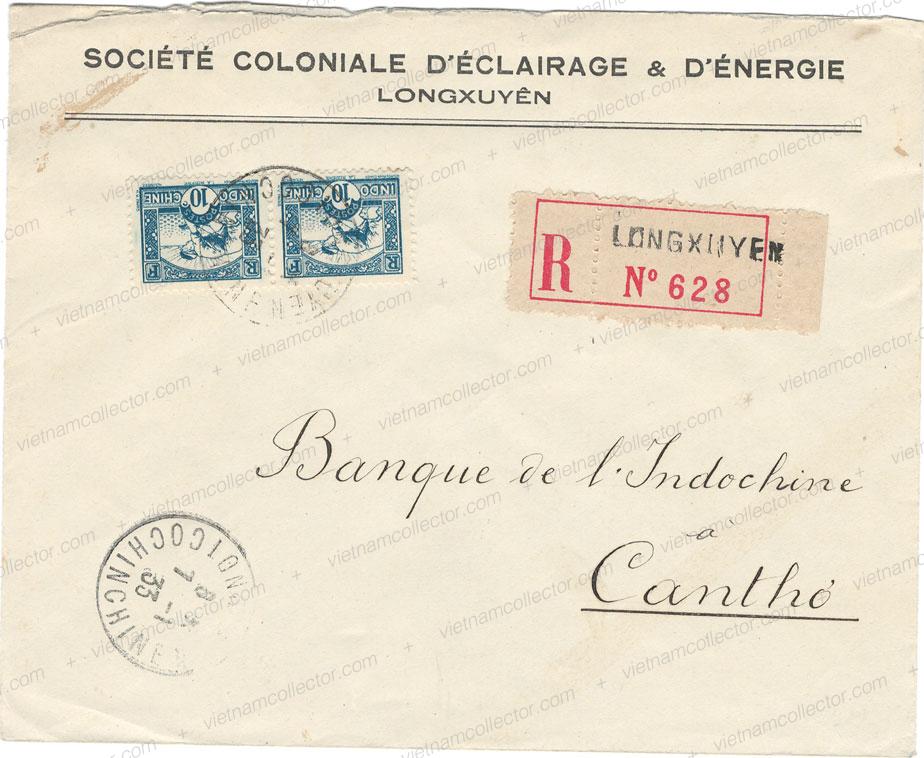
Mixed franking of the 2C, 3C and 10C (2/blue) values paying an overall postage of 25C on an international letter sent by an export company from Hanoi to the United States in November of 1940. This was during World War II and during the Japanese Occupation of Indochina. The letter was hence censured by the Japanese, who continued using the same cachets, cancels and banderoles that the French had used previously. Upon arrival the letter received a cachet that states “Supposed to contain matter subject to the provisions of Executive order 8389 as amended”. It is not quite clear why this was done as the executive order basically applied to German interest (https://en.wikipedia.org/wiki/Executive_Order_8389) but may be in November of 1940 it also applied to France as the country was occupied by the Nazis by then.
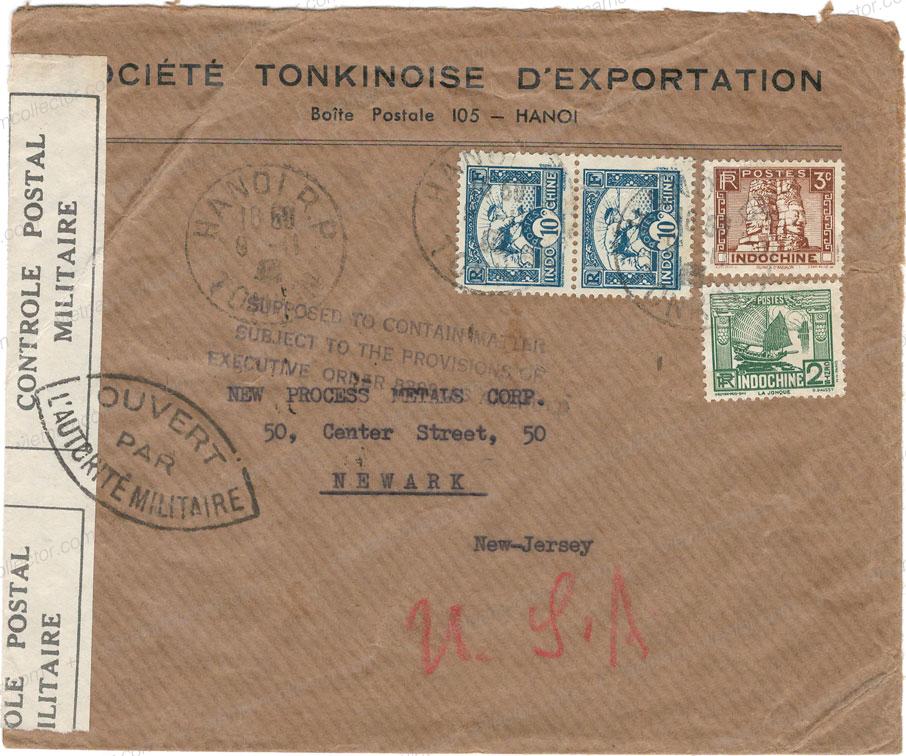
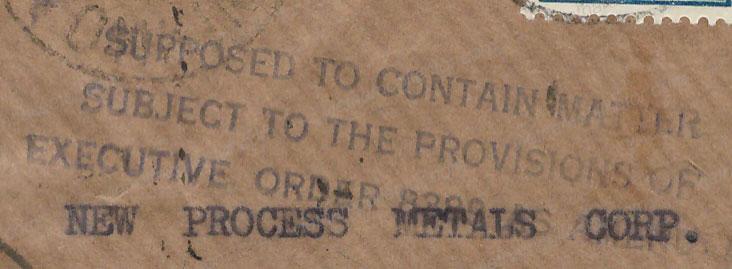
Mixed franking of the 6C, 8C, 10C (ultramarine on pink) and 10C (4/blue on pink) together with the 16C Air mAIl stamp paying an overall postage of 80C on an international printed matter mailing sent to France.
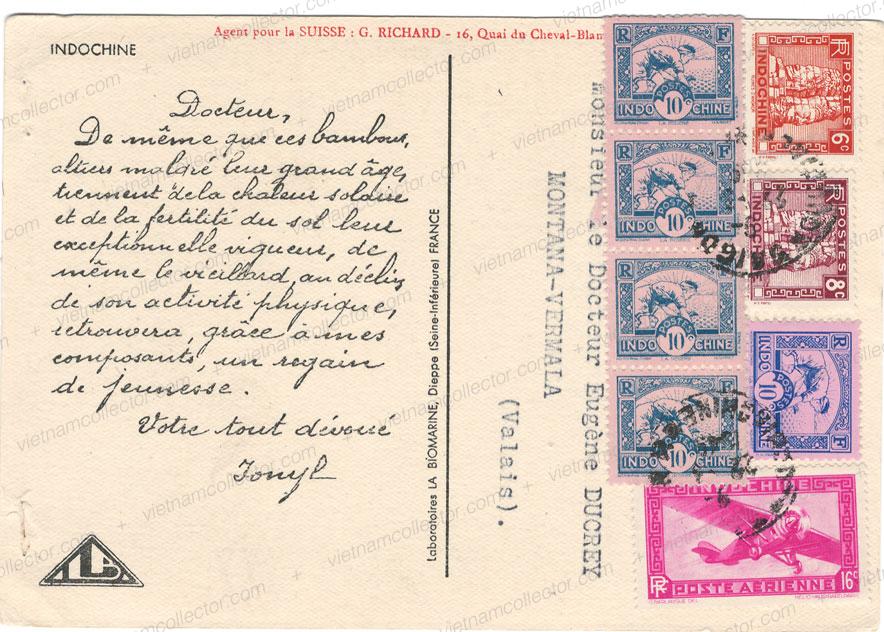 Mixed franking of the 3C (Brown), 7C , 10C (ultramarine on pink) and 10C (blue on pink) paying an overall postage of 30C on an international printed matter mailing sent to France.
Mixed franking of the 3C (Brown), 7C , 10C (ultramarine on pink) and 10C (blue on pink) paying an overall postage of 30C on an international printed matter mailing sent to France.
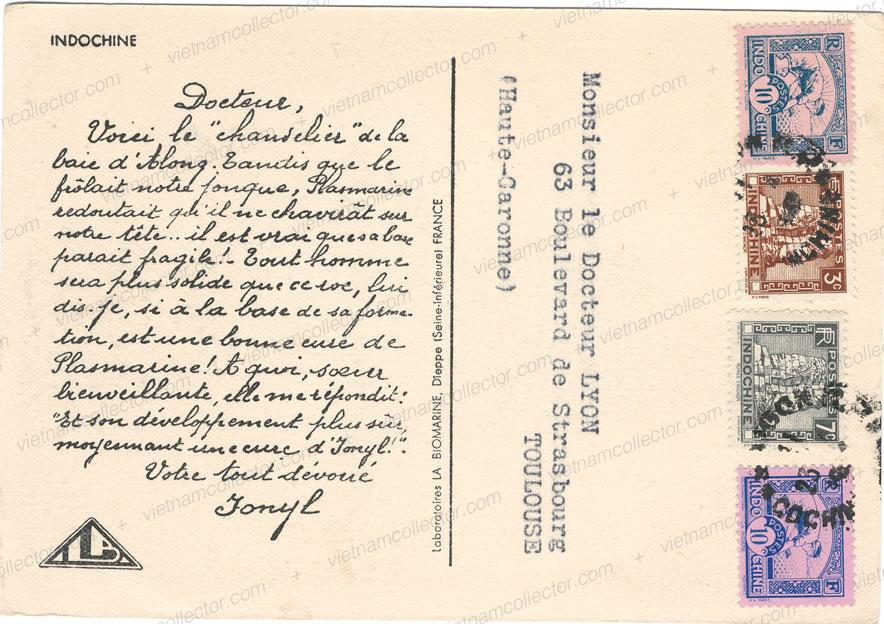
Very rare single franking of the 15C value on newspaper wrapper in which the “Le Lien” a monthly publication was sent from Saigon to Cronenbourg a suburb of Strassburg.
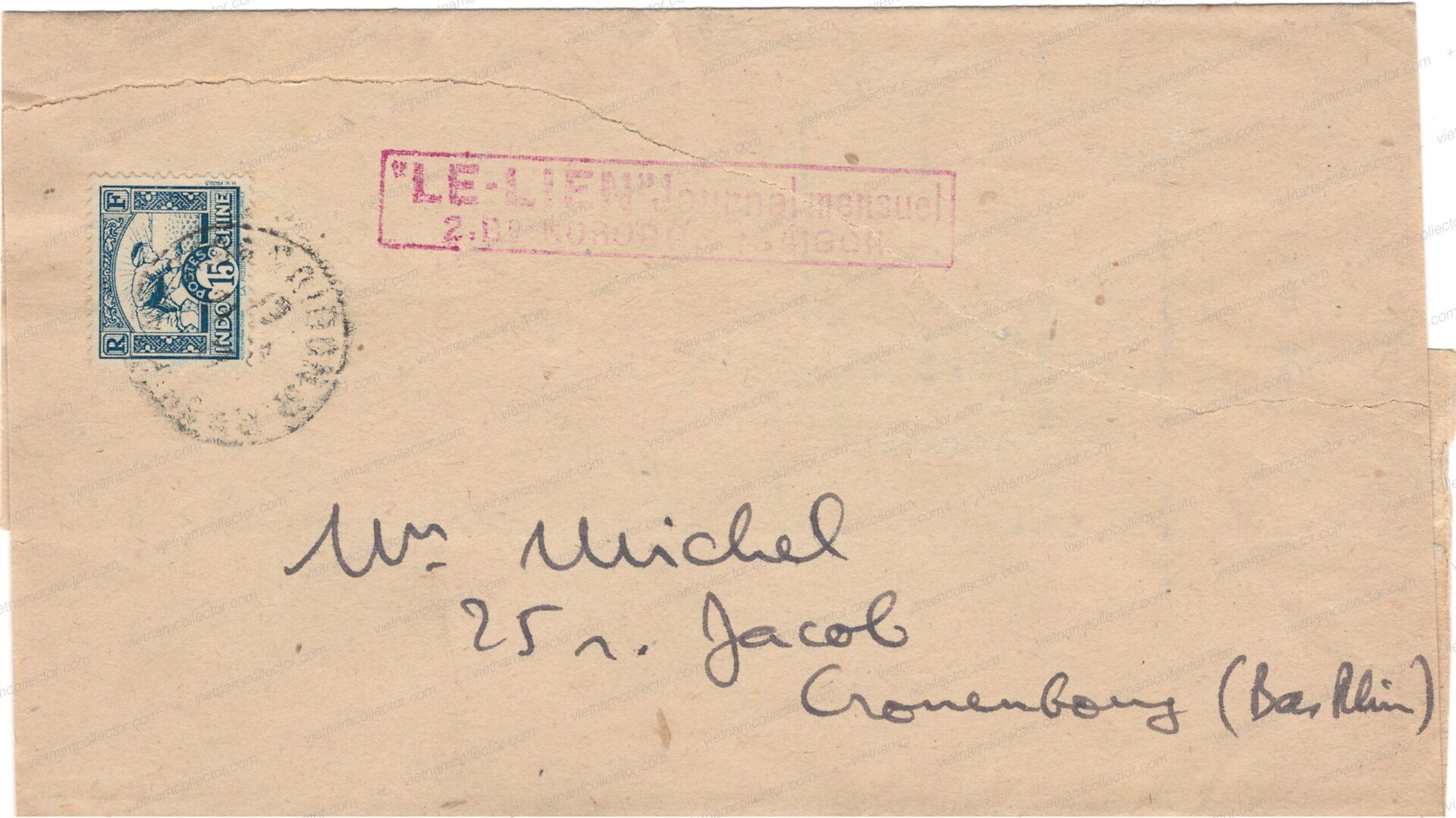
Single franking of the 15C (blue) stamp on a letter sent by a French Naval Officer from Saigon to France in November of 1939. The postage was apparently insufficient and so the letter received a black “T” hand stamp to indicate that additional postage was due upon delivery. A 30C French postage due stamps added in France to collect it. Circular Naval Military cachet on front.
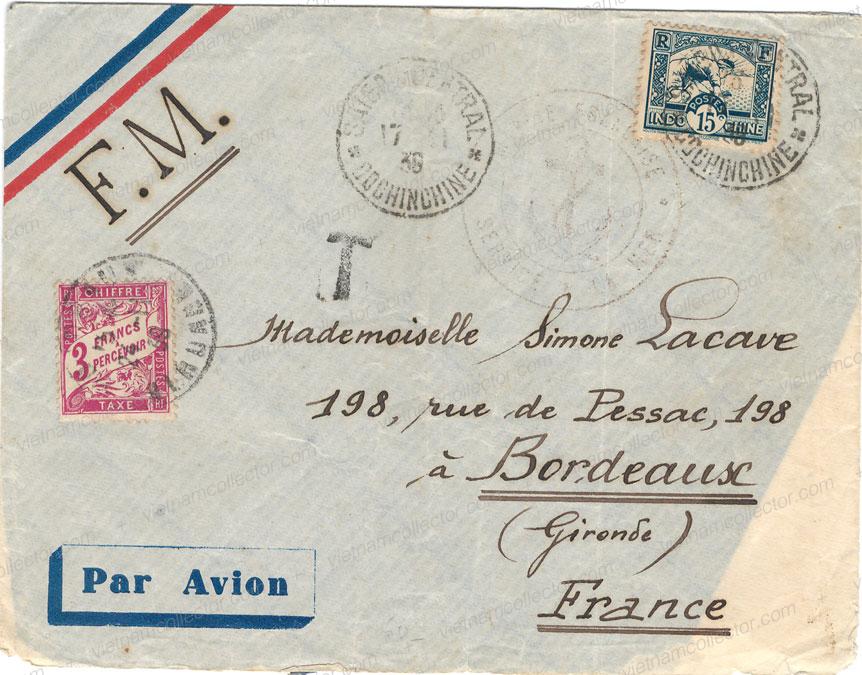 Multiple franking of the 15C (blue) stamp (2) paying an overall postage of 30C on an international letter sent from Hanoi to the United States in August of 1940. While the U.S. only entered World War II in December of 1941 the letter was nevertheless censured by the French as indicated by the “Controle-Postal- Militaire” banderole that was used to re-seal the letter. Hai Phong transit cancel on the reverse.
Multiple franking of the 15C (blue) stamp (2) paying an overall postage of 30C on an international letter sent from Hanoi to the United States in August of 1940. While the U.S. only entered World War II in December of 1941 the letter was nevertheless censured by the French as indicated by the “Controle-Postal- Militaire” banderole that was used to re-seal the letter. Hai Phong transit cancel on the reverse.
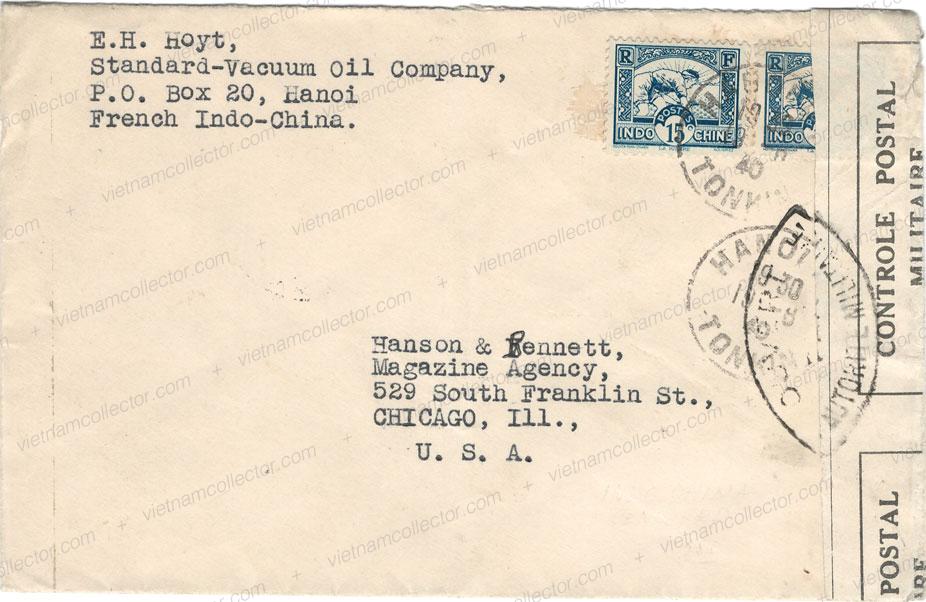 Mixed franking of the 10C (blue) and 15C (blue) stamps paying an overall postage of 25C on an international letter sent from Hanoi to the United States in July of 1941. This was during the time of the Japanese Occupation but prior to Pearl Harbour and so the letter was not censured despite World War II being on. Hanoi and Hai Phong transit cancel on the reverse.
Mixed franking of the 10C (blue) and 15C (blue) stamps paying an overall postage of 25C on an international letter sent from Hanoi to the United States in July of 1941. This was during the time of the Japanese Occupation but prior to Pearl Harbour and so the letter was not censured despite World War II being on. Hanoi and Hai Phong transit cancel on the reverse.
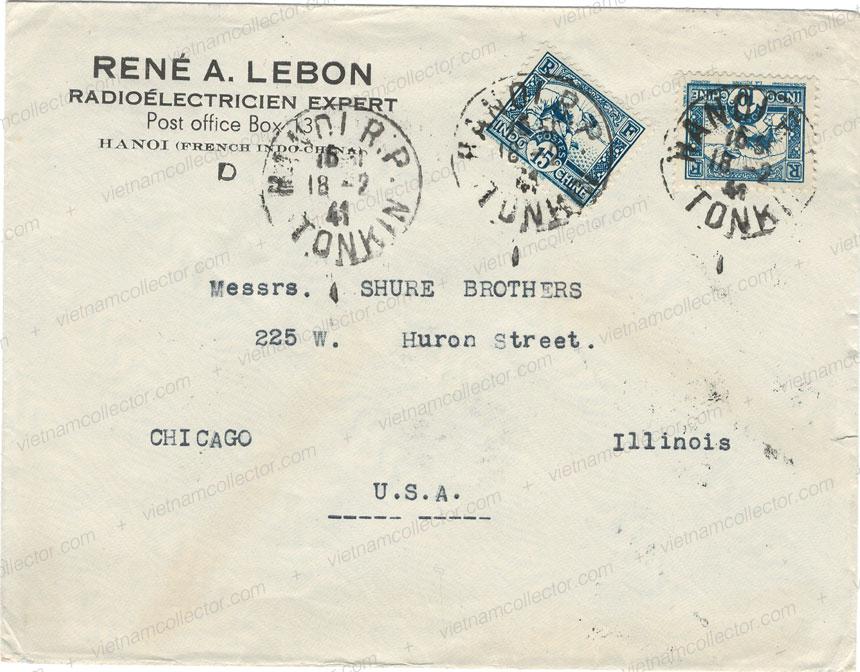
Mixed franking of two 5C Air Mail stamps together with two 15C Domestic Scences stamps paying the proper international rate of 40C on a rare international letter sent from Phnom Penh to Singapore in February 1944. Both, Singapore and Indochina were occupied by the Japanese Army at the time so thee letter was not censored. Saigon transfer cancel on the reverse.

Multiple franking of the 15C lilac-brown and 21C Domestic Scenes II stamps paying an overall postage of 36C on an international air mail letter sent from Chau Doc to France in July of 1933. Saigon transit and French arrival cancel on the reverse.
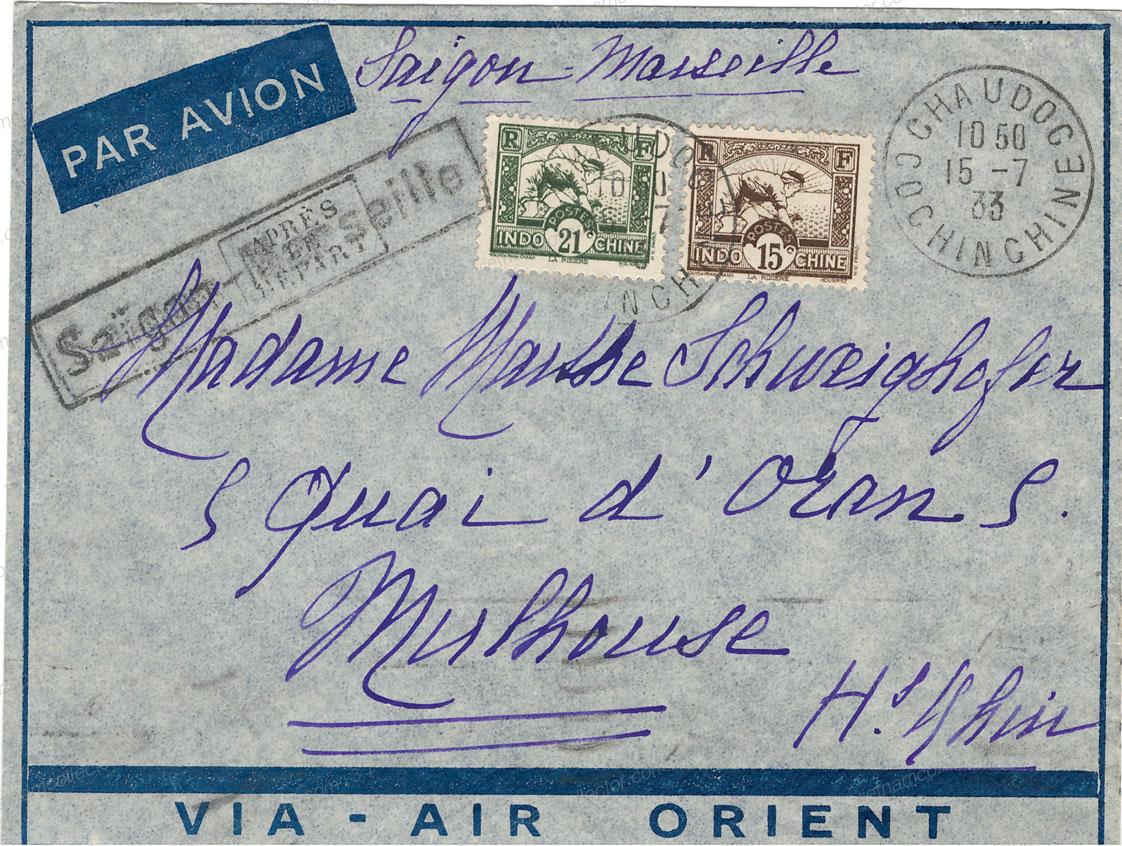
Mixed franking of the 37C Railway stamp together with the 18C Domestic Scences II stamp paying an overall postage of 55C on an international registered air mail letter sent from Ba-Na (small post office) to France in July of 1939. Tourane and Hanoi transit cancels.
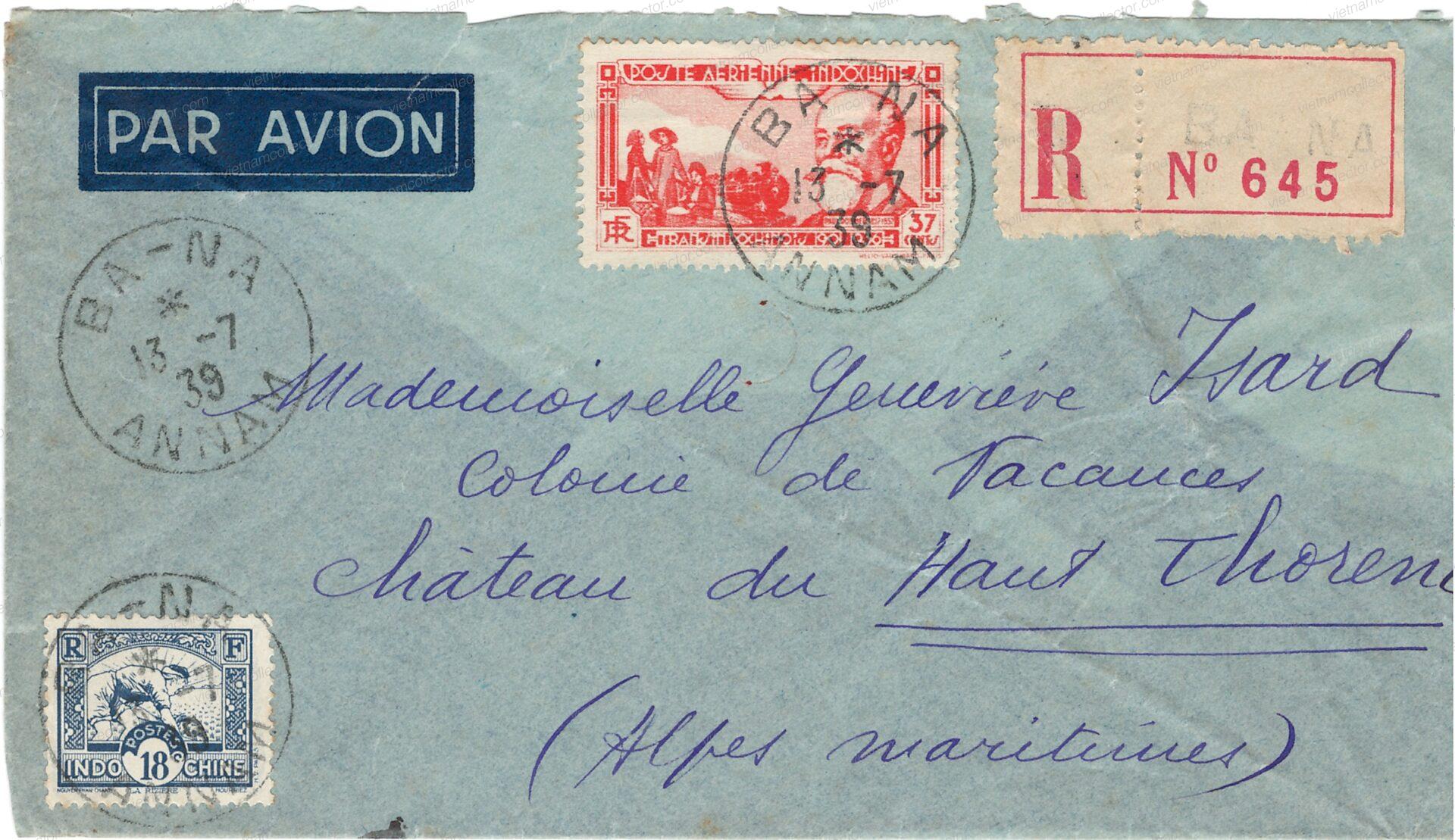
Very rare single franking of the 20C stamp on a newspaper wrapper sent by registered mail from Bien Hoa to Saigon in August of 1936. Saigon arrival cancel on the reverse. Registered printing matter mailings are very hard to find.
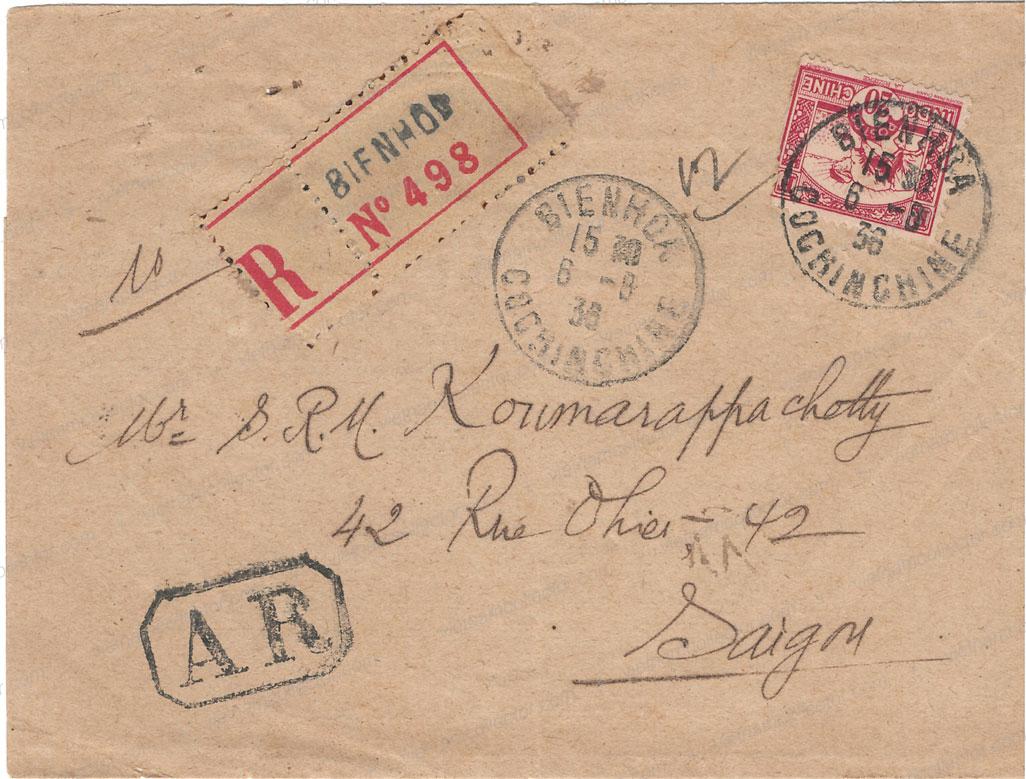
Single franking of the 20C value on a domestic letter sent within Saigon.
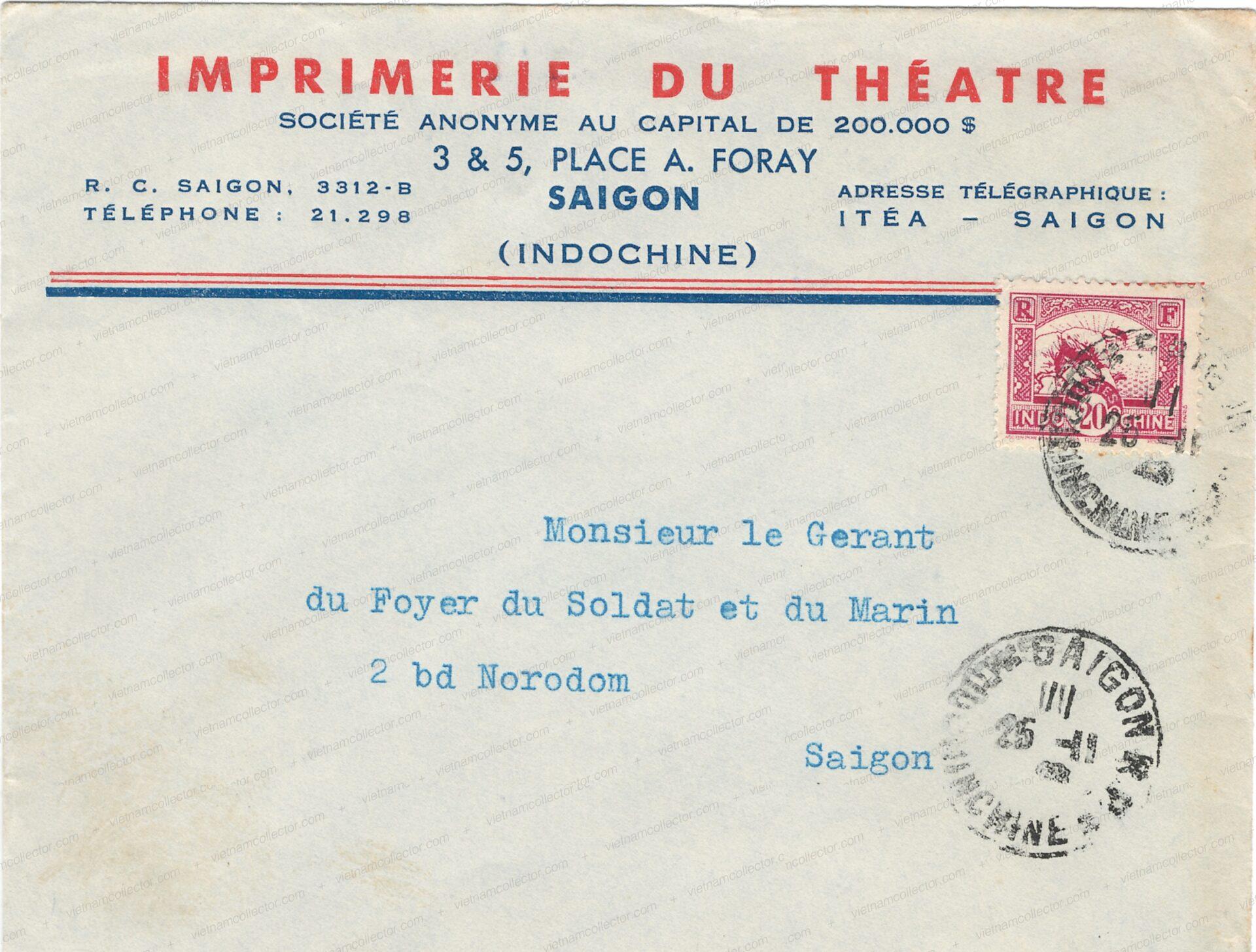
Multiple franking of the 20C value (2) paying an overall postage of 40C on a domestic letter sent from VIeniane, Laos to Saigon in June of 1947. Mail originating in Laos is hard to find as the mail volume from there was generally low.
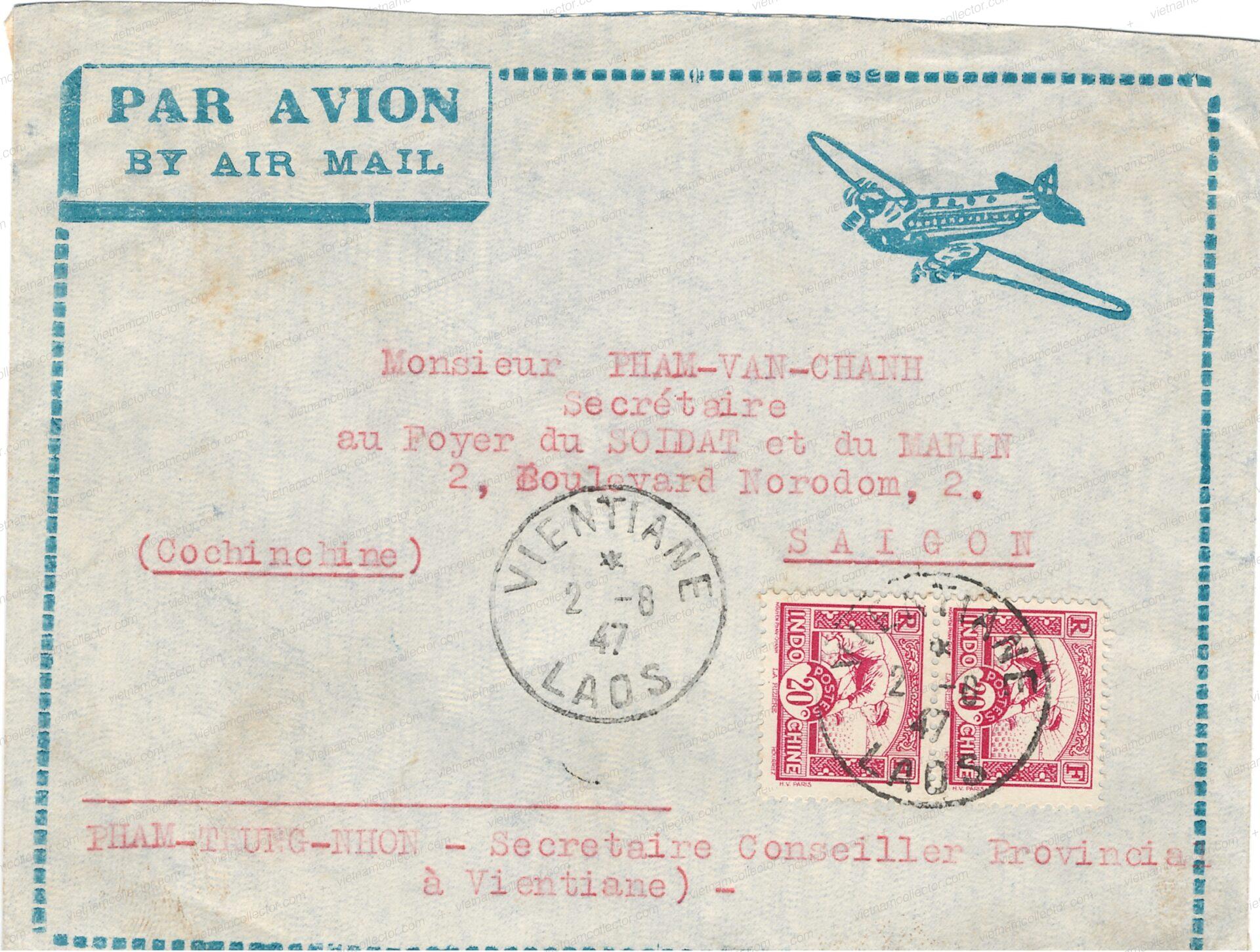
Multiple franking of the 20C value (3) paying an overall postage of 60C on a domestic letter sent within Saigon in September of 1948.
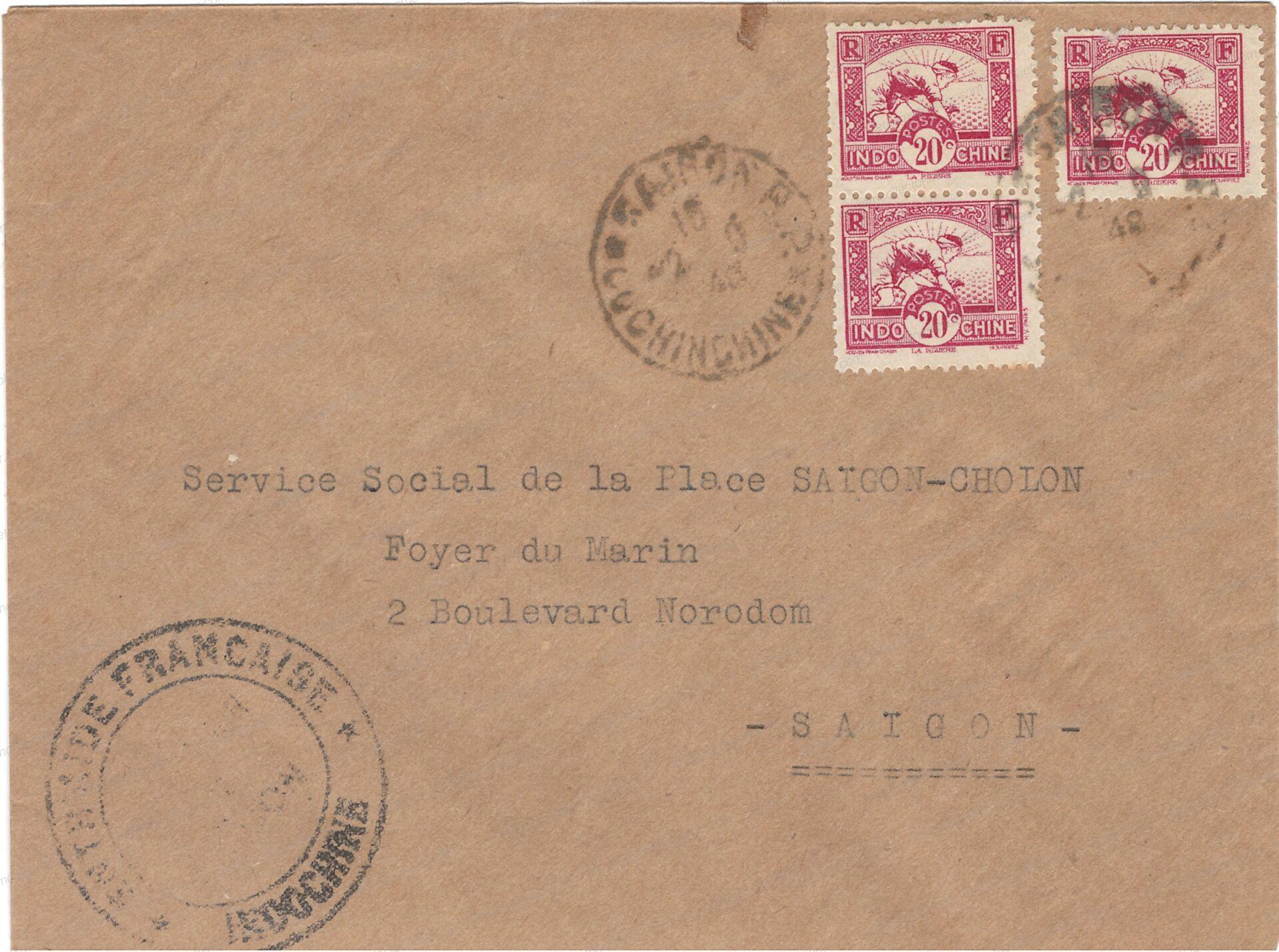
Mixed franking of the 1C, 4C (yellow) and 20C (carmine/small numbers) paying an overall postage of 45C on an international air mail letter sent from Thủ Dầu Một (rare cancel) to Monaco sent in October of 1940. Saigon transit and Monte Carlo arrival cancel on the reverse. Monaco was rather rare destination.
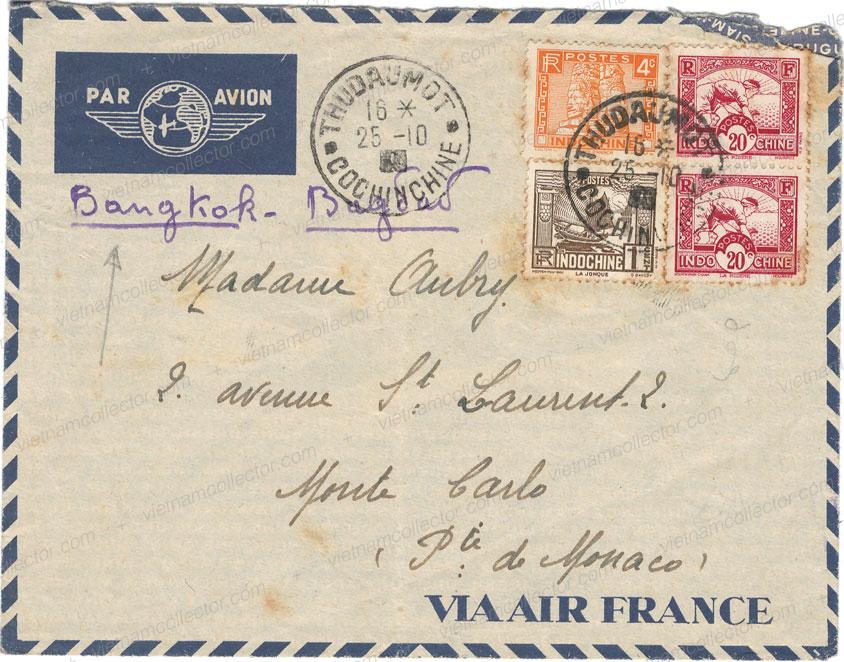 Multiple franking of the 20C (pink-carmine) stamp (12) paying an overall postage of 2.40P on an international air mail letter sent from Han Rang (rare cancel) to France in March of 1949. Saigon transit cancel on the reverse.
Multiple franking of the 20C (pink-carmine) stamp (12) paying an overall postage of 2.40P on an international air mail letter sent from Han Rang (rare cancel) to France in March of 1949. Saigon transit cancel on the reverse.
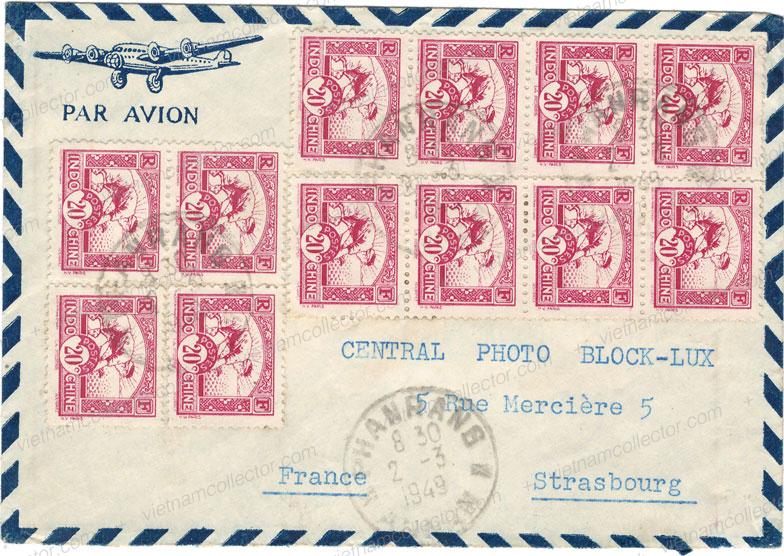 Multiple franking of the 20C (pink-carmine) stamp (9) paying an overall postage of 1.80P on an international air mail letter sent from Saigon (rare rural octagonal cancel) to France in September of 1949.
Multiple franking of the 20C (pink-carmine) stamp (9) paying an overall postage of 1.80P on an international air mail letter sent from Saigon (rare rural octagonal cancel) to France in September of 1949.
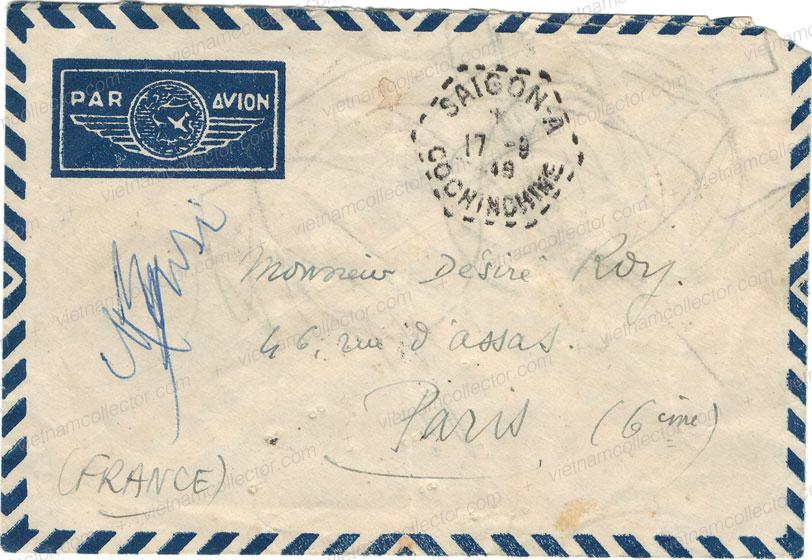
 Mixed franking of the 20C (carmine/small numbers) with other stamps that have fallen off on an air mail letter sent from Saigon to India in May of 1941. The letter was censured by the British upon arrival as indicated by the triangular and boxed censure cachets on front and the banderole tape that was used to re-seal the letter. Indian arrival cancel on the reverse.
Mixed franking of the 20C (carmine/small numbers) with other stamps that have fallen off on an air mail letter sent from Saigon to India in May of 1941. The letter was censured by the British upon arrival as indicated by the triangular and boxed censure cachets on front and the banderole tape that was used to re-seal the letter. Indian arrival cancel on the reverse.
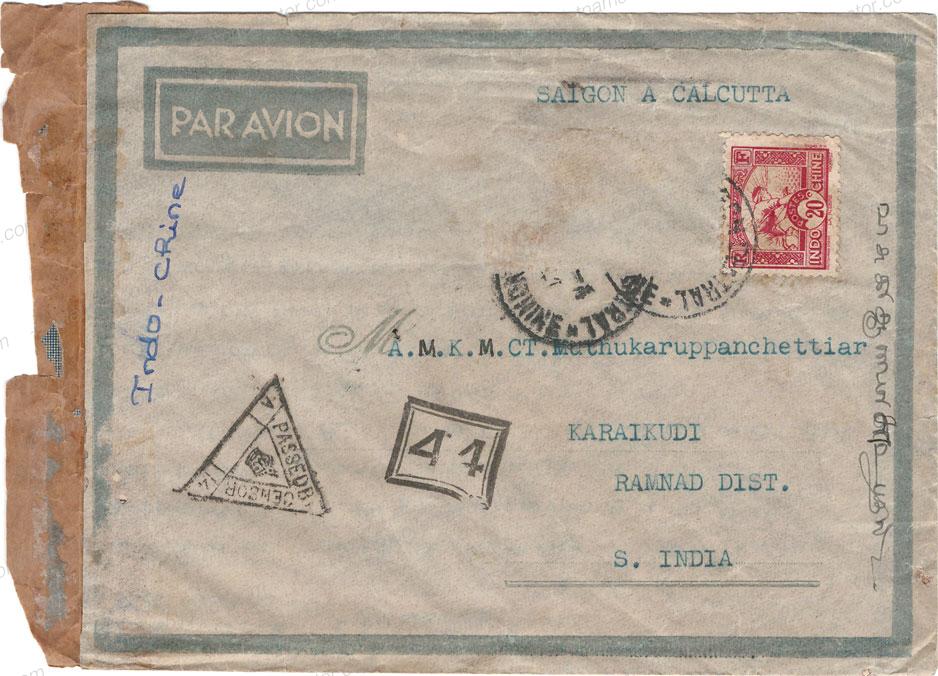 Single franking of the 20C (Carmine/large numbers) on a registered international letter (contents preserved) sent from Vinh Long to India in July of 1933. Various Indian arrival cancels on the reverse.
Single franking of the 20C (Carmine/large numbers) on a registered international letter (contents preserved) sent from Vinh Long to India in July of 1933. Various Indian arrival cancels on the reverse.
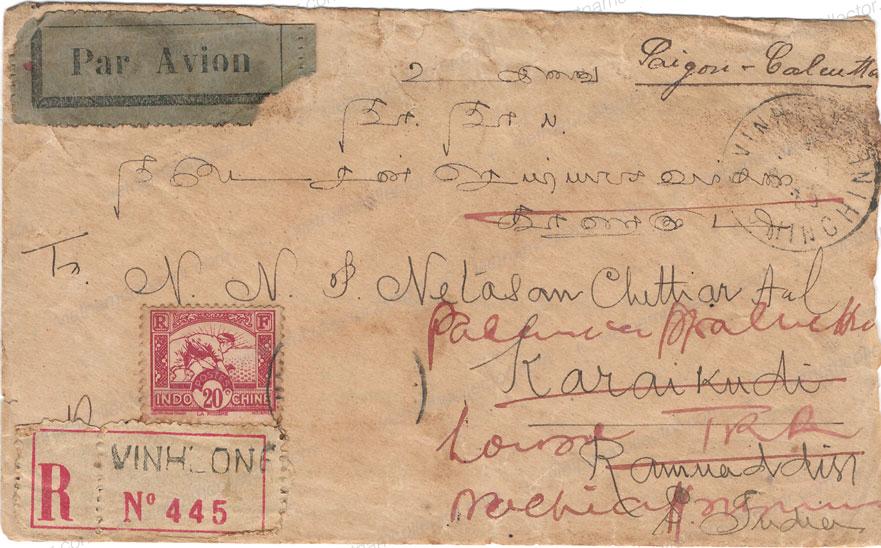 Single franking of the 20C (Carmine/lareg numbers) stamp on a domestic registered letter sent from Pnom Penh, Cambodia to Saigon in January of 1936. Saigon arrival cancel on the reverse.
Single franking of the 20C (Carmine/lareg numbers) stamp on a domestic registered letter sent from Pnom Penh, Cambodia to Saigon in January of 1936. Saigon arrival cancel on the reverse.

Mixed franking of the 20C Domestic Scenes II stamp (carmine/large numbers) in a rare gutter-pair together with the 5P Air mail stamp paying an overall postage pf 5.40P on an international air mail letter sent from Hai Phong to France in February of 1949. Gutter-pairs on postally used letters are very hard to find. Paris arrival cancel on the reverse.
 Mixed franking of the 20C (2/carmine/large numbers) and 15C (blue) stamps paying an overall postage of 55C on an international registered air mail letter (full contents preserved) sent from Vinh Long to India in June of 1935. Saigon transit and various Indian arrival cancels on the reverse.
Mixed franking of the 20C (2/carmine/large numbers) and 15C (blue) stamps paying an overall postage of 55C on an international registered air mail letter (full contents preserved) sent from Vinh Long to India in June of 1935. Saigon transit and various Indian arrival cancels on the reverse.
 Mixed franking of the 20C (Carmine/large numbers) paying an overall postage of 40C on an international air mail letter sent from Saigon to India in September of 1935. Two Indian arrival cancels on the reverse.
Mixed franking of the 20C (Carmine/large numbers) paying an overall postage of 40C on an international air mail letter sent from Saigon to India in September of 1935. Two Indian arrival cancels on the reverse.
 Mixed franking of the 20C (Pink-carmine) paying an overall postage of 40C on an international air mail letter sent from Saigon to France in April of 1948. Exposition de Sud Vietnam cachet on front.
Mixed franking of the 20C (Pink-carmine) paying an overall postage of 40C on an international air mail letter sent from Saigon to France in April of 1948. Exposition de Sud Vietnam cachet on front.
 Mixed franking of the 20C (carmine/small numbers) paying an overall postage of 40C on an international air mail letter sent from Saigon to the United States in March of 1941. While the United States did not enter World War II until December, 1941 the letter was nevertheless censured by the Japanese, who had occupied Indochina at the time. The Japanese continued to use the old French censor cachet and banderoles.
Mixed franking of the 20C (carmine/small numbers) paying an overall postage of 40C on an international air mail letter sent from Saigon to the United States in March of 1941. While the United States did not enter World War II until December, 1941 the letter was nevertheless censured by the Japanese, who had occupied Indochina at the time. The Japanese continued to use the old French censor cachet and banderoles.
 Multiple franking of the 21C value (14) paying an overall postage of 2.94P on an international air mail letters ent from Hanoi to France in December of 1946.
Multiple franking of the 21C value (14) paying an overall postage of 2.94P on an international air mail letters ent from Hanoi to France in December of 1946.


Mass multiple franking of the 21C value (20) paying an overall postage of 4.20P on an international air mail letter (full contents preserved) sent from Hanoi to France in December of 1948.


Mixed franking of the 9C (4) and 21C Domestic Scenes II stamps (3) together with the 2P stamp overprinted for the free port Kong Tcheou and paying an overall postage of 2.99C on an international air mail letter sent to France.


Mixed franking of the 6C and 22C values paying an overall postage of 28C on a registered domestic letter sent by the Bank of Indochina in March of 1940 to a branch in Hai Phong. This was during World Was II which meant that the letter was subject to censure. However, the bank enjoyed special privileges that exempted it from such censure which was indicated by a red cachet struck in front that read “Banque Privilegied a expedier sans delai Exempt de Censure”. Vinh trust cancel on front. Hai Phong arrival cancel on the reverse.
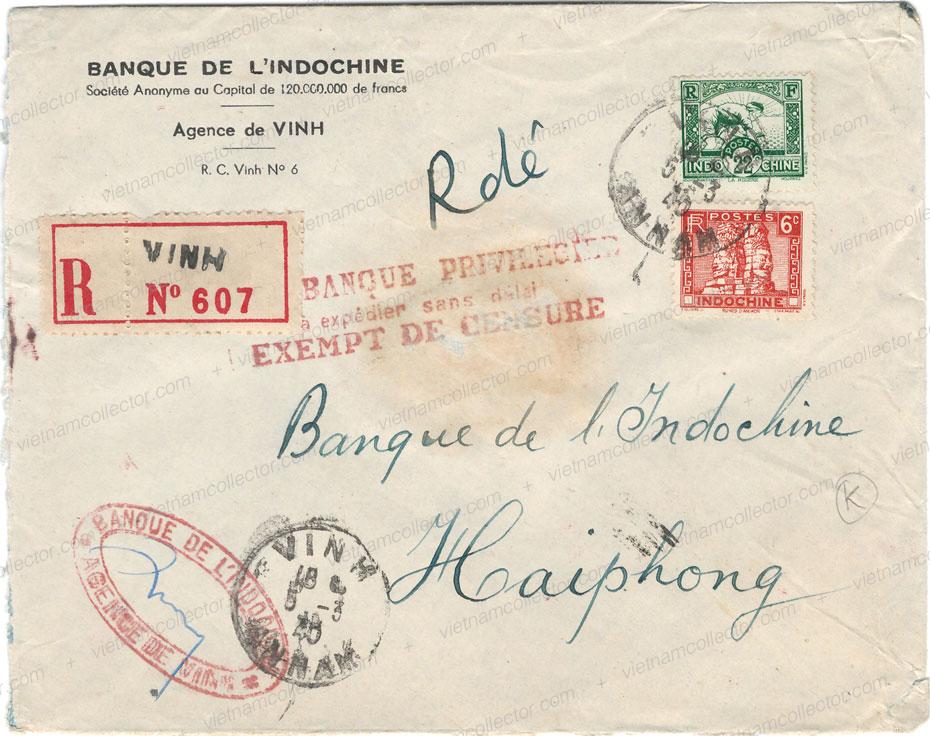
Single franking of the 25C (violet-purple) stamp on an international registered letter sent from Saigon to India in September of 1932. Two Indian arrival cancels on the reverse.
 Mixed franking of the 10C (blue) and 25C (violet-purple) stamps paying an overall postage of 70C on an international air mail letter sent from Saigon to France in April of 1933. Red circular aircraft control and black boxed “Saigon-Marseille” cachets on front. Marseille machine arrival cancel on the reverse.
Mixed franking of the 10C (blue) and 25C (violet-purple) stamps paying an overall postage of 70C on an international air mail letter sent from Saigon to France in April of 1933. Red circular aircraft control and black boxed “Saigon-Marseille” cachets on front. Marseille machine arrival cancel on the reverse.
 Multiple franking of the 25C (5/blue) paying an overall postage of 1.25C on an international air mail letter sent from Saigon to India. Indian arrival cancel on the reverse.
Multiple franking of the 25C (5/blue) paying an overall postage of 1.25C on an international air mail letter sent from Saigon to India. Indian arrival cancel on the reverse.
 Multiple franking of the 30C value (two of which represent a rare gutter-pair) paying an overall postage of 1.80P on an international letter sent from Da Lat to France in December of 1948. Boxed “Apres de Depart” cachet on front. Postal used Gutter-pairs on cover are very hard to find.
Multiple franking of the 30C value (two of which represent a rare gutter-pair) paying an overall postage of 1.80P on an international letter sent from Da Lat to France in December of 1948. Boxed “Apres de Depart” cachet on front. Postal used Gutter-pairs on cover are very hard to find.

Single franking of the 30C value on a letter sent by a member of the French military to France in April of 1940. Marseille was located in the Vichy Government territory allied with the German occupiers. As a result the letter was censured by the French military prior to departure as evidenced by the center cachet and banderole.

Mixed franking of the 15C and 30C Domestic Scenes II stamps on an international letter sent from Saigon to France via Lydda in Palestine on October 1st, 1940. A little over a year earlier World War II had broken out and as a result the letter was censured by what appears the French in Saigon and the English in Palestine. October 1st was shortly after the open hostilities between the French and the Japanese had ended (September 26th). While the Japanese ultimately left the French in charge of public administration we do know that they took over military censorship using the exact same banderoles the French had used. But since we do not know when this take-over actually happened we do not know if it was the French or the Japanese that censored the letter. Since civilian and military convoys were attacked ferociously at that time the letter got stuck at some point in its route and a violet hand cachet “Retour A L’Enyoyeor Relations Postales Interrompues” was applied that sent the letter back to the sender.
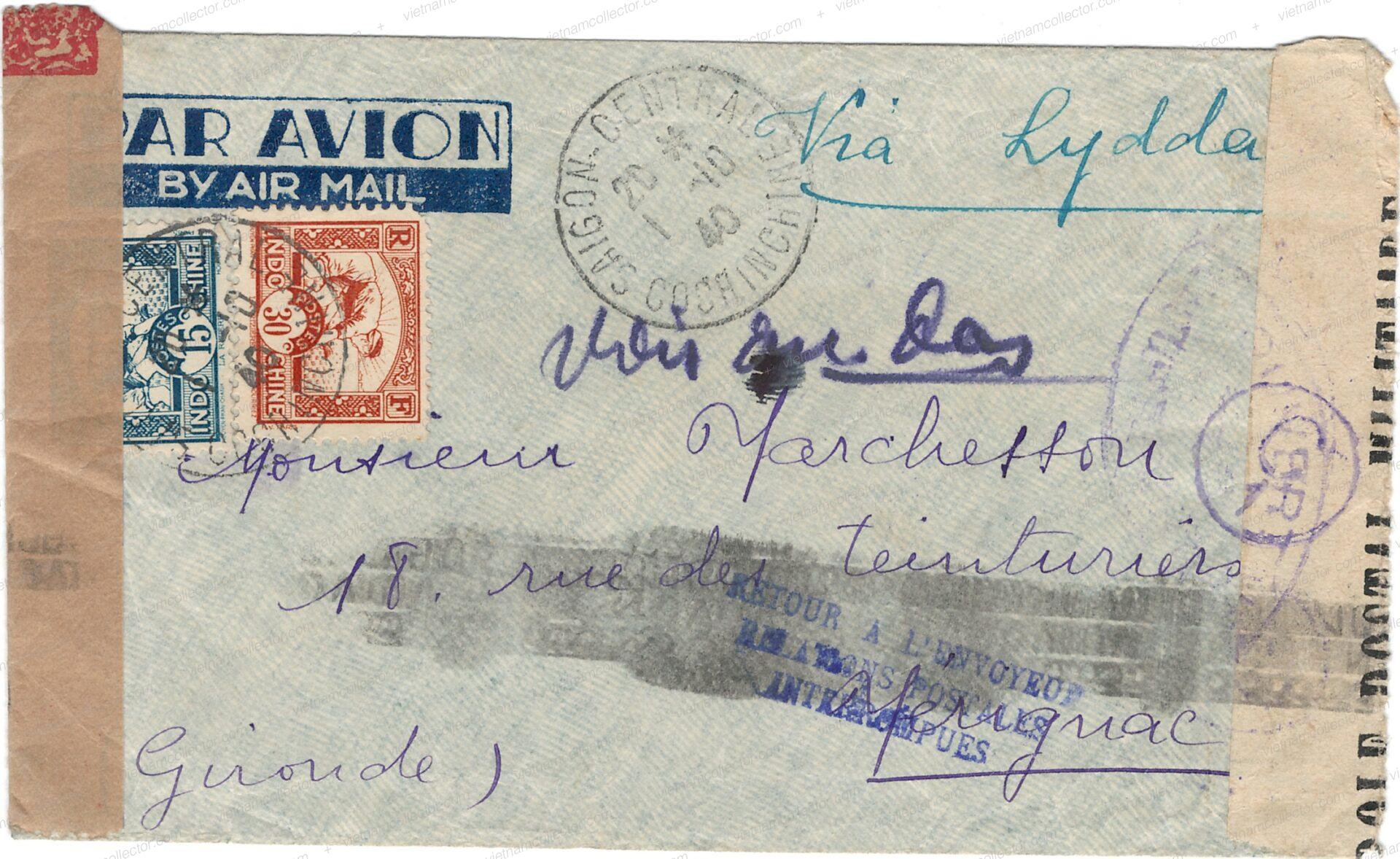
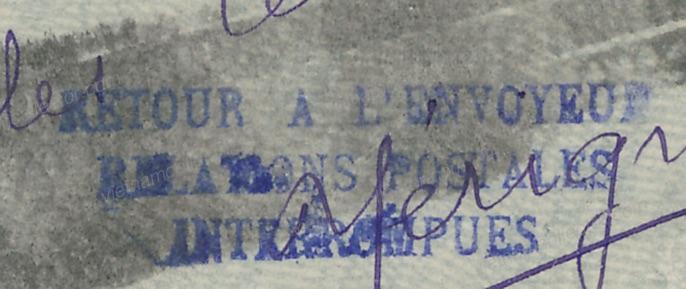
Mixed franking of the 6C and 30C values paying an overall postage of 36C on an international air mail letter sent from Konpong Chang (rare cancel), Cambodia to France in April of 1933. Pnom Penh transit cancel on the reverse. “PAR AVION JUSOUA-MARSEILLE” cachet on front.
 Multiple franking of the 30C value (4) paying an overall postage of 1.20P on an international air mail letter sent from Saigon to India in September of 1947. Indian arrival cancel on the reverse.
Multiple franking of the 30C value (4) paying an overall postage of 1.20P on an international air mail letter sent from Saigon to India in September of 1947. Indian arrival cancel on the reverse.
 Multiple franking of the 30C value (3) paying an overall postage of 90C on an international air mail letter sent from Nam Dinh to France in October of 1941. This was during the Japanese Occupation. As result the letter was censured by the Japanese occupiers that continued to use the old French censor cachets and banderoles. Hanoi transit and French arrival cancel on the reverse.
Multiple franking of the 30C value (3) paying an overall postage of 90C on an international air mail letter sent from Nam Dinh to France in October of 1941. This was during the Japanese Occupation. As result the letter was censured by the Japanese occupiers that continued to use the old French censor cachets and banderoles. Hanoi transit and French arrival cancel on the reverse.
 Mixed franking of the 15C (Blue) and 30C stamps paying an overall postage of 45C on an international air mail letter sent from Saigon to India in January of 1941. The letter was censored by the British upon arrival s indicated by the “Passed by Cenor 223” cachet and banderole used to re-seal the letter. Indian arrival cancel on the reverse.
Mixed franking of the 15C (Blue) and 30C stamps paying an overall postage of 45C on an international air mail letter sent from Saigon to India in January of 1941. The letter was censored by the British upon arrival s indicated by the “Passed by Cenor 223” cachet and banderole used to re-seal the letter. Indian arrival cancel on the reverse.
 Mixed franking of the 5C (lilac), 20C (carmine/small numbers) and 30C stamps paying an overall postage of 55C on an international air mail letter sent from Saigon to the United States in June of 1940. The letter was censured while in transit in Singapore by the British as indicated by the triangular censor cachet on front. Washington D.C. arrival cancel on the reverse.
Mixed franking of the 5C (lilac), 20C (carmine/small numbers) and 30C stamps paying an overall postage of 55C on an international air mail letter sent from Saigon to the United States in June of 1940. The letter was censured while in transit in Singapore by the British as indicated by the triangular censor cachet on front. Washington D.C. arrival cancel on the reverse.
 Single franking of the 30C value on an international letter sent from Saigon t India in May of 1941. Th letter was censured by the British upon arrival as evidenced by the triangular center cachet on front and the banderole used to re-seal the letter. Two Indian arrival cancels on the reverse.
Single franking of the 30C value on an international letter sent from Saigon t India in May of 1941. Th letter was censured by the British upon arrival as evidenced by the triangular center cachet on front and the banderole used to re-seal the letter. Two Indian arrival cancels on the reverse.

Mixed franking of the 15C (blue) and 30C stamps paying an overall postage of 45C on an international air mail letter (full content preserved) sent from Saigon to France in June of 1941. This was during the Japanese Occupation. The letter was fenced censured by the Japanese though they continued to use the old French cachets and banderoles. French arrival cancel on the reverse.
 Mixed franking of the 10C and 30C values paying an overall postage of 40C on an international air mail letter (full contents preserved) sent from Can Tho to India in December of 1935. Winged air mail cachet on front. Saigon transit and Calcutta arrival cancels on the reverse. Boxed cachet “DALAT the climate of France in Indochina) advertisement on the reverse.
Mixed franking of the 10C and 30C values paying an overall postage of 40C on an international air mail letter (full contents preserved) sent from Can Tho to India in December of 1935. Winged air mail cachet on front. Saigon transit and Calcutta arrival cancels on the reverse. Boxed cachet “DALAT the climate of France in Indochina) advertisement on the reverse.
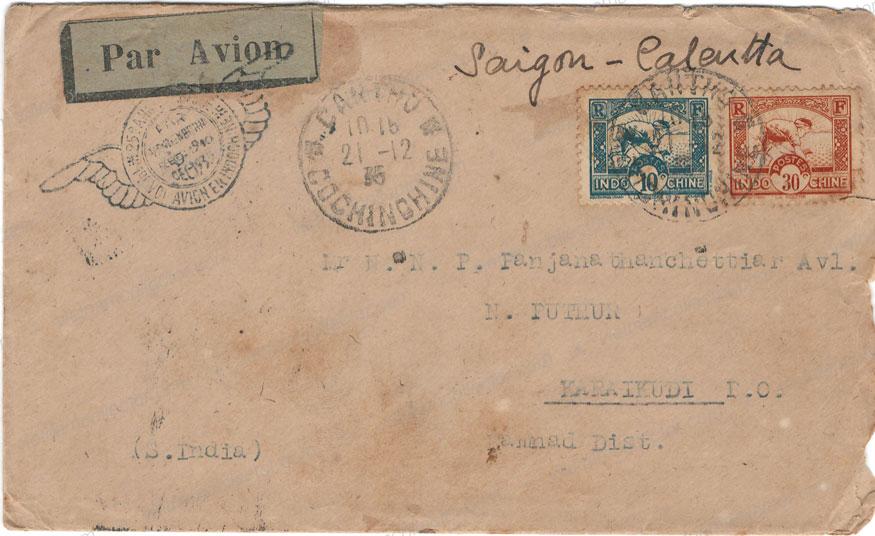
Mixed franking of the 10C (blue) and 30C stamps paying an overall postage fo 40C on an international air mail letter sent from Quang-Yen to France February of 1940. The letter was sent to German occupied France and hence was censored as indicated by the cachets “CONTROLE W 222″and “PAS Pour le SECTEUR POSTAL 21”. Hai-Phong transit cancel on the reverse.

Single franking of the 30C value on an international air mail letter sent from Saigon to France in April of 1933. Boxed “Saigon-Marseille” air mail cachet on front. French arrival cancels on the reverse.

Single franking of the 30C value on an international air mail letter sent from the Residence Superieure in Cambodia, which was the Government building to France. The letter was addressed to Marseille which was situated in the Vichy Government part of France that was allied with the German occupiers. As a result it was censored by the French Military as indicate by the circular censure cachet on front. Violte Government seal on front.

Single franking of the 30C stamp on an international air mail letter sent from the cruiser “Croiseur Gloire” on February 1st, 1938 to France. Since the letter was dropped into a mailbox a cachet was added on front “…a la Boite”. French machine arrival cancel on the reverse.
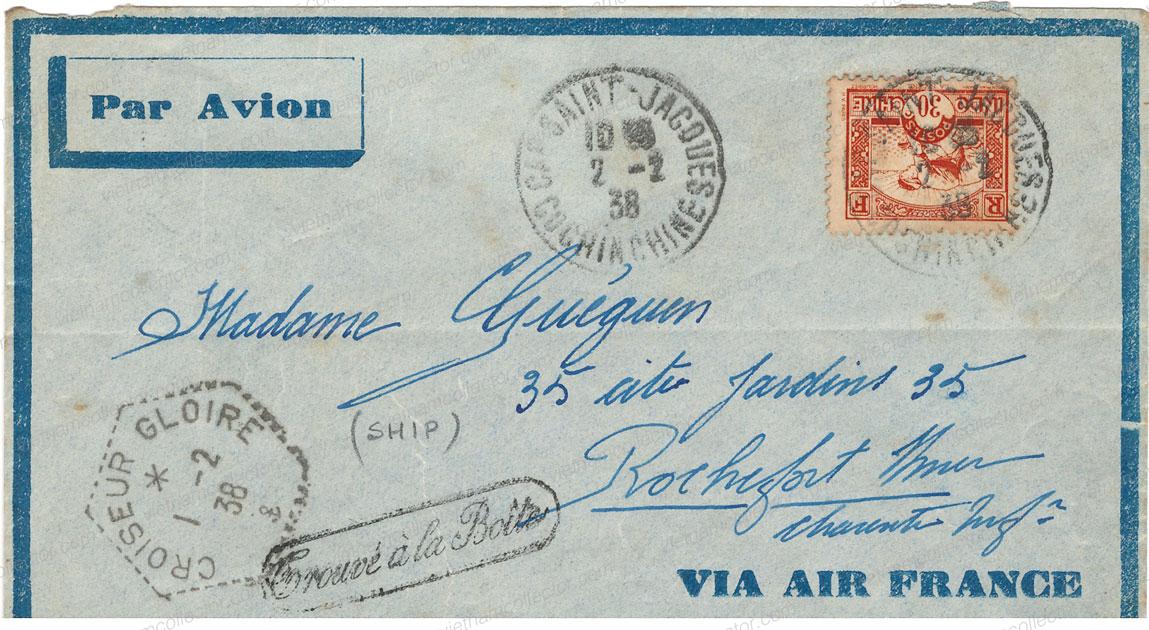
Multiple franking of the 30C value (3) paying an overall postage of 90C on an international air mail letter sent from Saigon to India in November of 1947. Indian arrival cancels on the reverse.
 Multiple franking of the 30C value (4) paying an overall postage of 1.20P on a domestic air mail letter sent from Vinh Long to Can Tho in April of 1950. Can Tho arrival cancels on the reverse.
Multiple franking of the 30C value (4) paying an overall postage of 1.20P on a domestic air mail letter sent from Vinh Long to Can Tho in April of 1950. Can Tho arrival cancels on the reverse.
 Multiple franking of the 30C value (17) paying an overall postage of 5.10P on an international air mail letter sent from Hai Phong to France in February of 1952. French arrival cancels on the reverse.
Multiple franking of the 30C value (17) paying an overall postage of 5.10P on an international air mail letter sent from Hai Phong to France in February of 1952. French arrival cancels on the reverse.

 Mixed franking of the 6C and 30C stamps paying an overall postage of 36C on an international air mail letter sent from Saigon to France in March of 1933. Marseille arrival cancel on the reverse. Laos vignette on front.
Mixed franking of the 6C and 30C stamps paying an overall postage of 36C on an international air mail letter sent from Saigon to France in March of 1933. Marseille arrival cancel on the reverse. Laos vignette on front.

Mixed franking of the 80C Victory stamp together with the 39C Air Mail and 1C Domestic Scences II stamps paying an overall postage of 1.20P on an international air mail letter sent from Saigon to France in December of 1947.
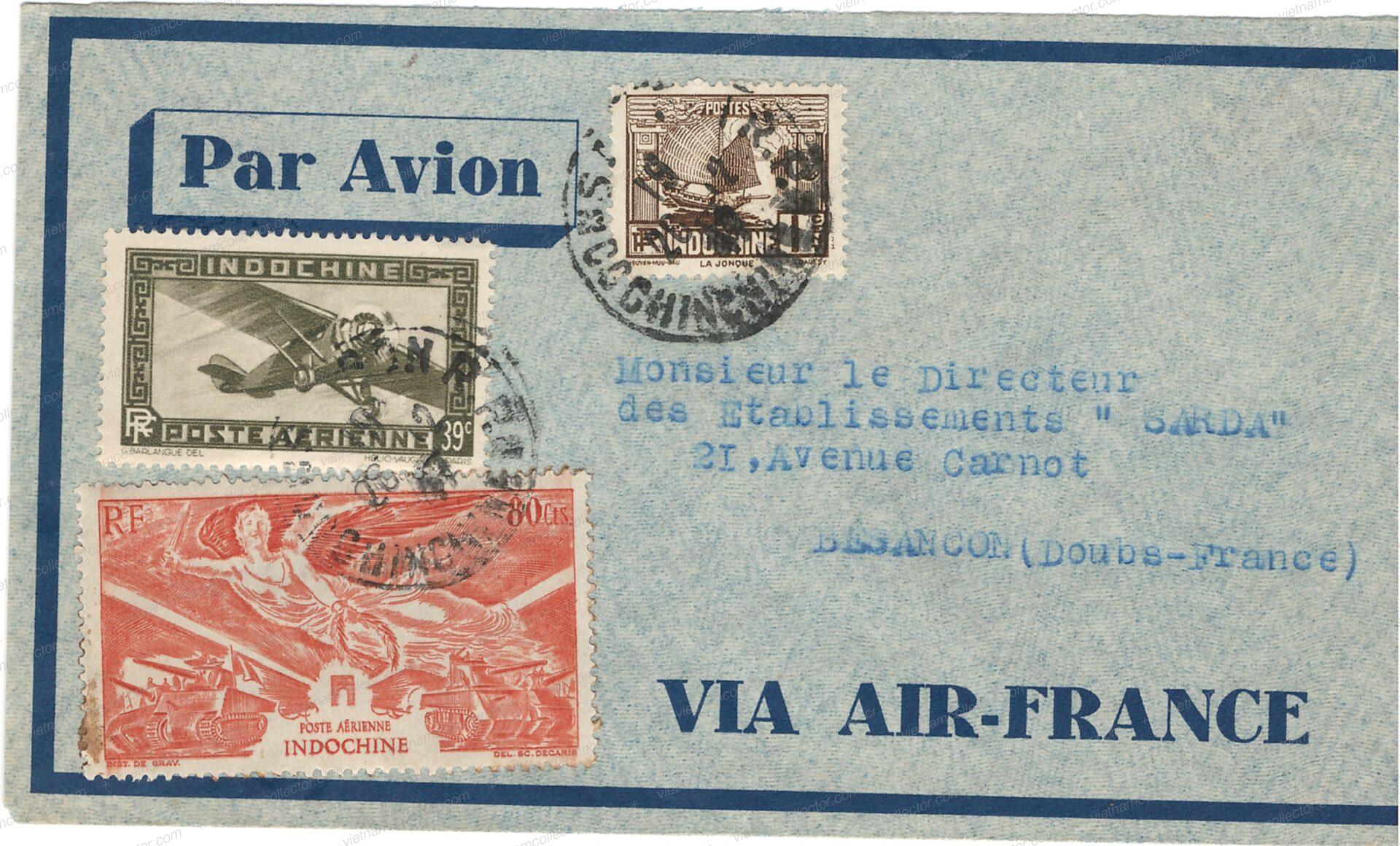
Mixed franking of the 1C, 10C (blue) and 50C values on the 5C postal stationary (14.5×11.3cm) on an international air mail letter sent from Saigon to France in August of 1932. Saigon-Marseille air mail and red circular air craft verification cachet on front. Marseille machine transit and Pantin arrival cancel on the reverse.
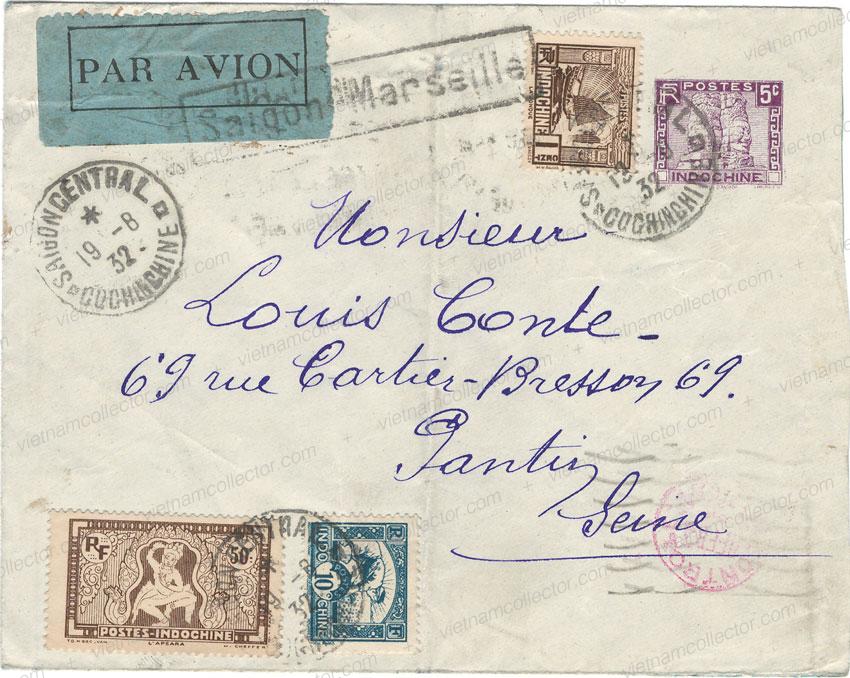
Mixed franking of the 5C (lilac) and 50C value paying an overall postage of 55C on an international air mail letter sent from Soc Trang to India in June of 1940. Th letter was censored twice, once by the French Military prior to departure and then again by the British upon arrival in India as evidenced by the various censure cachets and censor banderol. Various Indian arrival cancels on the reverse.

Mixed franking of the 1P Kingdom Cambodia value together with stamps from the Domestic Scenes II set paying an overall postage of 1.85P on a registered domestic letter sent by the Bank of Indochina in Saigon in August of 1940 to a branch in Vichy. Three stamps carry the Bank of Indochina perrin that was applied to protect from internal theft. This was during World Was II which meant that the letter was subject to censure. However, the bank enjoyed special privileges that exempted it from such censure inside Indochina which was indicated by a red cachet struck in front that read “Banque Privilegied a expedier sans delai Exempt de Censure”. However, the privilege did not extend to other countries and so the letter was censured by the British in Hong Kong as indicted by the black and white censure tape. French arrival cancel on the reverse.
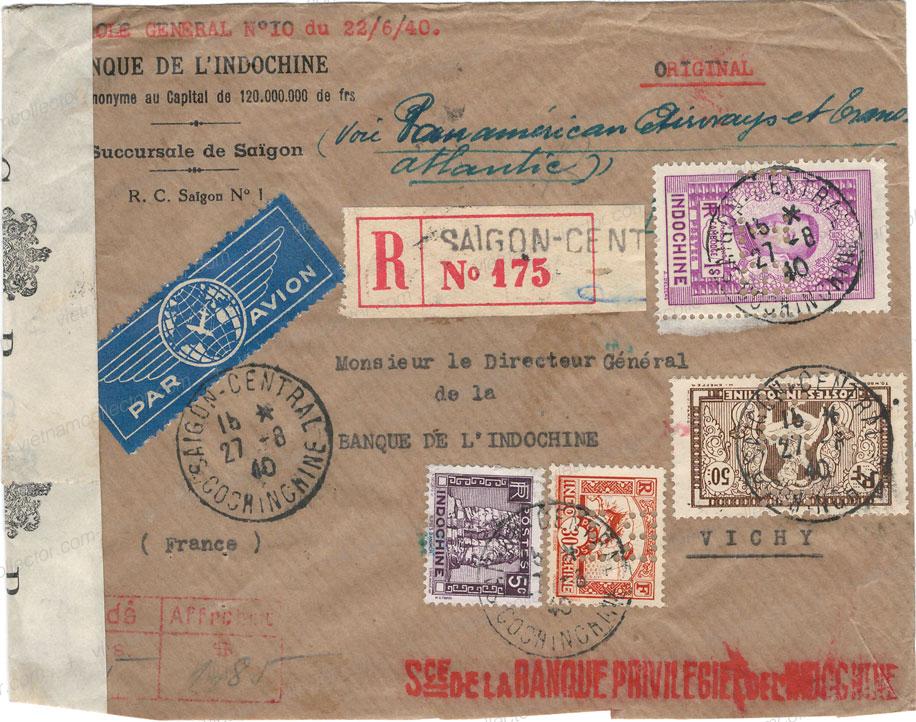
Very rare mixed franking of the 15C (blue) and 50C stamps paying an overall postage of 65C on a registered international letter sent from Saigon to Japan. This was during the Japanese Occupation of Indochina. The bank was privileged as it was exempt from the standard mail censure even during that time as indicated by the red hand stamp “Sce de la Banque Privilege del Indochine”.
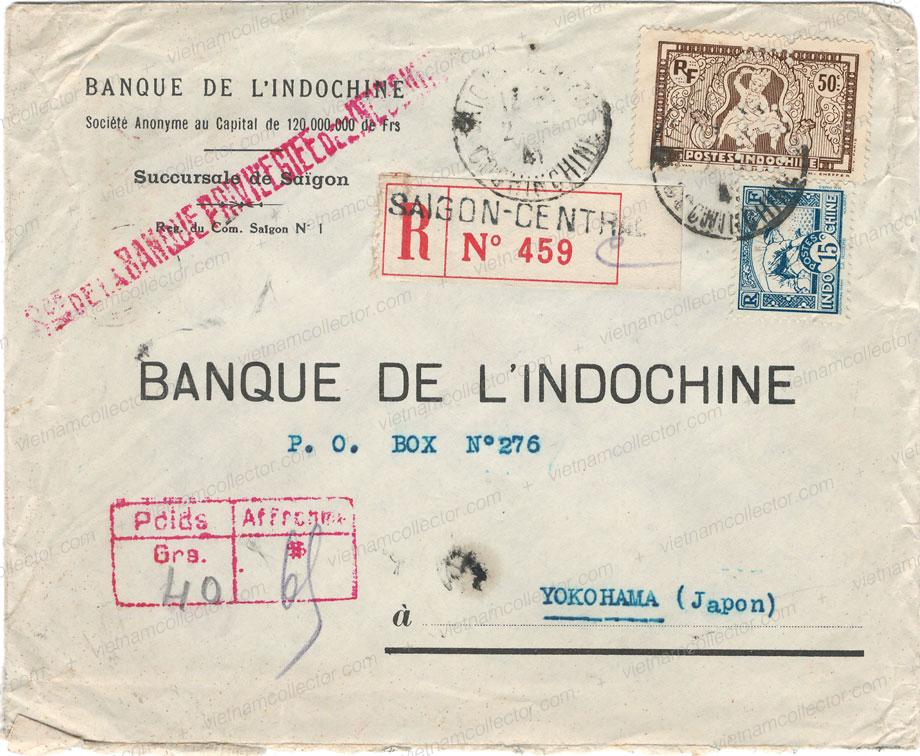
Multiple franking of the 50C value (3) paying an overall postage of 1.50P on an international letter front sent in October of 1949. Black cachet “Inusfficient Franking for Air Mail Service” applied on front.
 Mixed franking of the 3C (4/brown), 7C (4) and 50C (6) together with the 2P Air Mail stamps (2) paying an overall postage of 7.40P on an international air mail letter sent from Hanoi to the United States in September of 1949.
Mixed franking of the 3C (4/brown), 7C (4) and 50C (6) together with the 2P Air Mail stamps (2) paying an overall postage of 7.40P on an international air mail letter sent from Hanoi to the United States in September of 1949.

 Mixed franking of the 5C (lilac) together with the 50C stamp paying an overall postage of 55C on a registered international air mail letter sent from Saigon to India sent in May of 1935. Boxed “AR” cachet on front. Saigon R-label and Indian arrival cancels on the reverse.
Mixed franking of the 5C (lilac) together with the 50C stamp paying an overall postage of 55C on a registered international air mail letter sent from Saigon to India sent in May of 1935. Boxed “AR” cachet on front. Saigon R-label and Indian arrival cancels on the reverse.

Single franking of the 60C Domestic Motives II stamp on a domestic letter. Interesting art exhibition deck on front.

Single franking of the 60C value on a domestic letter sent within Saigon in September of 1948.
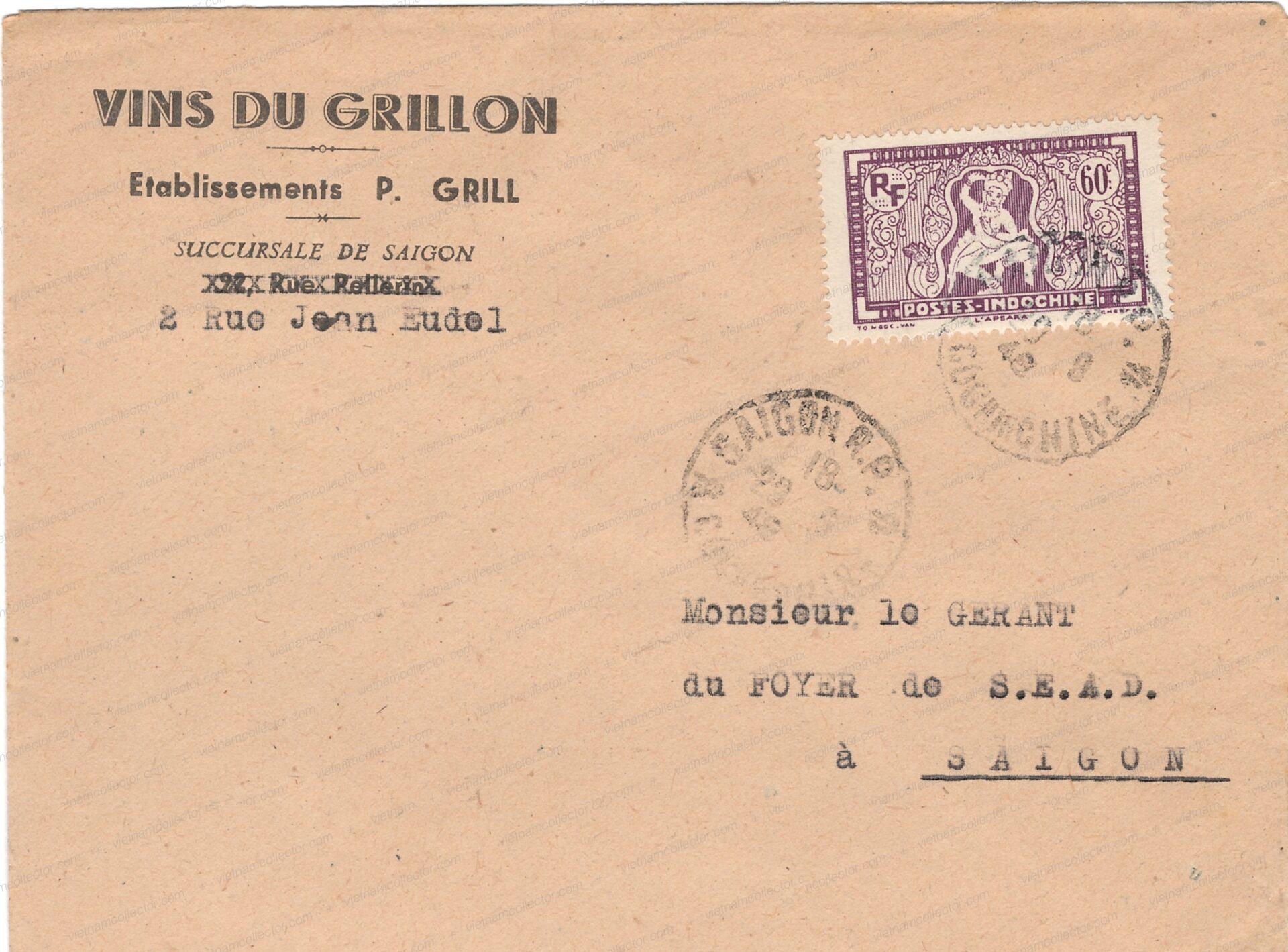
Mixed franking of the 30C together with the 60C stamp paying an overall postage of 90C on an international air mail letter sent from Saigon to Malaysia sent in August of 1947.

Mixed franking of the 10C (blue) and 60C stamps paying an overall postage of 70C on a international air mail letter sent by the Bank of Indochina in Hanoi in December of 1939 to a branch in Paris. This was during World Was II which meant that the letter was subject to censure. However, the bank enjoyed special privileges that exempted it from such censure which was indicated by a red cachet struck in front that read “Banque Privilegied a expedier sans delai Exempt de Censure”.
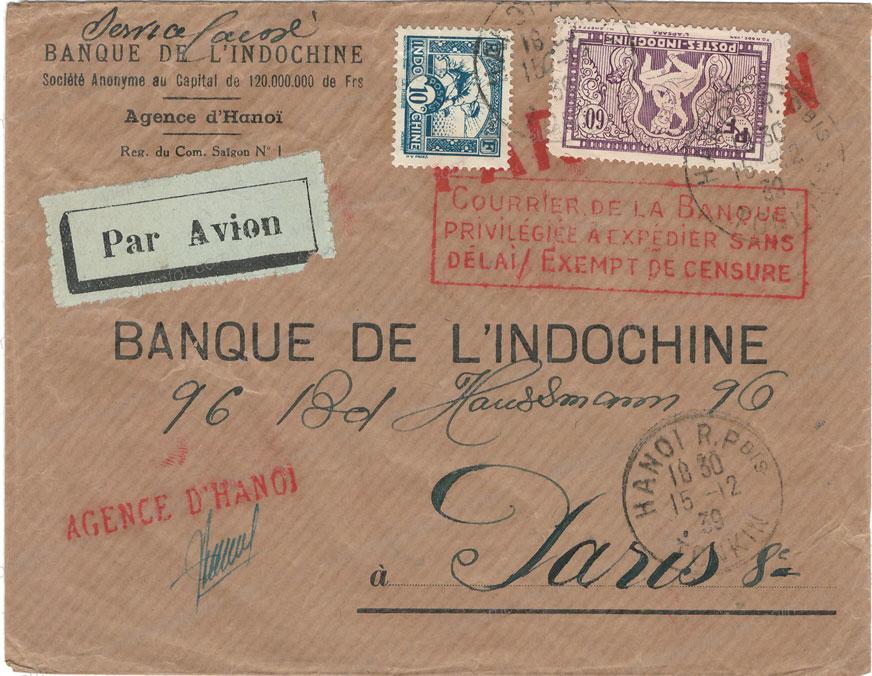
Multiple franking of the 60C value (2) paying an overall postage of 1.20P on an international air mail letter sent from Tan An to France in November of 1947. Saigon transit cancel on the reverse.
 Multiple franking of the 60C value (2) paying an overall postage of 1.20P on an international air mail letter sent to France in December of 1947.
Multiple franking of the 60C value (2) paying an overall postage of 1.20P on an international air mail letter sent to France in December of 1947.
 Mixed franking of the 25C (blue) together with the 60C stamp paying an overall postage of 85C sent from Saigon to France in November of 1948.
Mixed franking of the 25C (blue) together with the 60C stamp paying an overall postage of 85C sent from Saigon to France in November of 1948.

Mixed franking of the 2C, 3C and 50C values paying an overall postage of 55C on an international air mail letter sent from Saigon to India in August of 1940. The letter was routed through Singapore and since World War II was in progress the letter was censured by the British there as indicated by the violet “Passed by Censor 402 Singapore” cachet on both sides as well as the brown tape used to re-seal the letter. Indian arrival cancel on the reverse.
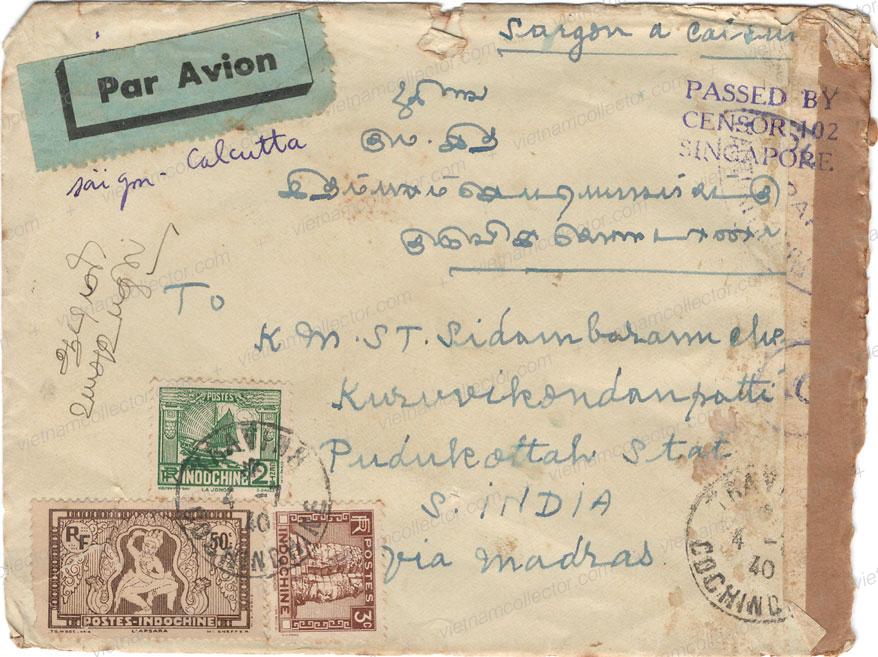
Multiple franking of the 60C value (5) paying an overall postage of 3P on package notification sent within Saigon in August of 1951.
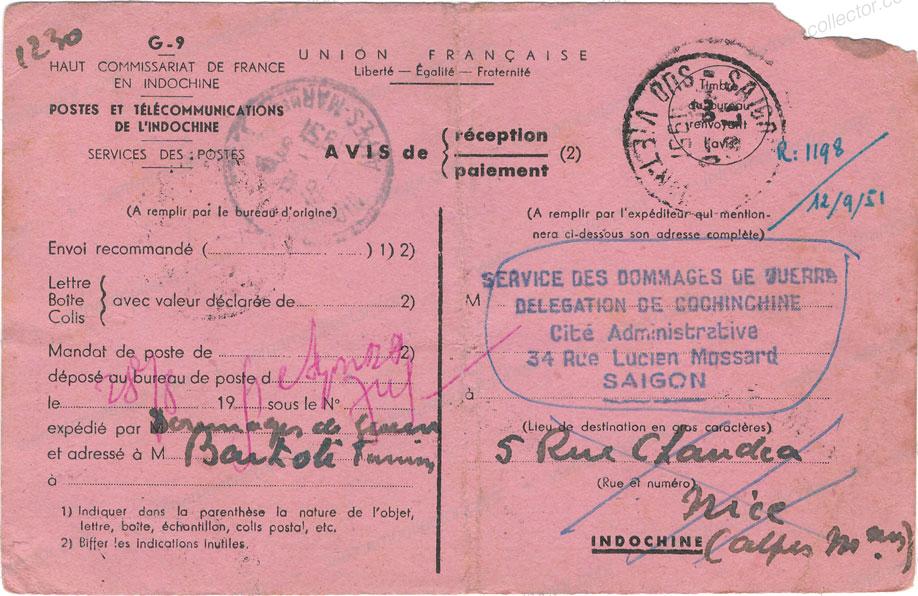
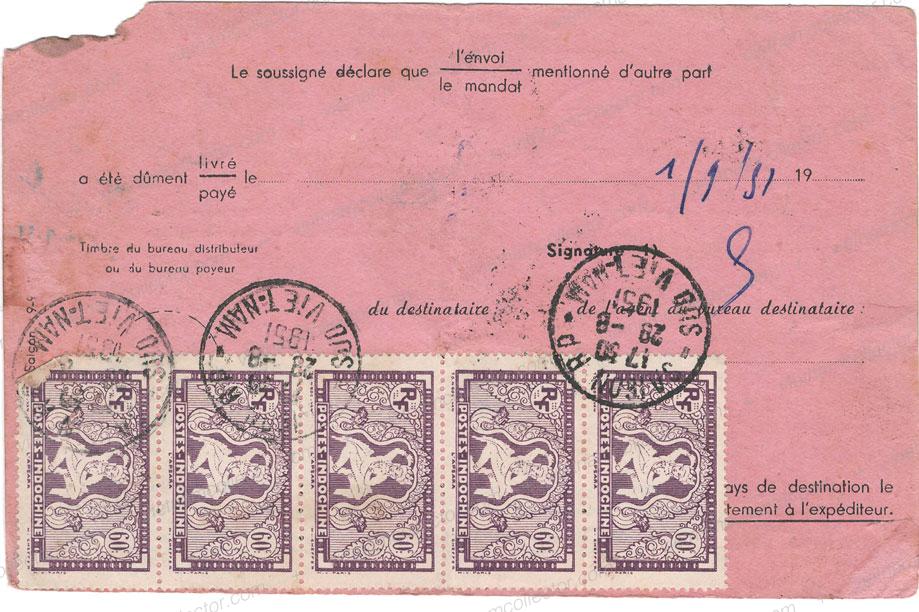
Mixed franking of the 30C and 60C value paying an overall postage of 90C on an international air mail letter sent from Saigon to India in October of 1947. Indian arrival cancel on the reverse.
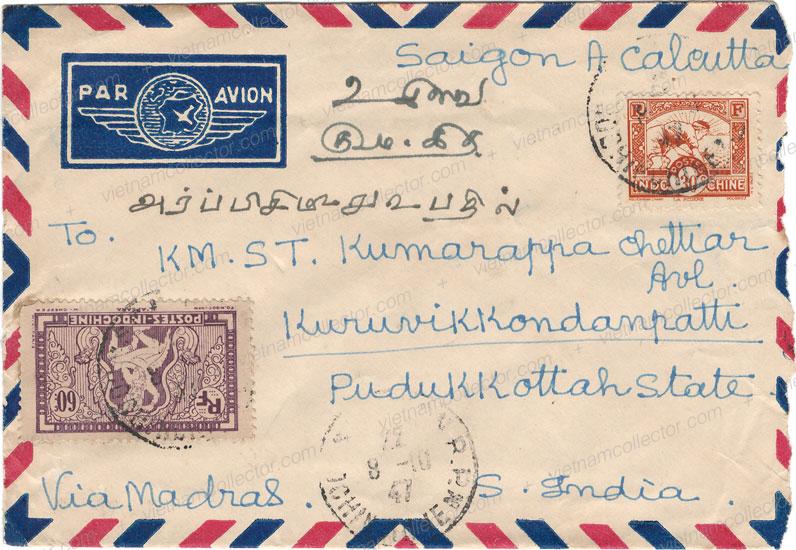
Mixed franking of the 15C (blue) and 70C values paying an overall postage of 85C on an international air mail letter sent from Saigon to France in August of 1948.
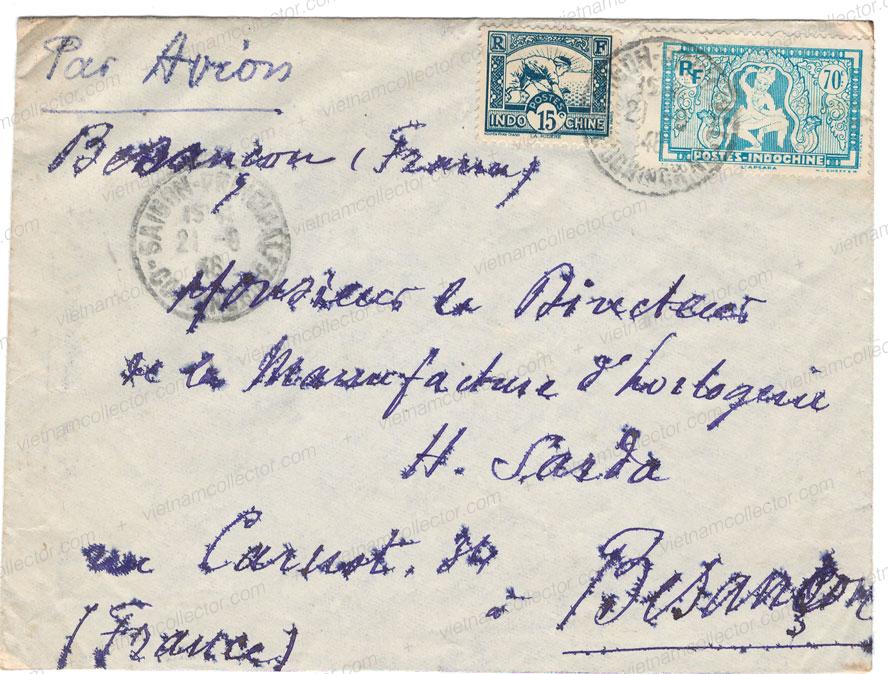
Mixed franking of the 20C (rose-carmine) and 70C values paying an overall postage of 90C on an international air mail letter sent from Saigon to India in January of 1947. Indian arrival cancel on the reverse.
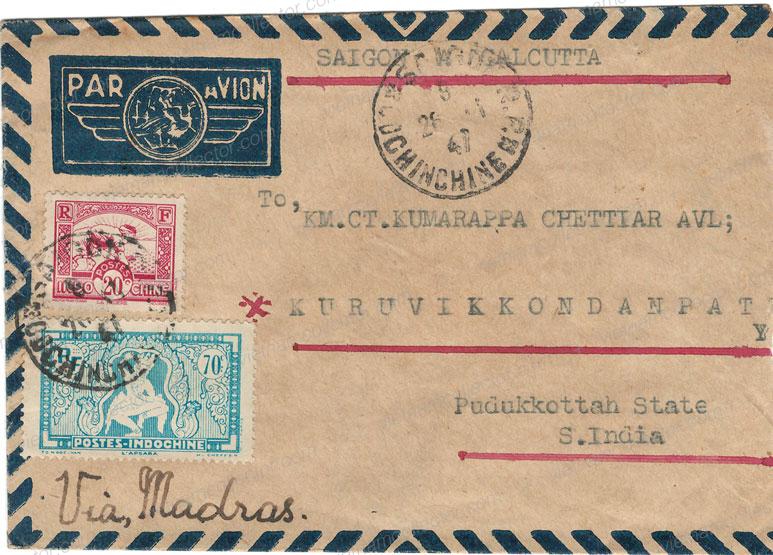
Mixed franking of the 50C and 70C values paying an overall postage of 1.20P on an international air mail letter sent Phnom Penh, Cambodia to France in December of 1947.
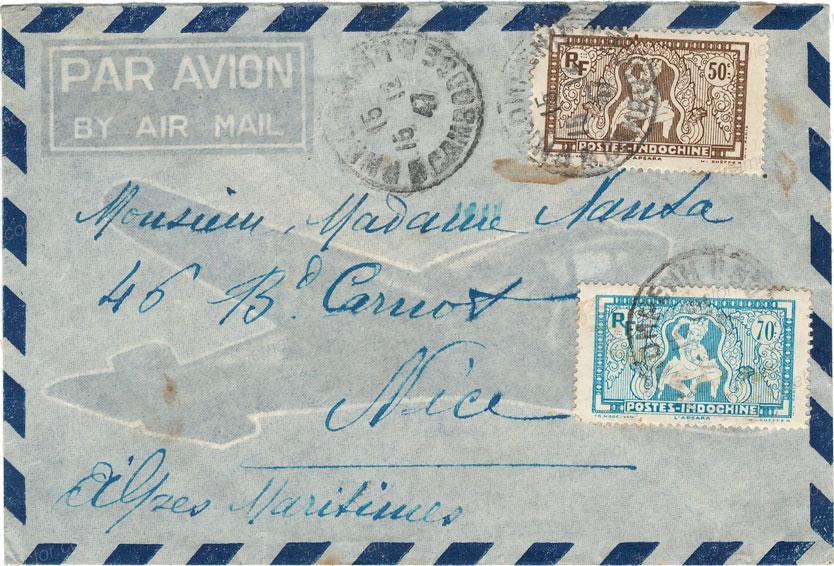
Mixed franking of the 25C (2/blue) and 70C values paying an overall postage of 1.20P on an international air mail letter sent from Can Tho to France in December of 1947. Saigon transit cancel on the reverse.
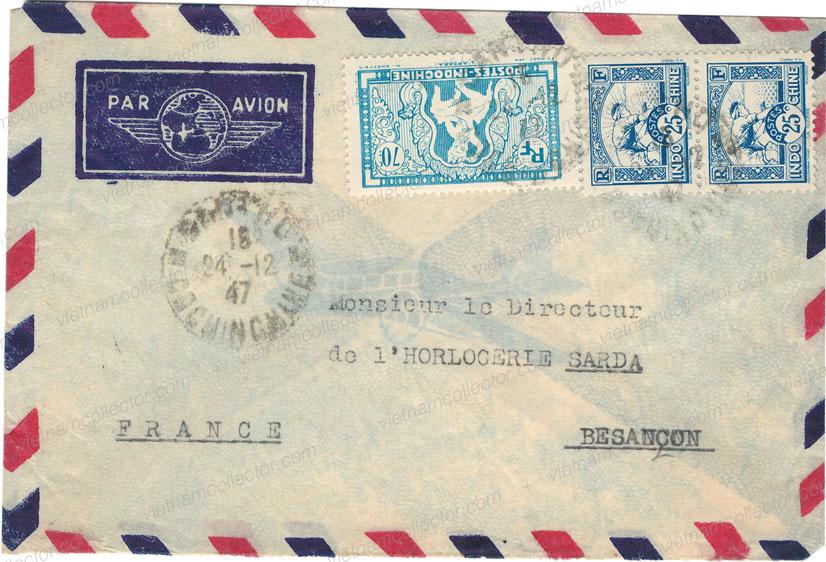
Unusual and rare mixed franking of the French and Indochinese stamps on an international air mail letter sent from Saigon to France in September of 1947. In 1946 some Indochinese post offices ran out of local stamps. As a result French stamps were imported as an emergency measure and, for a short time, used instead of them. Here is a mixture of the 50C and 70C Domestic Scenes II stamps plus two 5F French stamps.
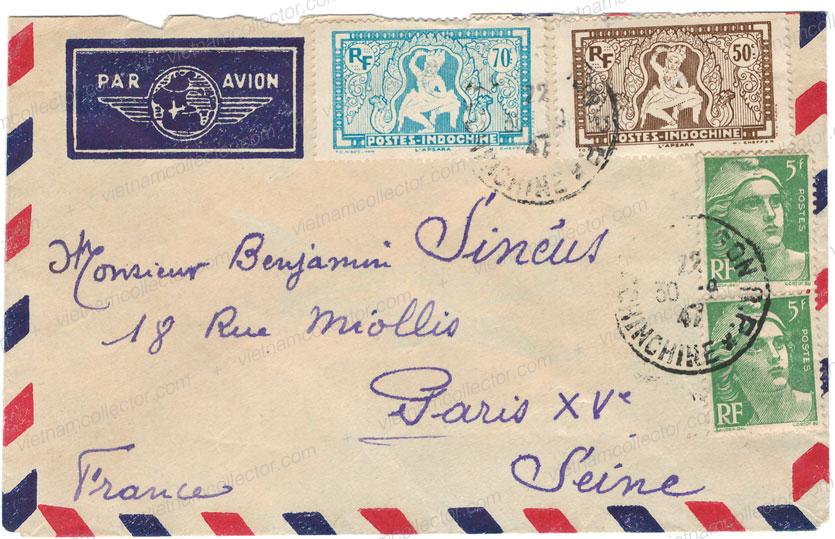
Mixed franking of the 50C and 70C values paying an overall postage of 1.20P on an international air mail letter sent from Saigon to France in October of 1947.
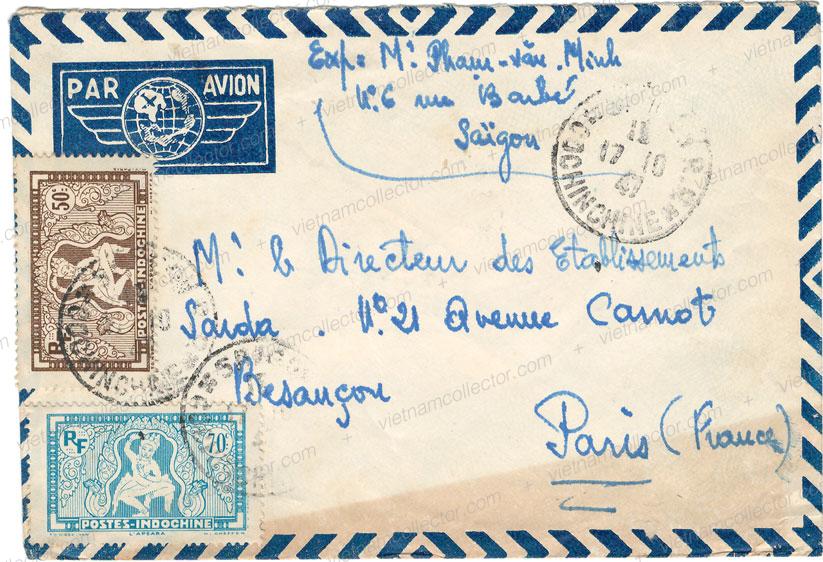
Multiple franking of the 70C (4) value paying an overall postage of 2.80C on an international air mail letter sent from Saigon to India in October of 1946.
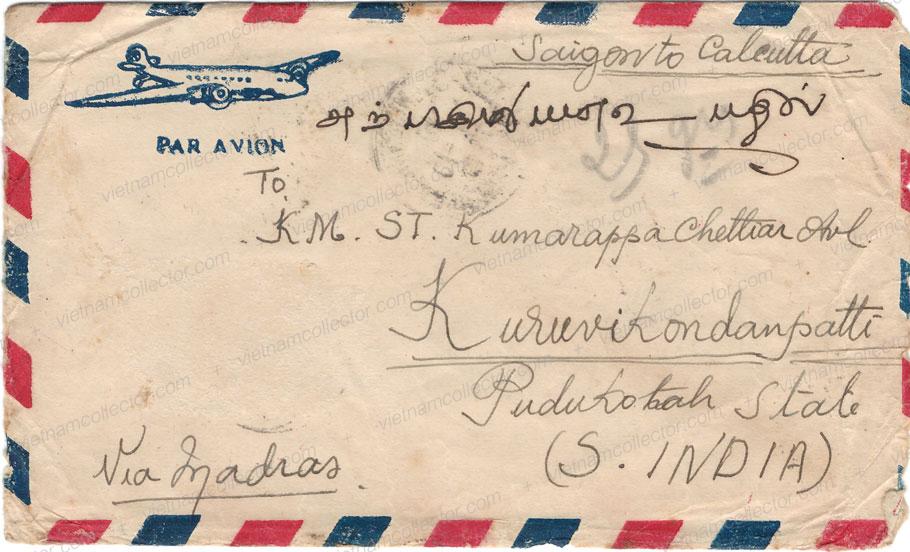
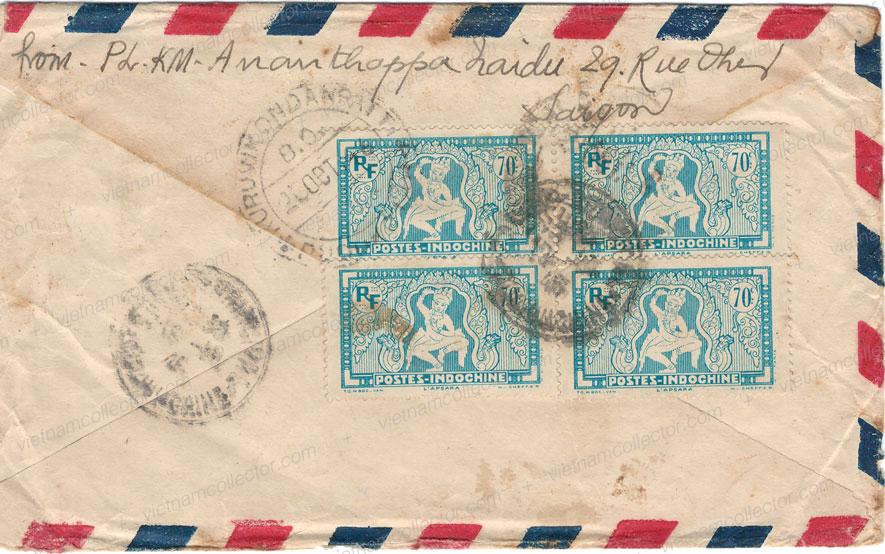
Below are two, almost identical money transfer receipts from the same date (October 5th, 1950) documenting the transfer of 5,000FF to France. Cancelled with the Saogon-Cholon circular cancel.
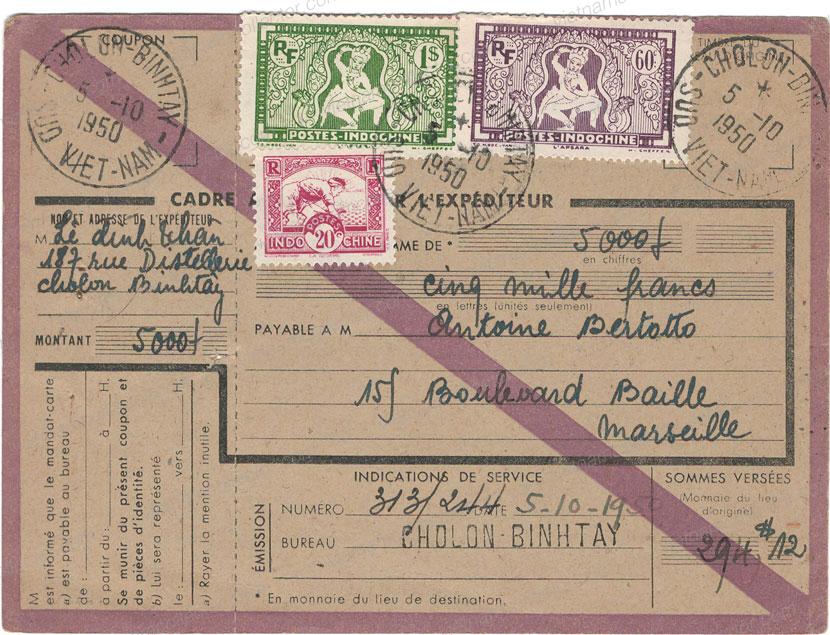
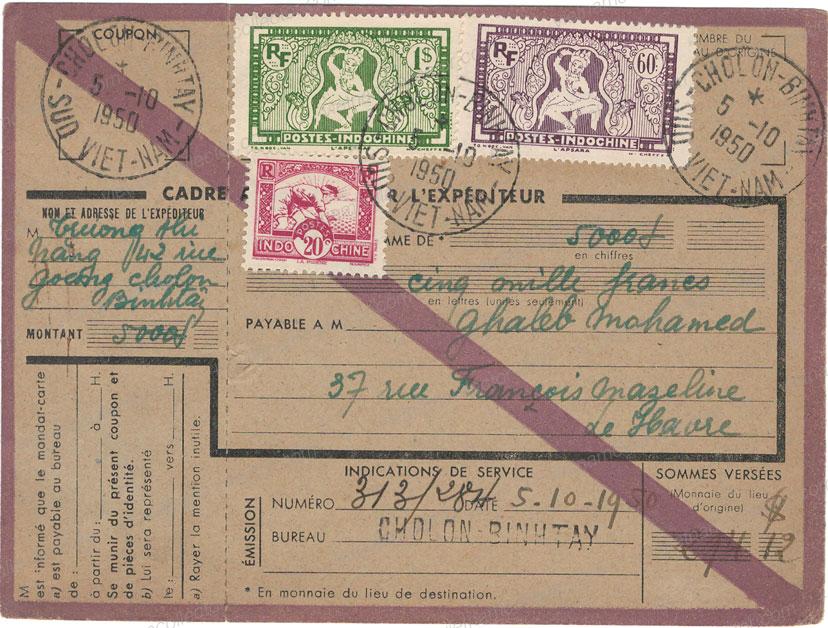
Multiple franking of the 60C value (7) paying an overall postage of 4.20P on an international air mail letter sent from Da Lat to France in May of 1950. World Peace Vignette on the reverse.
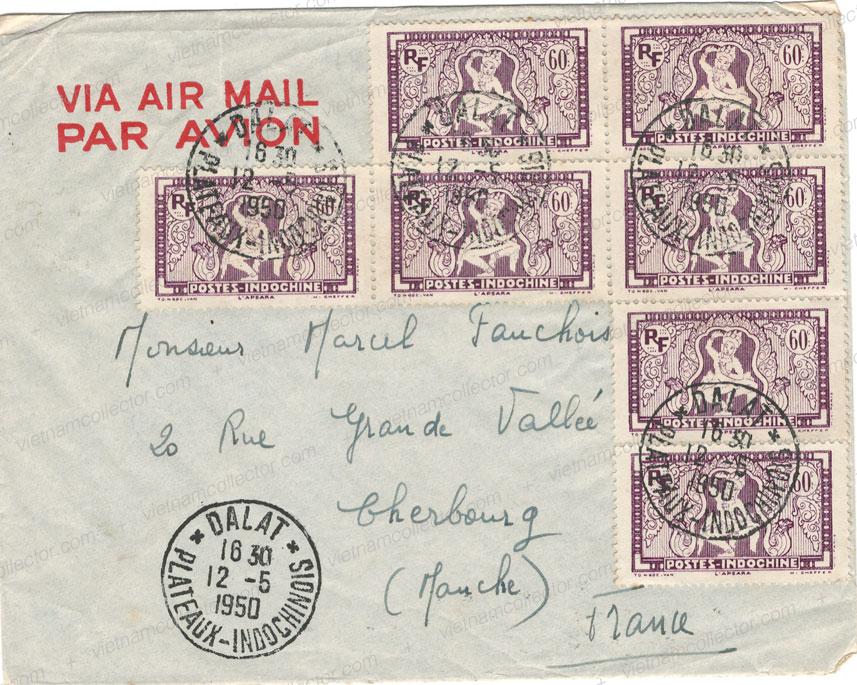
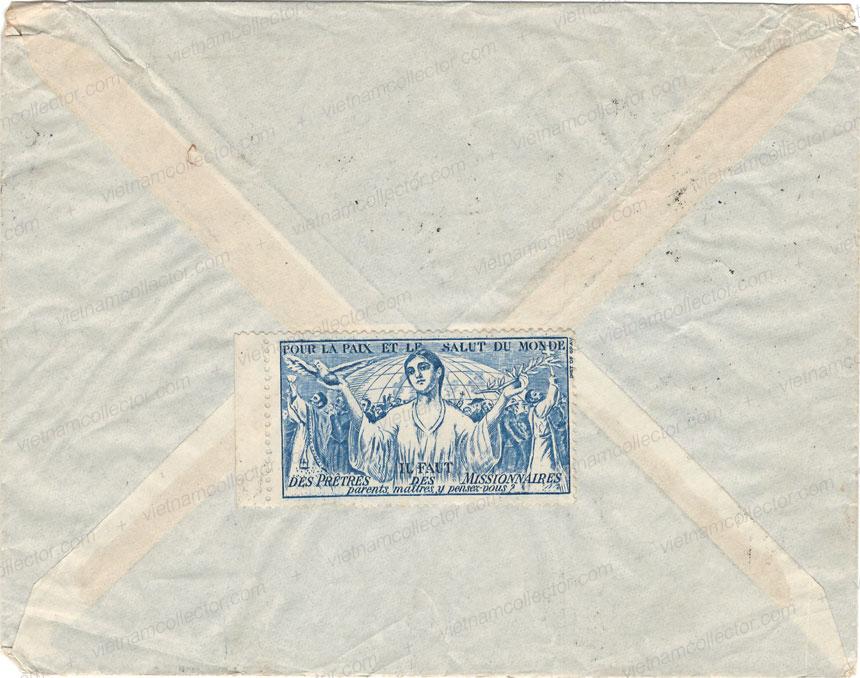
Mixed franking of the 20C (rose-carmine) and 70C values paying an overall postage of 90C on an international air mail letter sent from Saigon to India in November of 1947. Indian arrival cancels on the reverse.
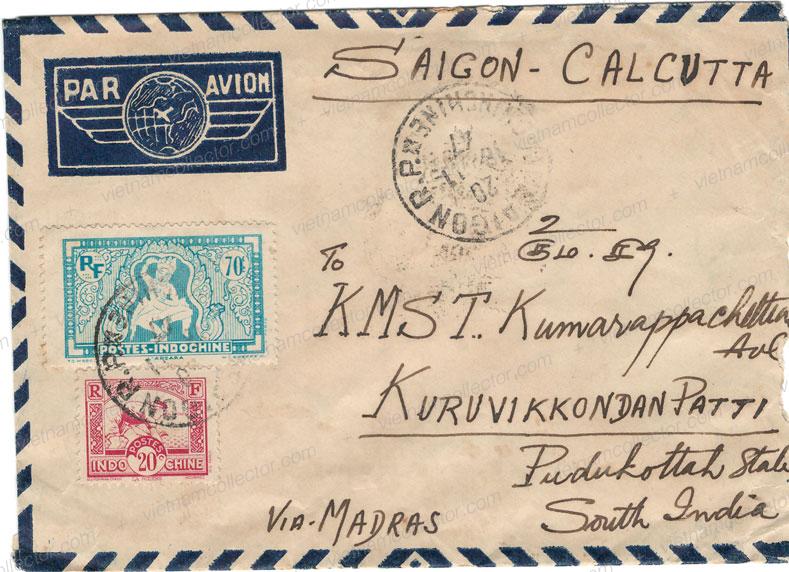
Mixed franking of the 20C (2/rose-carmine) and 1P (2) stamps paying an overall postage of 2.40P on an international air mail letter sent from Saigon to India in October of 1949. Indian arrival cancels on the reverse.
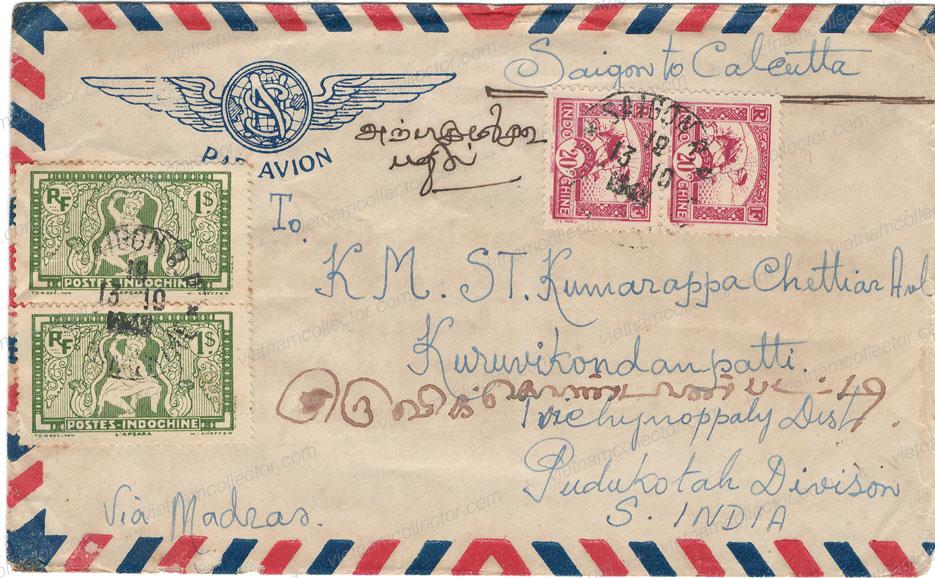
Mixed franking of the 30C (2) and 1P Domestic Scences II stamps paying an overall postage of 1.60P on an international air mail letter sent from Kampong-Cham, Cambodia (rare cancel) to Paris, France in June of 1948.
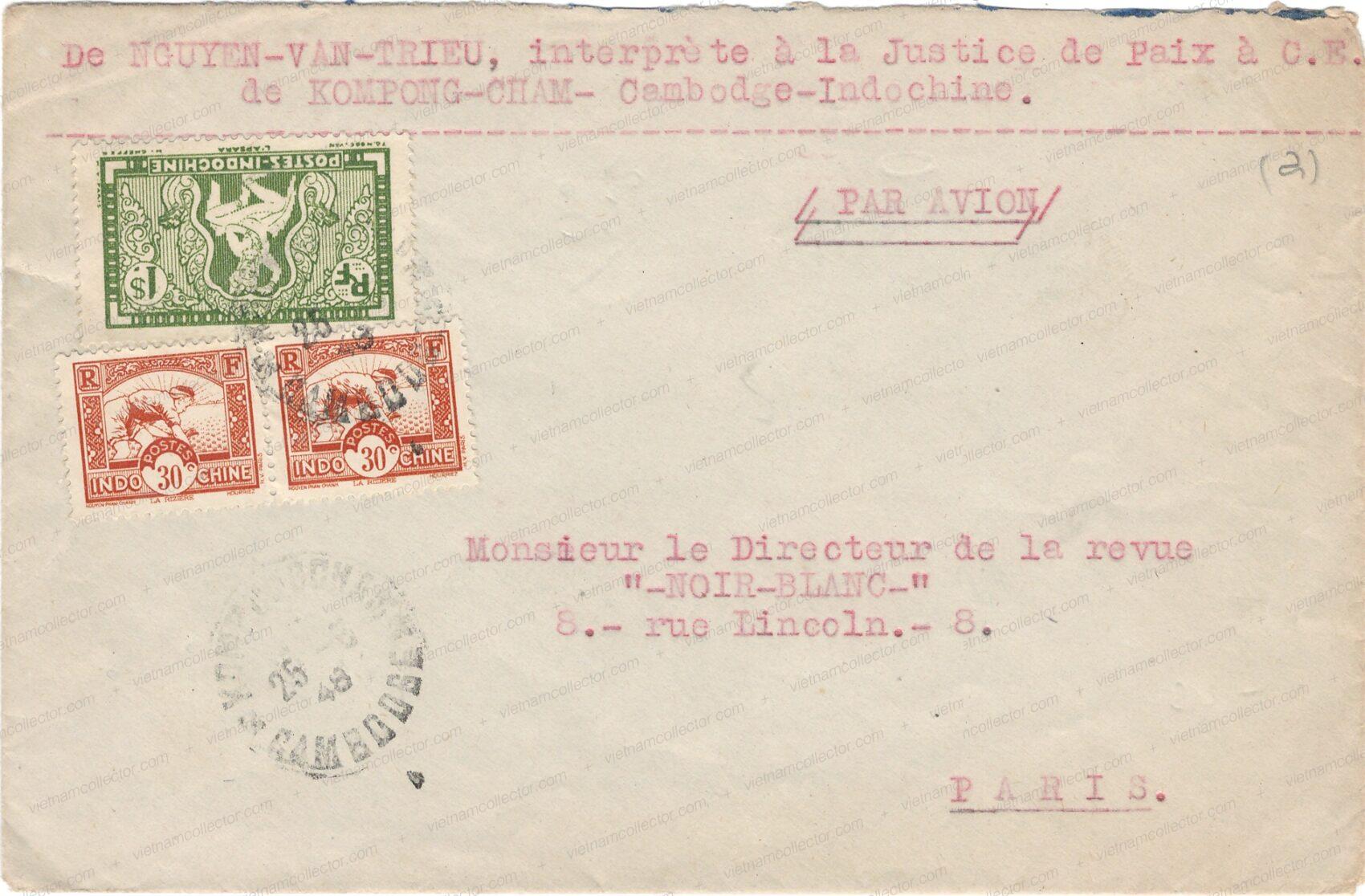
Unusual and rare mixed franking of the French and Indochinese stamps on an international air mail letter sent from Saigon to France in August of 1946. In 1946 some Indochinese post offices ran out of local stamps. As a result French stamps were imported as an emergency measure and, for a short time, used instead of them. Here is a mixture of the 10C (blue on rose), 70C and 1P Domestic Scenes II stamps plus five 6F French stamps. The stamp on the reverse was inadvertently not cancelled in Saigon so was cancelled with a bar cancel in Loudes.

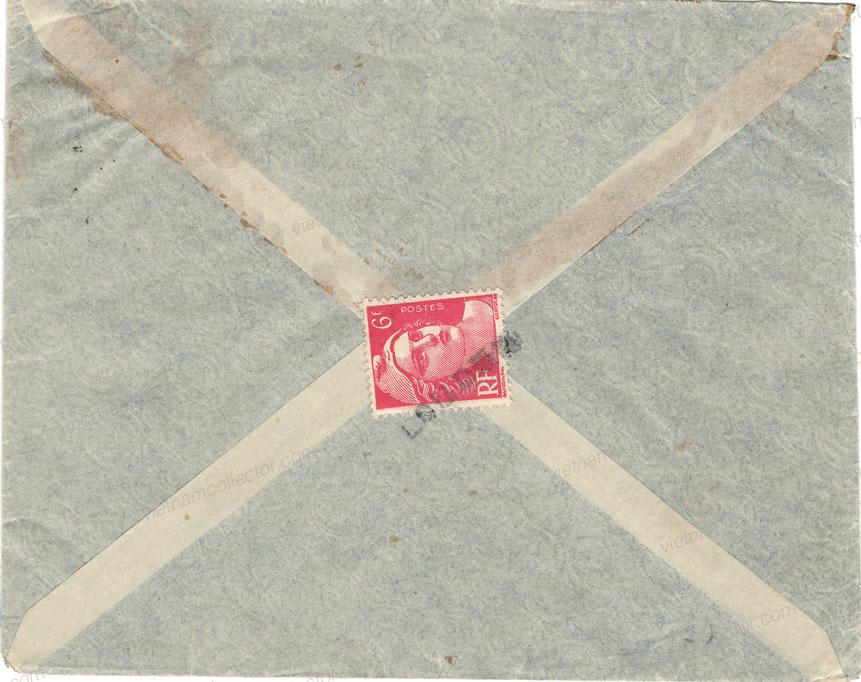
Multiple franking of the 1P value (2) paying an overall postage of 2P on a registered international air mail letter sent from Tra Vinh (rare cancel) to India in December of 1940. The letter was routed through Singapore where it was censored by the British as indicated by the violet “Passed By Censor 102 A” cachet on both sides as well as the brown tape used to re-seal the letter. Saigon transit and various Indian arrival cancels on the reverse.
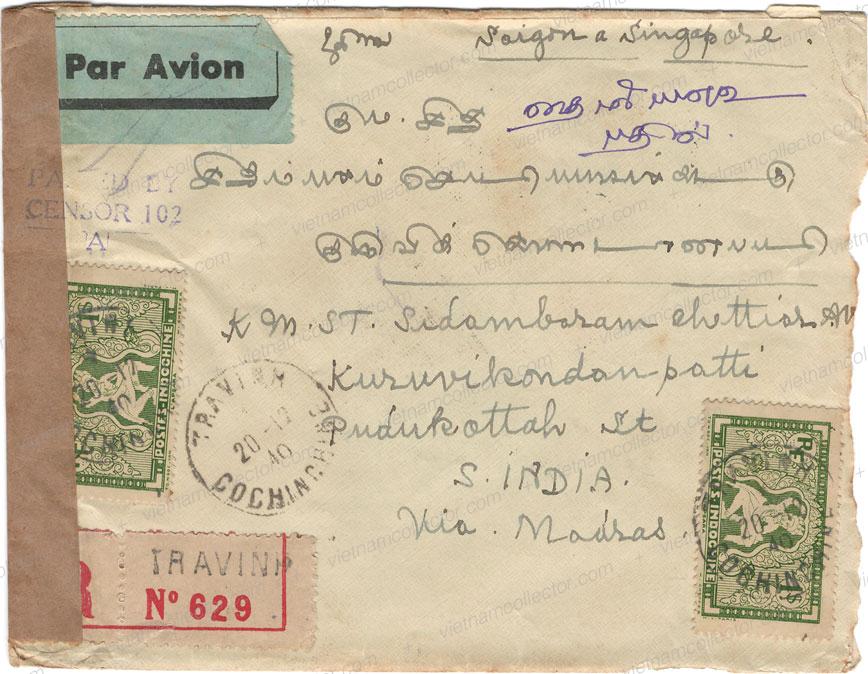
Mixed franking of the 50C and 1P (2) values paying an overall postage of 2.50P on an international air mail letter sent from Saigon to India in June of 1948. Indian advertisement boxed cancel on the reverse.
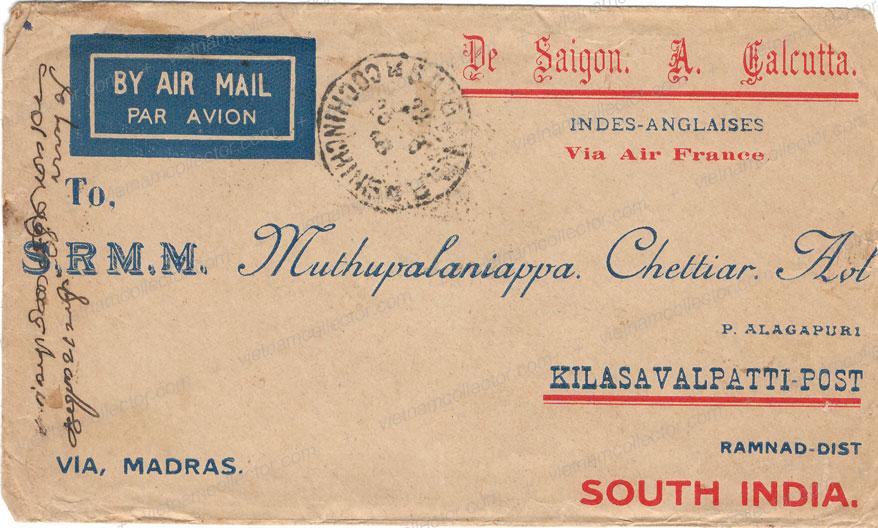

Multiple franking of the 1P value (2) paying an overall postage of 2P on an international air mail letter sent from Hai Phong to France in May of 1941. This was during the time of the Japanese Occupation of Indochina. While the mail was still handled by French administrators the Japanese took over the censoring of mail but they kept using the same cachets and banderoles as the French previously.
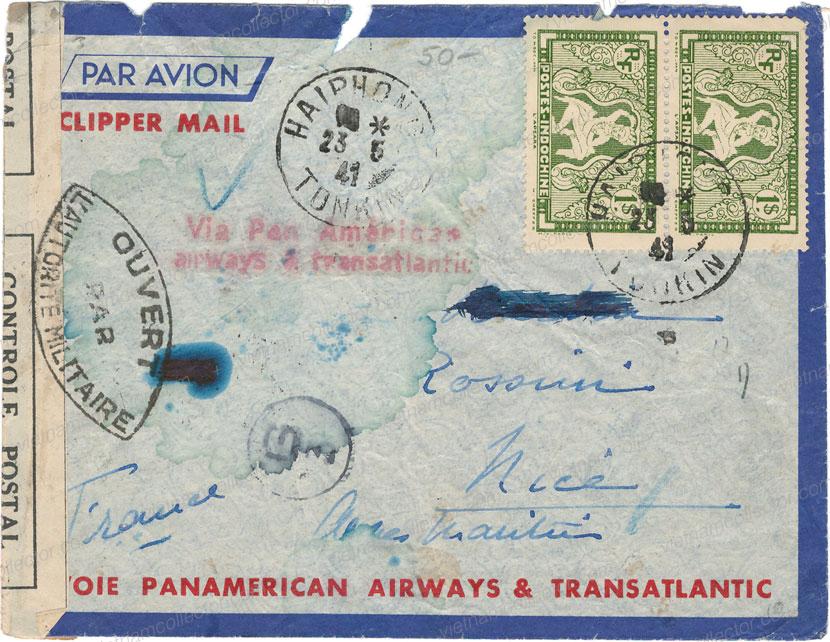
Mixed franking of the 50C and 1P (2) values paying an overall postage of 2.50P on an international air mail letter sent from Saigon to India in June of 1948. Indian arrival cancel on front.
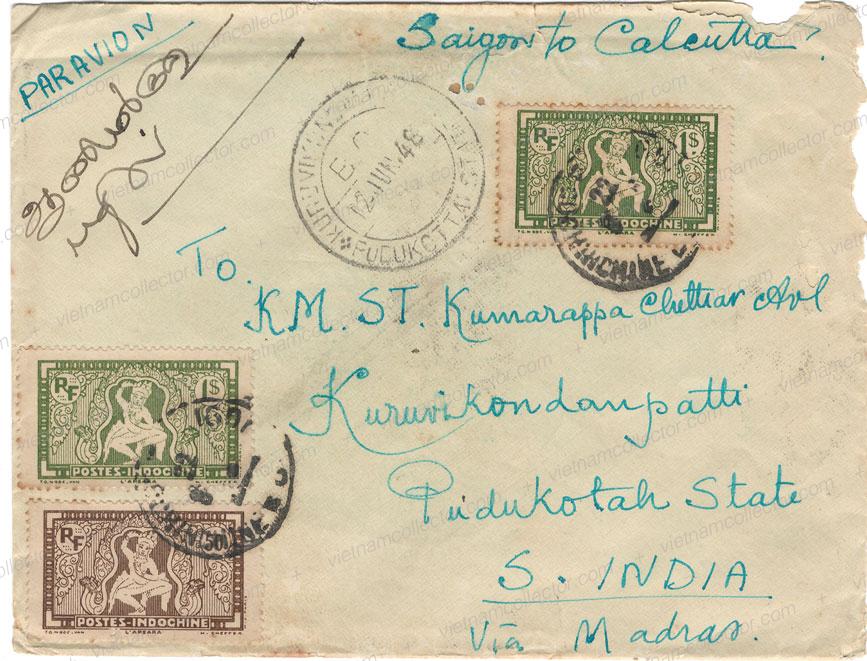
Multiple franking of the 1P value (3) paying an overall postage of 3P on a registered international air mail letter sent from Saigon to France in September of 1948.
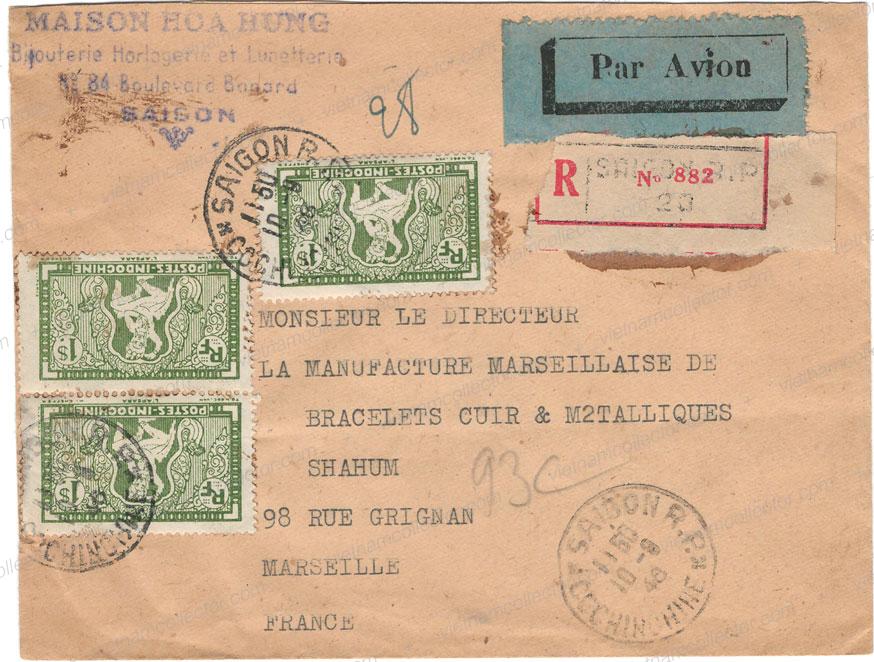
Single franking of the 2P value on an international air mail letter sent from Saigon to India in May of 1948. Indian arrival cancel on the reverse.
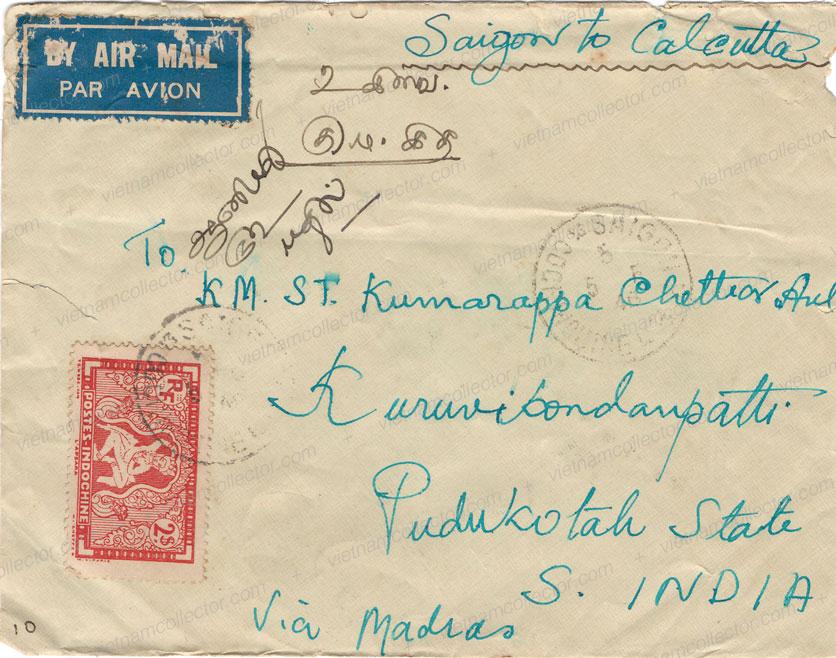
Single franking of the 2P value on an international air mail letter (full contents preserved) sent from Saigon to India in September of 1951. Indian arrival cancel on the front and reverse.
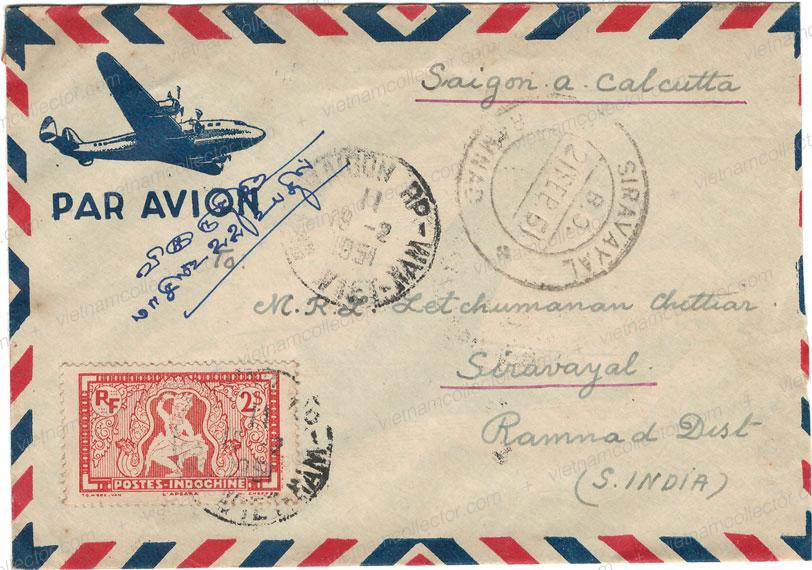
Single franking of the 2P value on an international air mail letter sent from Saigon to India in April of 1951. Indian arrival cancel on the front and reverse. Unusual “By Surface Route” cachet on front.
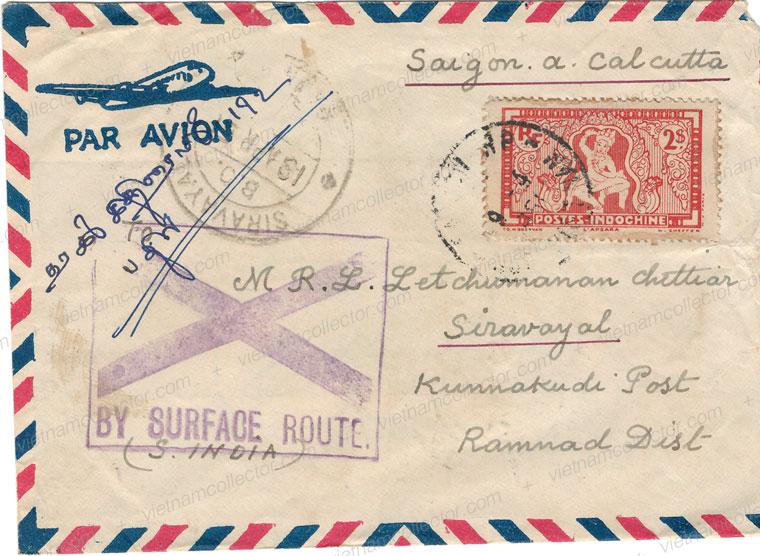
Mixed franking of the 20C and 2P Domestic Scene II stamps together with the 1P Air Mail stamp paying an overall postage of 3.20P on an international air mail letter sent from Saigon to Switzerland in 1950. The postage was judged to be insufficient in Indochina as indicated by the black “T” hand stamp and the blue manuscript marking. The additional postage was collected upon arrival by adding 65 Rappen of Swiss postage due stamp one front.
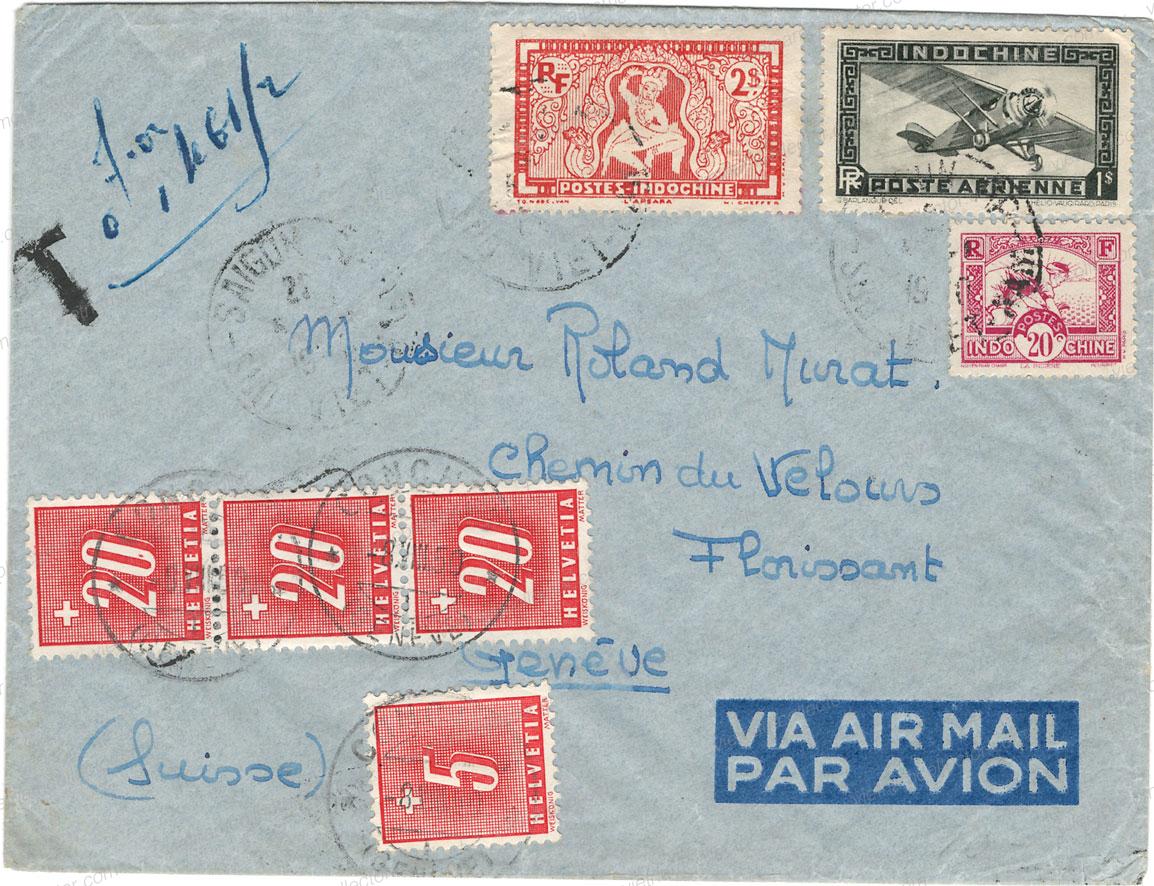
Mixed franking of the 20C (rose-carmine), 1P and 2P stamps paying an overall postage of 3.20P on a registered air mail letter sent from Saigon to India in December of 1948. Indian arrival cancel on the reverse.
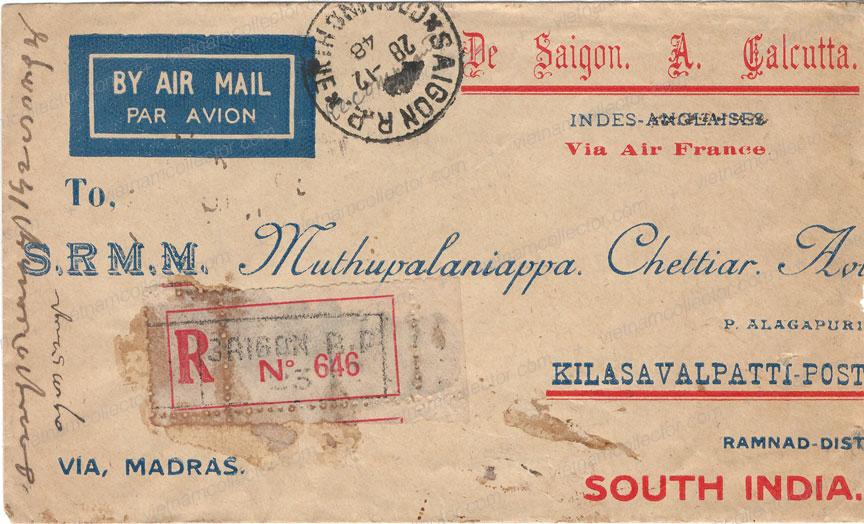
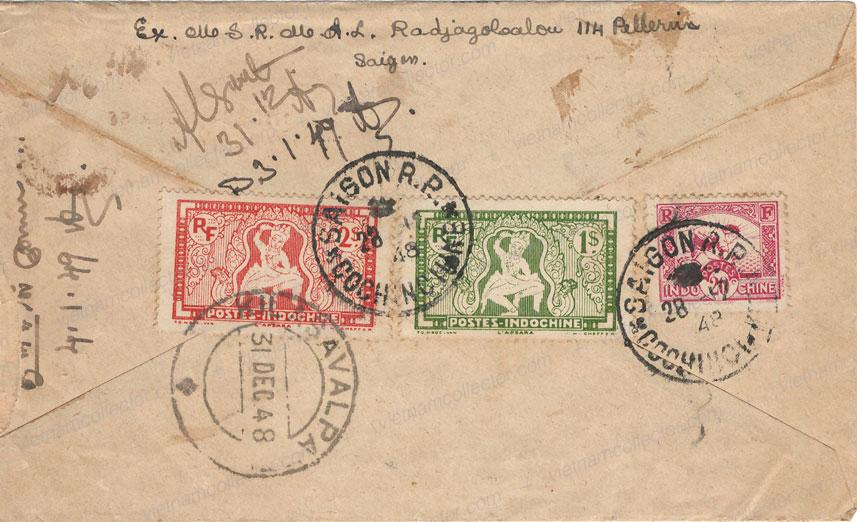
Mixed franking of the 20C (2) and 2P Domestic Scence II stamps paying an overall postage of 2.40P on an international air mail letter sent from Saigon to India. While the letter was transported by air from Indochina to India this privilege obviously did not transfer to domestic transportation. Within India the letter was transported using surface transportation as indicated by the unusual red postal cachet to that effect.
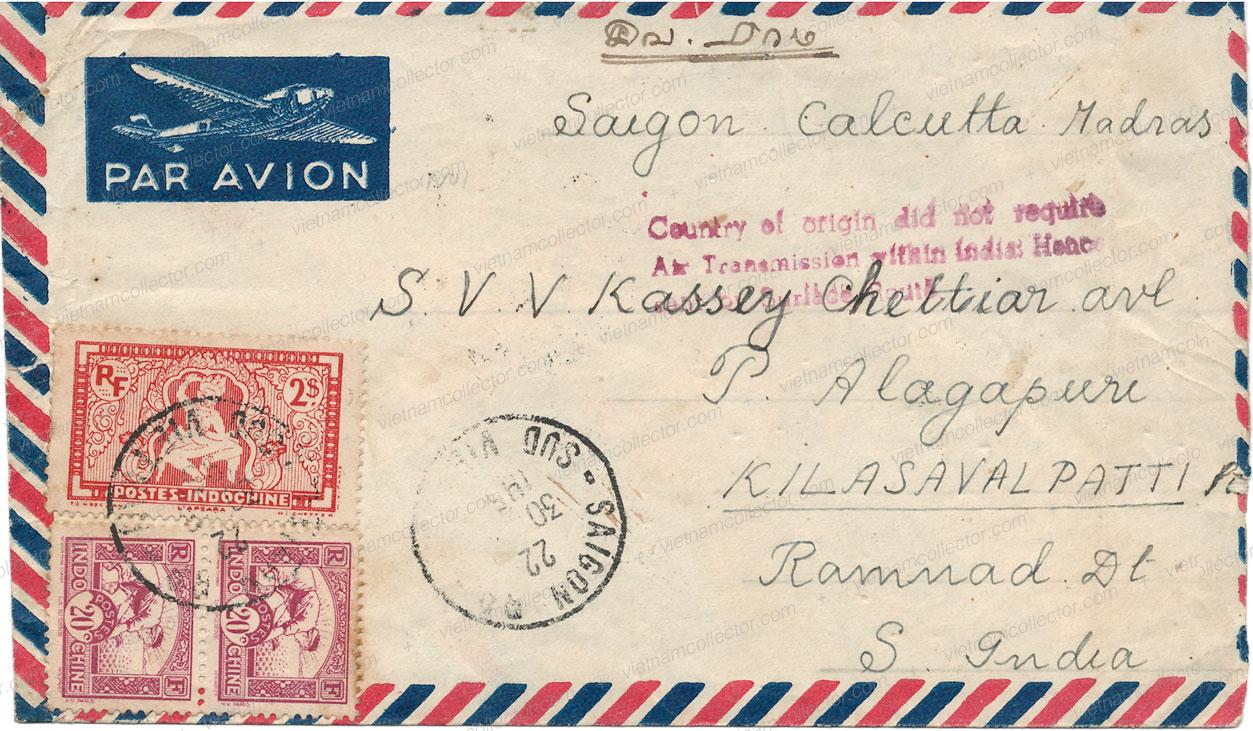
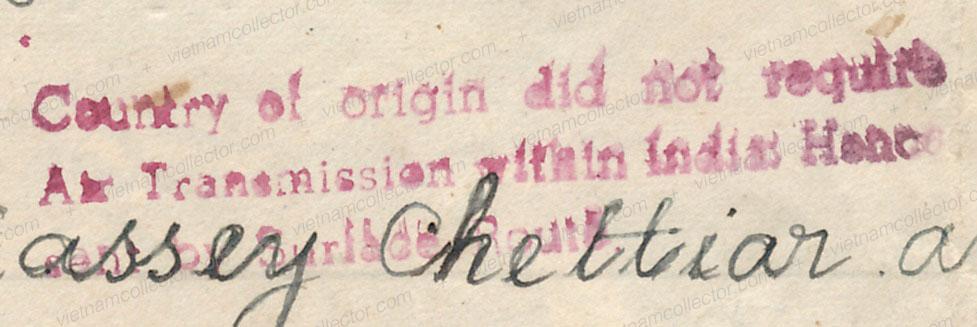
Mixed franking of the 3C (brown), 7C, 30C and 2P values paying an overall postage of 2.40P on an international air mail letter sent from Saigon to France in March of 1950. 30. Anniversary of the first flight connection to France cachet on front.
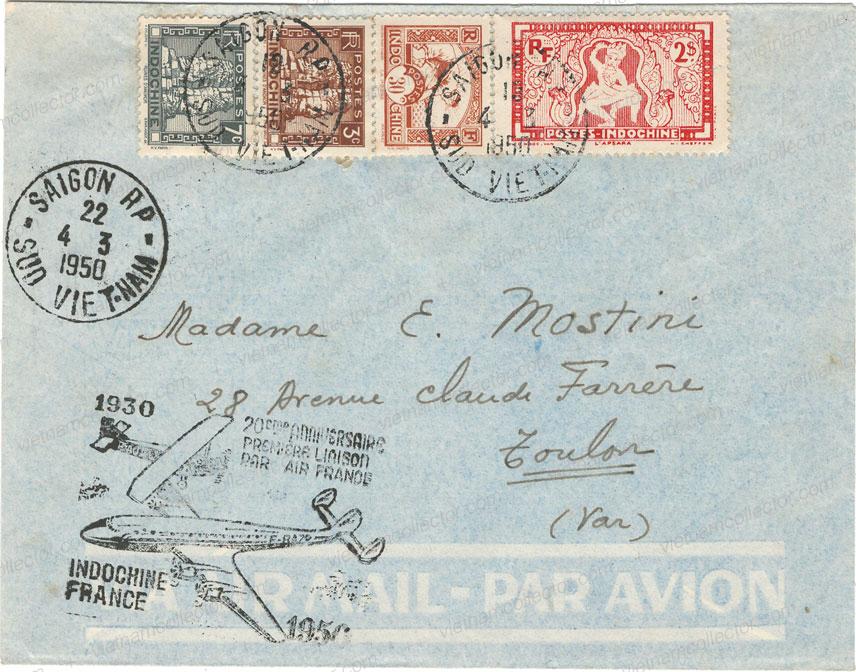
Mixed franking of the 8C (5), 1P and 2P stamps paying an overall postage of 3.40P on an international air mail letter sent from Luang Prabang in Laos to the United States in September of 1949.
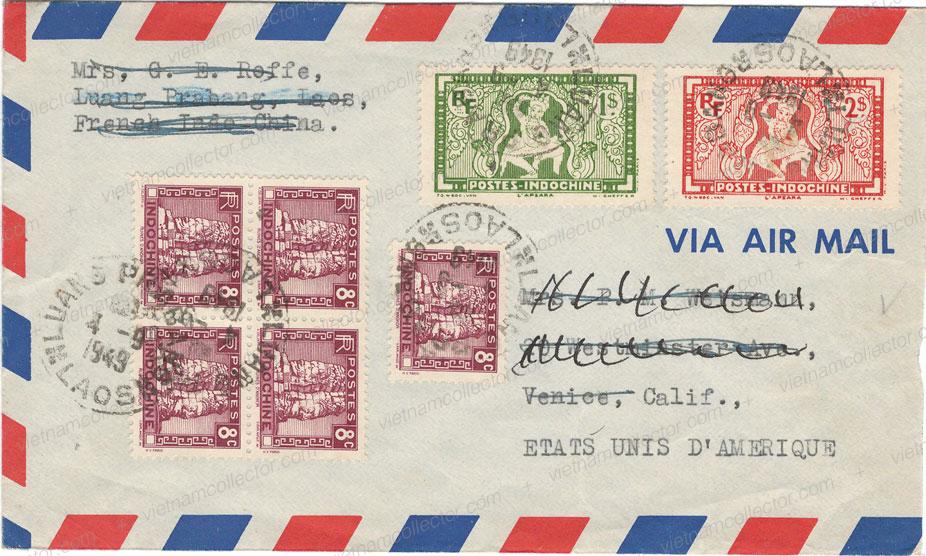
Mixed franking of the 20C (rose-carmine) together with the 2P value (2) paying an overall postage of 4.20P on a registered international letter setoff rom Saigon to Da Lat in August of 1951. Da Lat arrival cancel on the reverse.
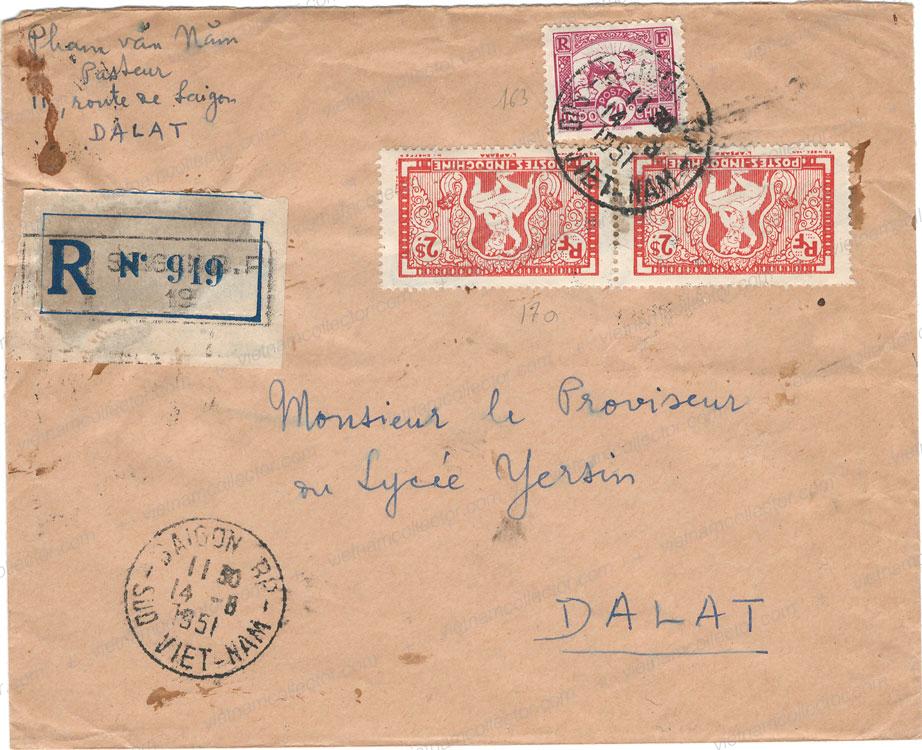
Mixed franking of the 20C (2/rose-carmine), 1P and 2P values paying an overall postage of 3.40P on an international air mail letter sent from Saigon to the United States in June of 1950.
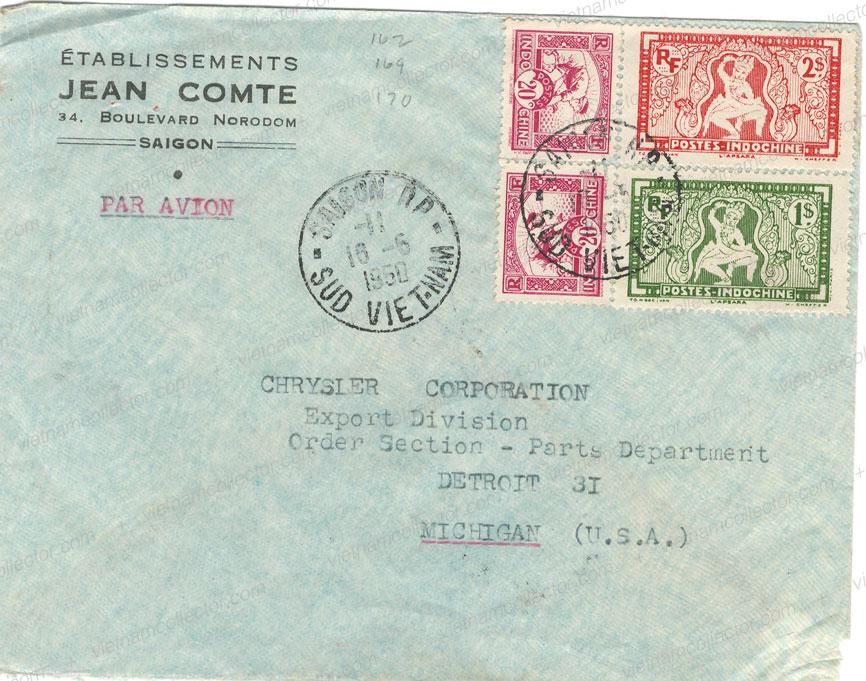
Mixed franking of the 60C (3) and 2P Domestic Scenes II together with the 10P Air Mail stamp paying an overall postage of 13.80P on a registered air mail letter sent from Hongay-Ton to France in August of 1950. Unusual “Verifie Par La Douane” bar and “Douanes Et Regies” circular custom cachets.
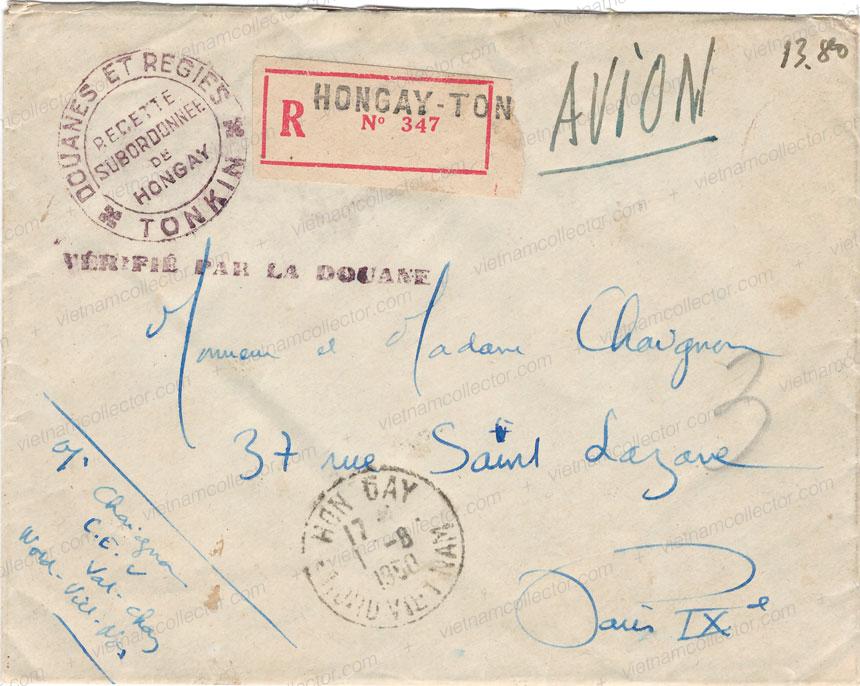
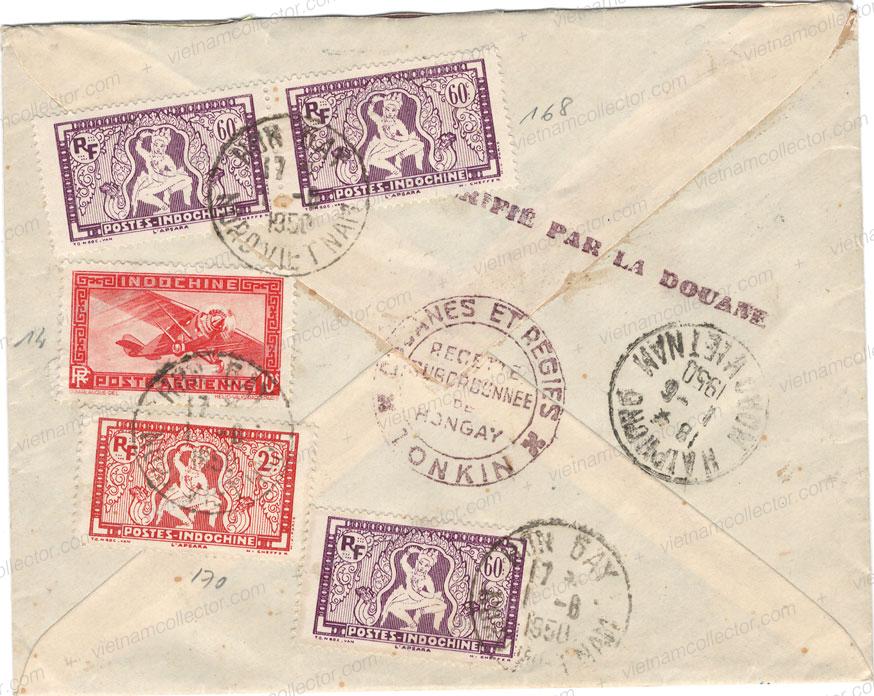
Mixed franking of the 20C (rose-carmine) plus the 2P stamp paying an overall postage of 2.40P on an international air mail letter sent from Saigon to India in August of 1949. Indian arrival cancel on the reverse.
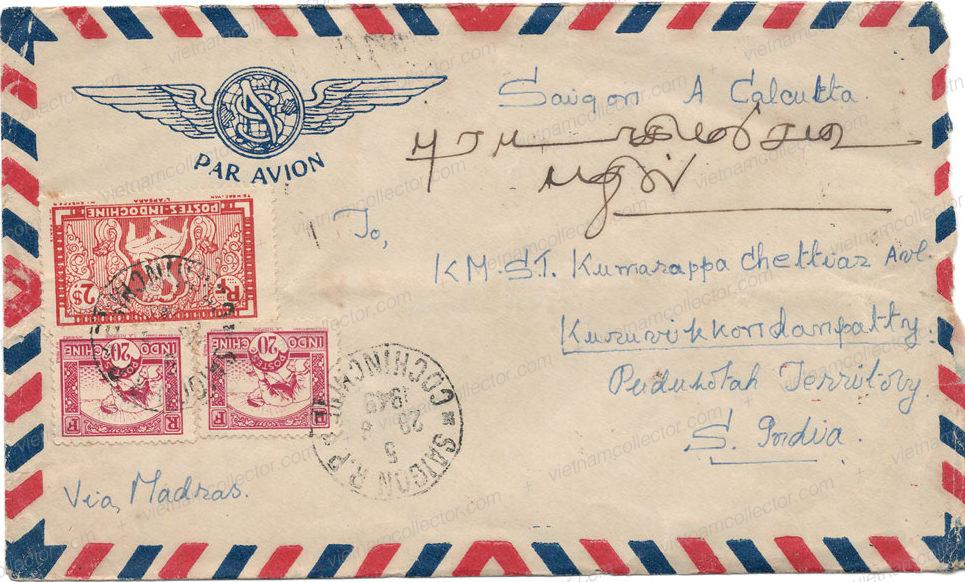
Mixed franking of the 70C (2) and 2P values paying an overall postage of 3.40P on an international air mail letter sent from Saigon to India in November of 1949. Indian arrival cancels on the reverse.
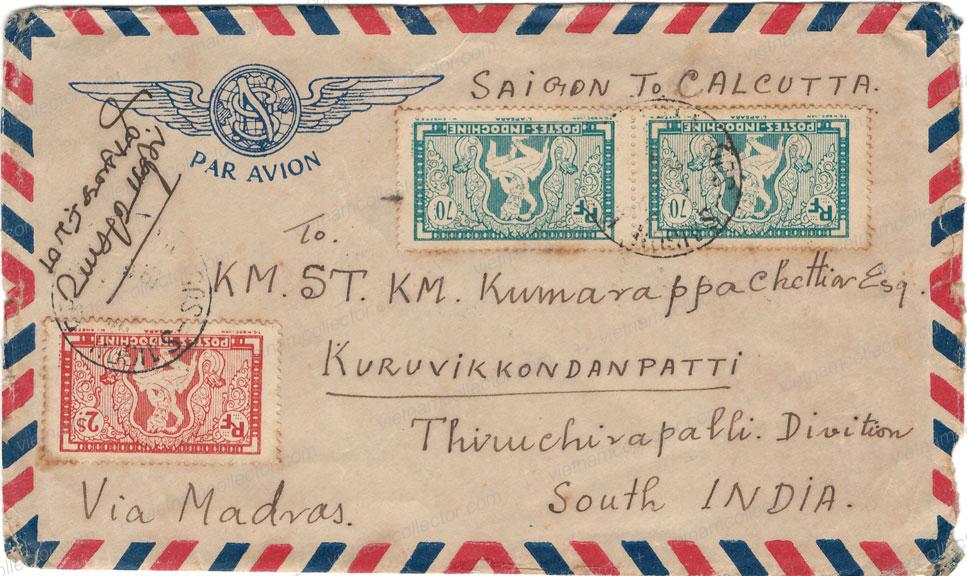
Single franking of the 2P value on an international air mail letter sent from Saigon to India in June of 1948. Indian arrival cancels on front and reverse.
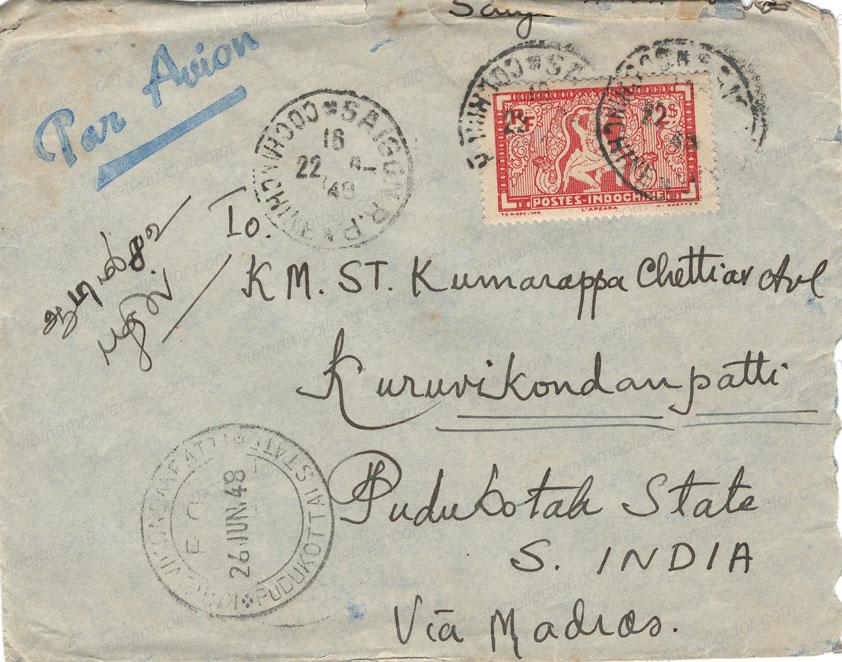
Mixed franking of the 20C (2/rose-carmine) and 2P stamps paying an overall postage of 2.40P on an international air mail letter sent from Saigon to France in March of 1950. 30. Anniversary of the first flight connection to France cachet on front.
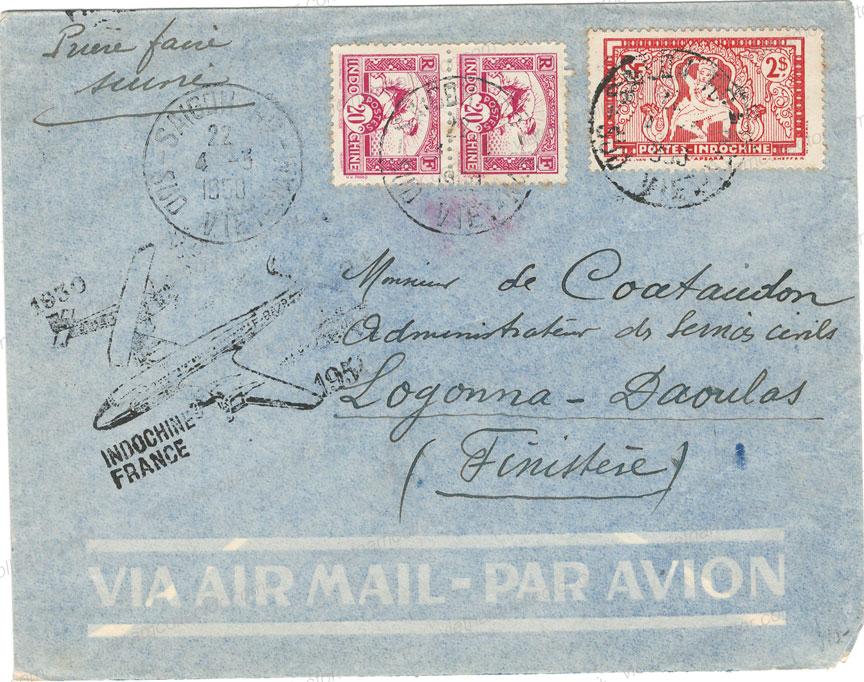
Mixed franking of the 20C (5/rose-carmine) and the 2P values paying an overall postage of 3P on a registered international air mail letter sent from Saigon to France in July of 1949. French arrival cancel on the reverse.
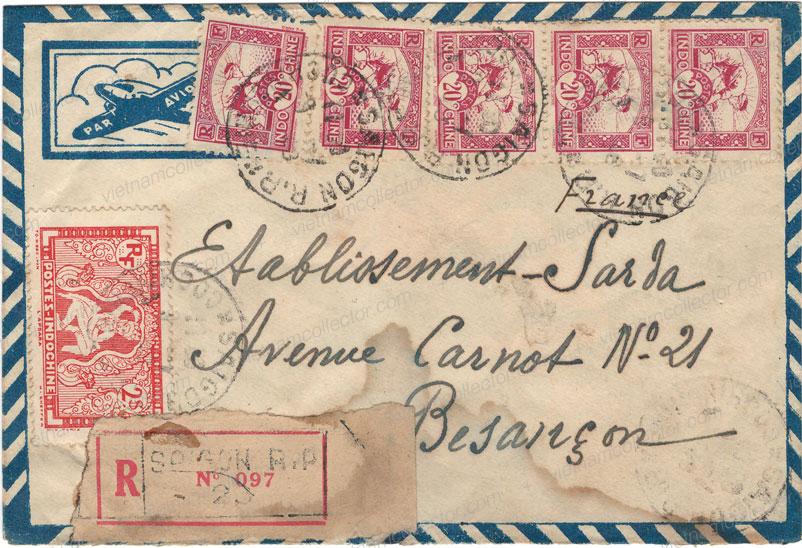
Mixed franking of the 30C, 70C and 2P Domestic Scenes II stamps together with the 1P Air Mail stamp paying an overall postage of 4P on an international air mail letter sent from Hai Phong to France in January of 1951. Port Said, Egypt transit cancel and Worms & Co shipping line cachet on the reverse.
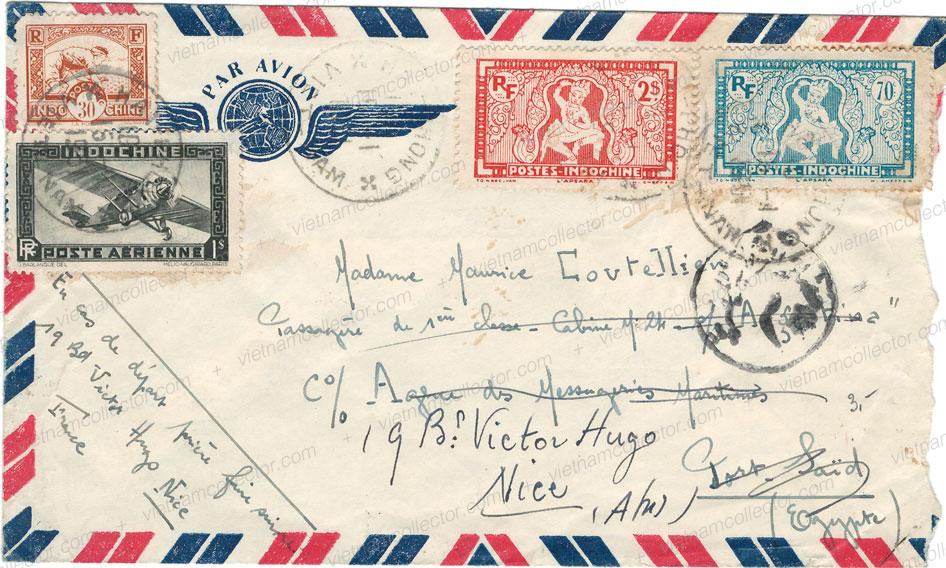
Mixed franking of the 1P and 2P values paying an overall postage of 3P on a registered international air mail letter sent from My Tho to France in July of 1948. Saigon transit and Besancon arrival cancel on the reverse.
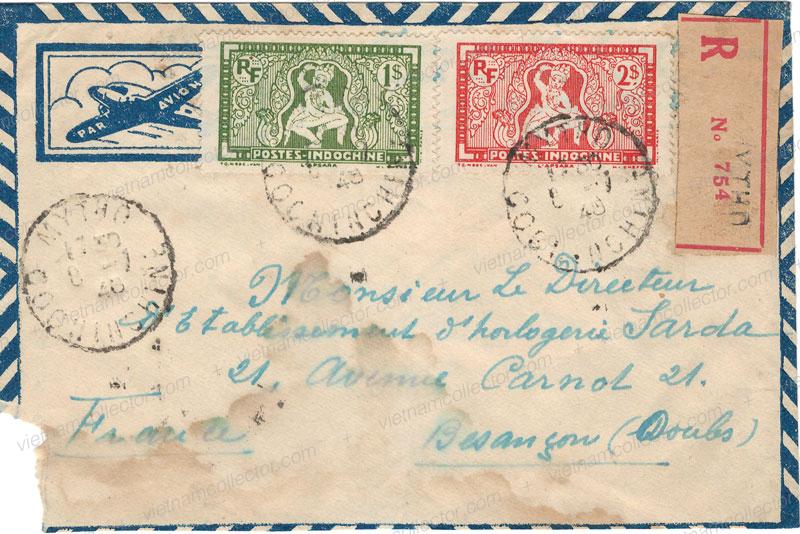
Mixed franking of the 1P and 2P values on a registered international air mail letter sent from Can Tho to France in August of 1949. Saigon transit and Besancon arrival cancel on the reverse.
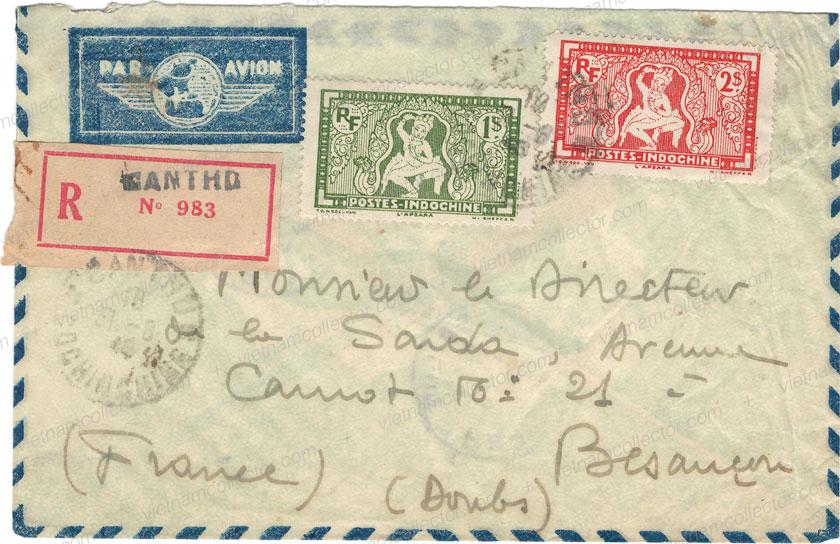
Mixed franking of the 1P and 2P (2) stamps paying an overall postage of 5P on an international air mail letter sent from Saigon to France in June of 1950.
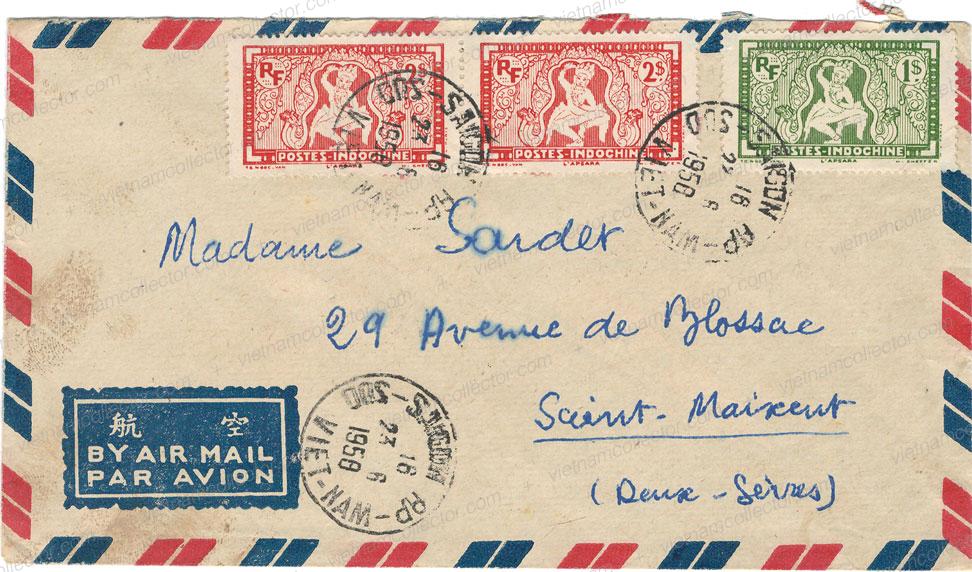
Mixed franking of the 20C (2/rose-carmine) and 2P (2) stamps paying an overall postage of 4.40P on an international air mail letter sent from Saigon to Czechoslovakia in January of 1950.
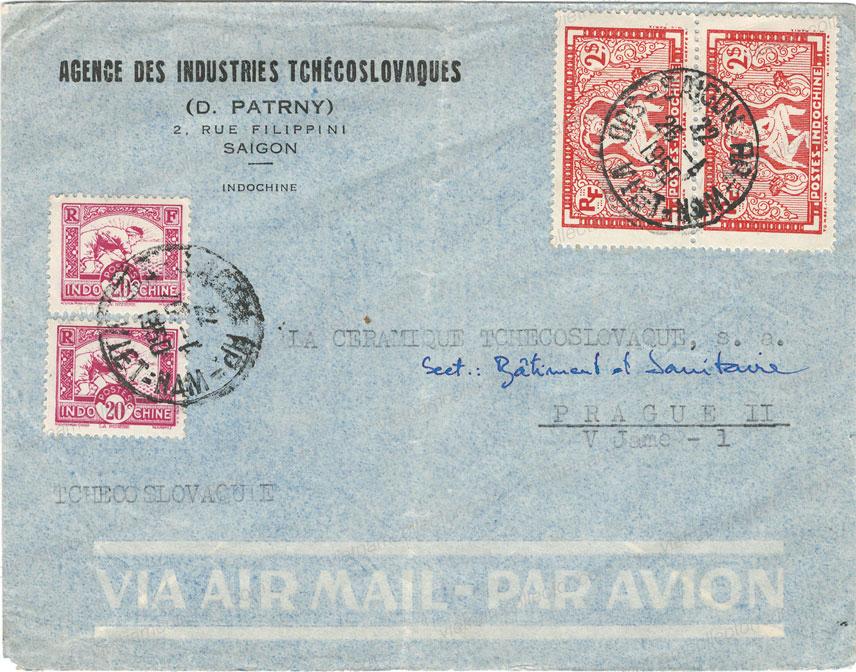
Registration Nr. 090170

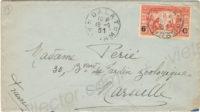

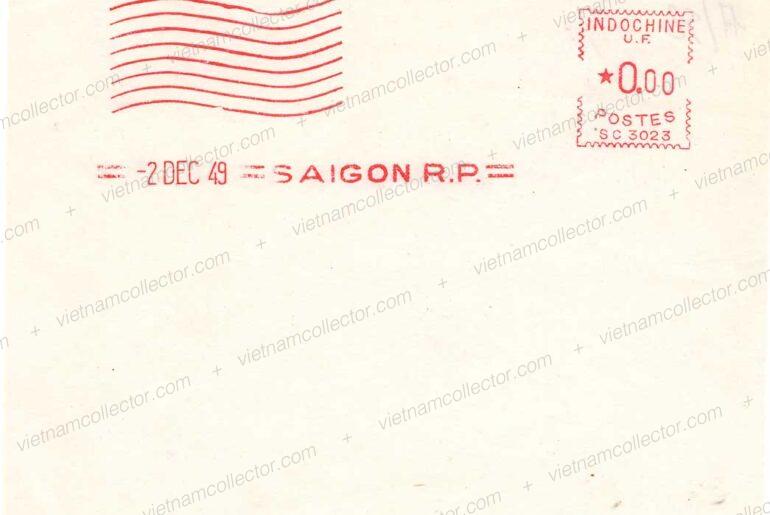
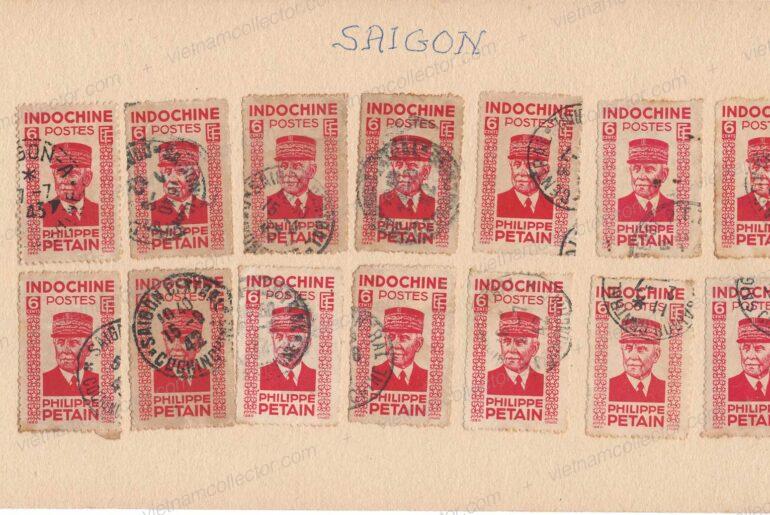
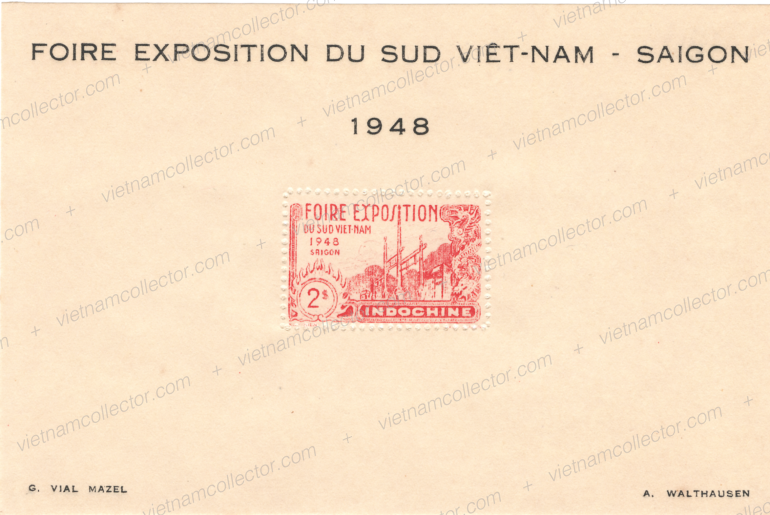
Comments are closed.